The path to psychopathy on serious juvenile delinquency
VerifiedAdded on 2022/08/28
|48
|20992
|10
Assignment
AI Summary
Contribute Materials
Your contribution can guide someone’s learning journey. Share your
documents today.

The path to psychopathy on serious juvenile delinquency: the harmful aftermath of
childhood trauma
childhood trauma
Secure Best Marks with AI Grader
Need help grading? Try our AI Grader for instant feedback on your assignments.
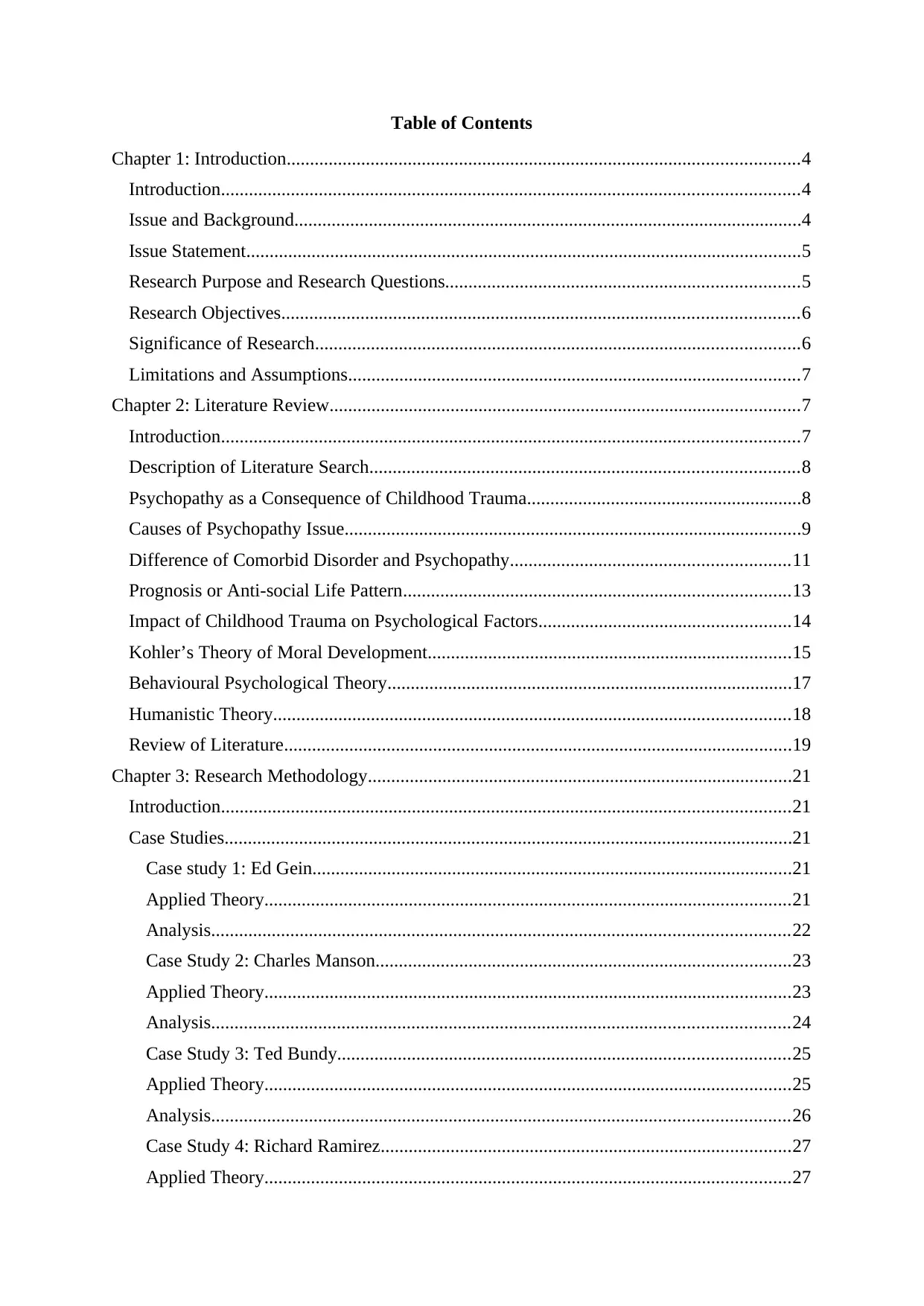
Table of Contents
Chapter 1: Introduction..............................................................................................................4
Introduction............................................................................................................................4
Issue and Background.............................................................................................................4
Issue Statement.......................................................................................................................5
Research Purpose and Research Questions............................................................................5
Research Objectives...............................................................................................................6
Significance of Research........................................................................................................6
Limitations and Assumptions.................................................................................................7
Chapter 2: Literature Review.....................................................................................................7
Introduction............................................................................................................................7
Description of Literature Search............................................................................................8
Psychopathy as a Consequence of Childhood Trauma...........................................................8
Causes of Psychopathy Issue..................................................................................................9
Difference of Comorbid Disorder and Psychopathy............................................................11
Prognosis or Anti-social Life Pattern...................................................................................13
Impact of Childhood Trauma on Psychological Factors......................................................14
Kohler’s Theory of Moral Development..............................................................................15
Behavioural Psychological Theory.......................................................................................17
Humanistic Theory...............................................................................................................18
Review of Literature.............................................................................................................19
Chapter 3: Research Methodology...........................................................................................21
Introduction..........................................................................................................................21
Case Studies..........................................................................................................................21
Case study 1: Ed Gein.......................................................................................................21
Applied Theory.................................................................................................................21
Analysis............................................................................................................................22
Case Study 2: Charles Manson.........................................................................................23
Applied Theory.................................................................................................................23
Analysis............................................................................................................................24
Case Study 3: Ted Bundy.................................................................................................25
Applied Theory.................................................................................................................25
Analysis............................................................................................................................26
Case Study 4: Richard Ramirez........................................................................................27
Applied Theory.................................................................................................................27
Chapter 1: Introduction..............................................................................................................4
Introduction............................................................................................................................4
Issue and Background.............................................................................................................4
Issue Statement.......................................................................................................................5
Research Purpose and Research Questions............................................................................5
Research Objectives...............................................................................................................6
Significance of Research........................................................................................................6
Limitations and Assumptions.................................................................................................7
Chapter 2: Literature Review.....................................................................................................7
Introduction............................................................................................................................7
Description of Literature Search............................................................................................8
Psychopathy as a Consequence of Childhood Trauma...........................................................8
Causes of Psychopathy Issue..................................................................................................9
Difference of Comorbid Disorder and Psychopathy............................................................11
Prognosis or Anti-social Life Pattern...................................................................................13
Impact of Childhood Trauma on Psychological Factors......................................................14
Kohler’s Theory of Moral Development..............................................................................15
Behavioural Psychological Theory.......................................................................................17
Humanistic Theory...............................................................................................................18
Review of Literature.............................................................................................................19
Chapter 3: Research Methodology...........................................................................................21
Introduction..........................................................................................................................21
Case Studies..........................................................................................................................21
Case study 1: Ed Gein.......................................................................................................21
Applied Theory.................................................................................................................21
Analysis............................................................................................................................22
Case Study 2: Charles Manson.........................................................................................23
Applied Theory.................................................................................................................23
Analysis............................................................................................................................24
Case Study 3: Ted Bundy.................................................................................................25
Applied Theory.................................................................................................................25
Analysis............................................................................................................................26
Case Study 4: Richard Ramirez........................................................................................27
Applied Theory.................................................................................................................27
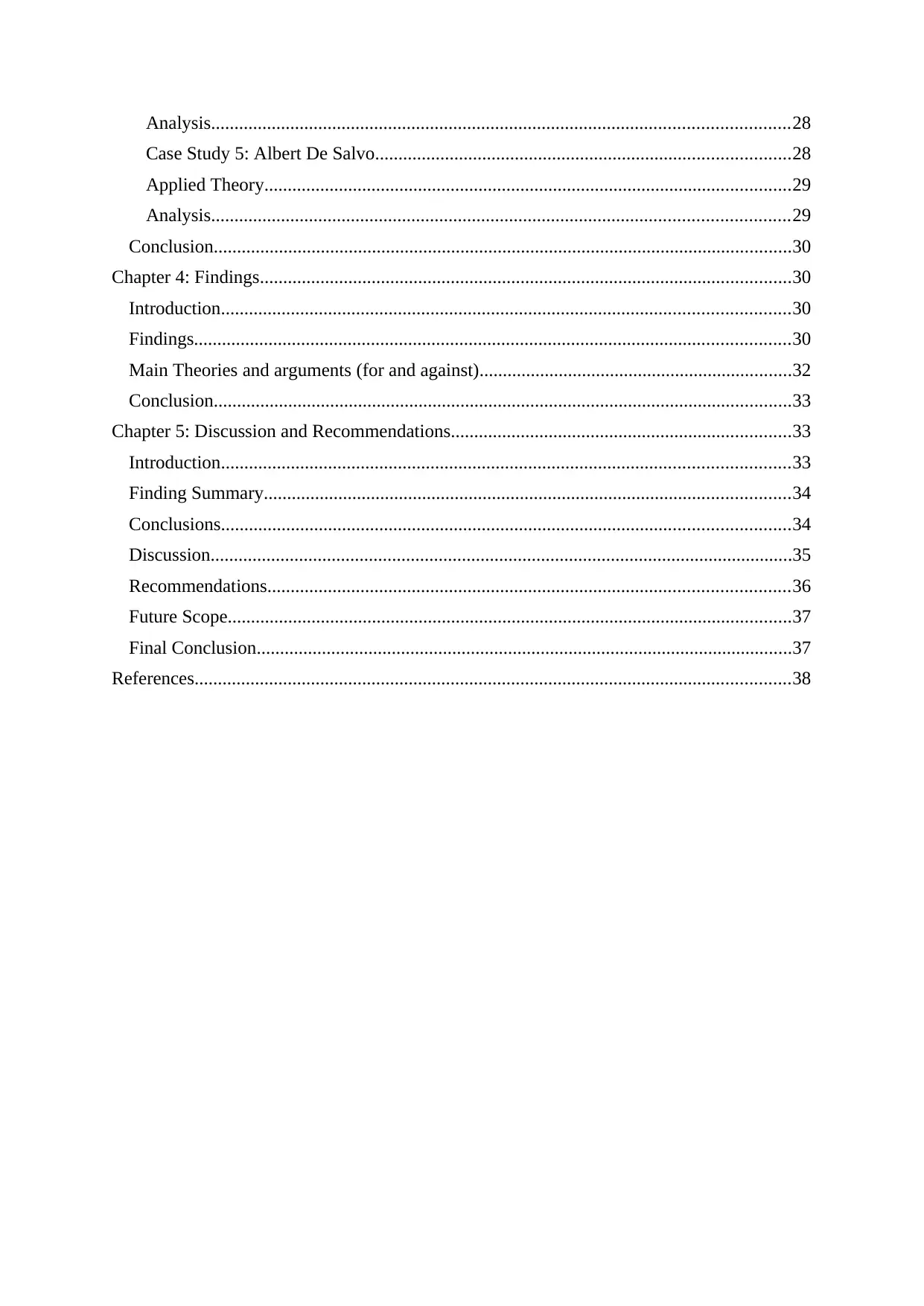
Analysis............................................................................................................................28
Case Study 5: Albert De Salvo.........................................................................................28
Applied Theory.................................................................................................................29
Analysis............................................................................................................................29
Conclusion............................................................................................................................30
Chapter 4: Findings..................................................................................................................30
Introduction..........................................................................................................................30
Findings................................................................................................................................30
Main Theories and arguments (for and against)...................................................................32
Conclusion............................................................................................................................33
Chapter 5: Discussion and Recommendations.........................................................................33
Introduction..........................................................................................................................33
Finding Summary.................................................................................................................34
Conclusions..........................................................................................................................34
Discussion.............................................................................................................................35
Recommendations................................................................................................................36
Future Scope.........................................................................................................................37
Final Conclusion...................................................................................................................37
References................................................................................................................................38
Case Study 5: Albert De Salvo.........................................................................................28
Applied Theory.................................................................................................................29
Analysis............................................................................................................................29
Conclusion............................................................................................................................30
Chapter 4: Findings..................................................................................................................30
Introduction..........................................................................................................................30
Findings................................................................................................................................30
Main Theories and arguments (for and against)...................................................................32
Conclusion............................................................................................................................33
Chapter 5: Discussion and Recommendations.........................................................................33
Introduction..........................................................................................................................33
Finding Summary.................................................................................................................34
Conclusions..........................................................................................................................34
Discussion.............................................................................................................................35
Recommendations................................................................................................................36
Future Scope.........................................................................................................................37
Final Conclusion...................................................................................................................37
References................................................................................................................................38
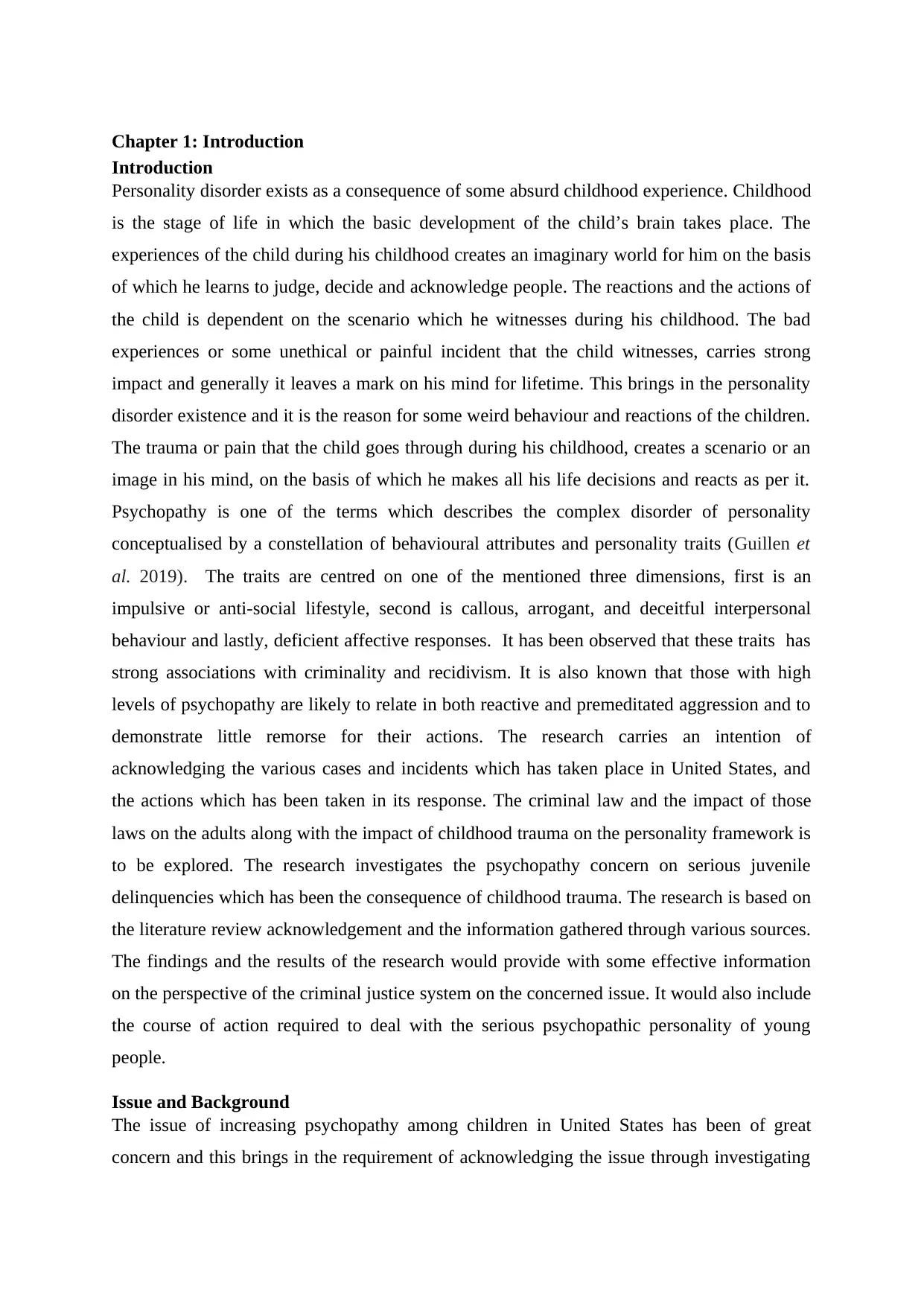
Chapter 1: Introduction
Introduction
Personality disorder exists as a consequence of some absurd childhood experience. Childhood
is the stage of life in which the basic development of the child’s brain takes place. The
experiences of the child during his childhood creates an imaginary world for him on the basis
of which he learns to judge, decide and acknowledge people. The reactions and the actions of
the child is dependent on the scenario which he witnesses during his childhood. The bad
experiences or some unethical or painful incident that the child witnesses, carries strong
impact and generally it leaves a mark on his mind for lifetime. This brings in the personality
disorder existence and it is the reason for some weird behaviour and reactions of the children.
The trauma or pain that the child goes through during his childhood, creates a scenario or an
image in his mind, on the basis of which he makes all his life decisions and reacts as per it.
Psychopathy is one of the terms which describes the complex disorder of personality
conceptualised by a constellation of behavioural attributes and personality traits (Guillen et
al. 2019). The traits are centred on one of the mentioned three dimensions, first is an
impulsive or anti-social lifestyle, second is callous, arrogant, and deceitful interpersonal
behaviour and lastly, deficient affective responses. It has been observed that these traits has
strong associations with criminality and recidivism. It is also known that those with high
levels of psychopathy are likely to relate in both reactive and premeditated aggression and to
demonstrate little remorse for their actions. The research carries an intention of
acknowledging the various cases and incidents which has taken place in United States, and
the actions which has been taken in its response. The criminal law and the impact of those
laws on the adults along with the impact of childhood trauma on the personality framework is
to be explored. The research investigates the psychopathy concern on serious juvenile
delinquencies which has been the consequence of childhood trauma. The research is based on
the literature review acknowledgement and the information gathered through various sources.
The findings and the results of the research would provide with some effective information
on the perspective of the criminal justice system on the concerned issue. It would also include
the course of action required to deal with the serious psychopathic personality of young
people.
Issue and Background
The issue of increasing psychopathy among children in United States has been of great
concern and this brings in the requirement of acknowledging the issue through investigating
Introduction
Personality disorder exists as a consequence of some absurd childhood experience. Childhood
is the stage of life in which the basic development of the child’s brain takes place. The
experiences of the child during his childhood creates an imaginary world for him on the basis
of which he learns to judge, decide and acknowledge people. The reactions and the actions of
the child is dependent on the scenario which he witnesses during his childhood. The bad
experiences or some unethical or painful incident that the child witnesses, carries strong
impact and generally it leaves a mark on his mind for lifetime. This brings in the personality
disorder existence and it is the reason for some weird behaviour and reactions of the children.
The trauma or pain that the child goes through during his childhood, creates a scenario or an
image in his mind, on the basis of which he makes all his life decisions and reacts as per it.
Psychopathy is one of the terms which describes the complex disorder of personality
conceptualised by a constellation of behavioural attributes and personality traits (Guillen et
al. 2019). The traits are centred on one of the mentioned three dimensions, first is an
impulsive or anti-social lifestyle, second is callous, arrogant, and deceitful interpersonal
behaviour and lastly, deficient affective responses. It has been observed that these traits has
strong associations with criminality and recidivism. It is also known that those with high
levels of psychopathy are likely to relate in both reactive and premeditated aggression and to
demonstrate little remorse for their actions. The research carries an intention of
acknowledging the various cases and incidents which has taken place in United States, and
the actions which has been taken in its response. The criminal law and the impact of those
laws on the adults along with the impact of childhood trauma on the personality framework is
to be explored. The research investigates the psychopathy concern on serious juvenile
delinquencies which has been the consequence of childhood trauma. The research is based on
the literature review acknowledgement and the information gathered through various sources.
The findings and the results of the research would provide with some effective information
on the perspective of the criminal justice system on the concerned issue. It would also include
the course of action required to deal with the serious psychopathic personality of young
people.
Issue and Background
The issue of increasing psychopathy among children in United States has been of great
concern and this brings in the requirement of acknowledging the issue through investigating
Secure Best Marks with AI Grader
Need help grading? Try our AI Grader for instant feedback on your assignments.
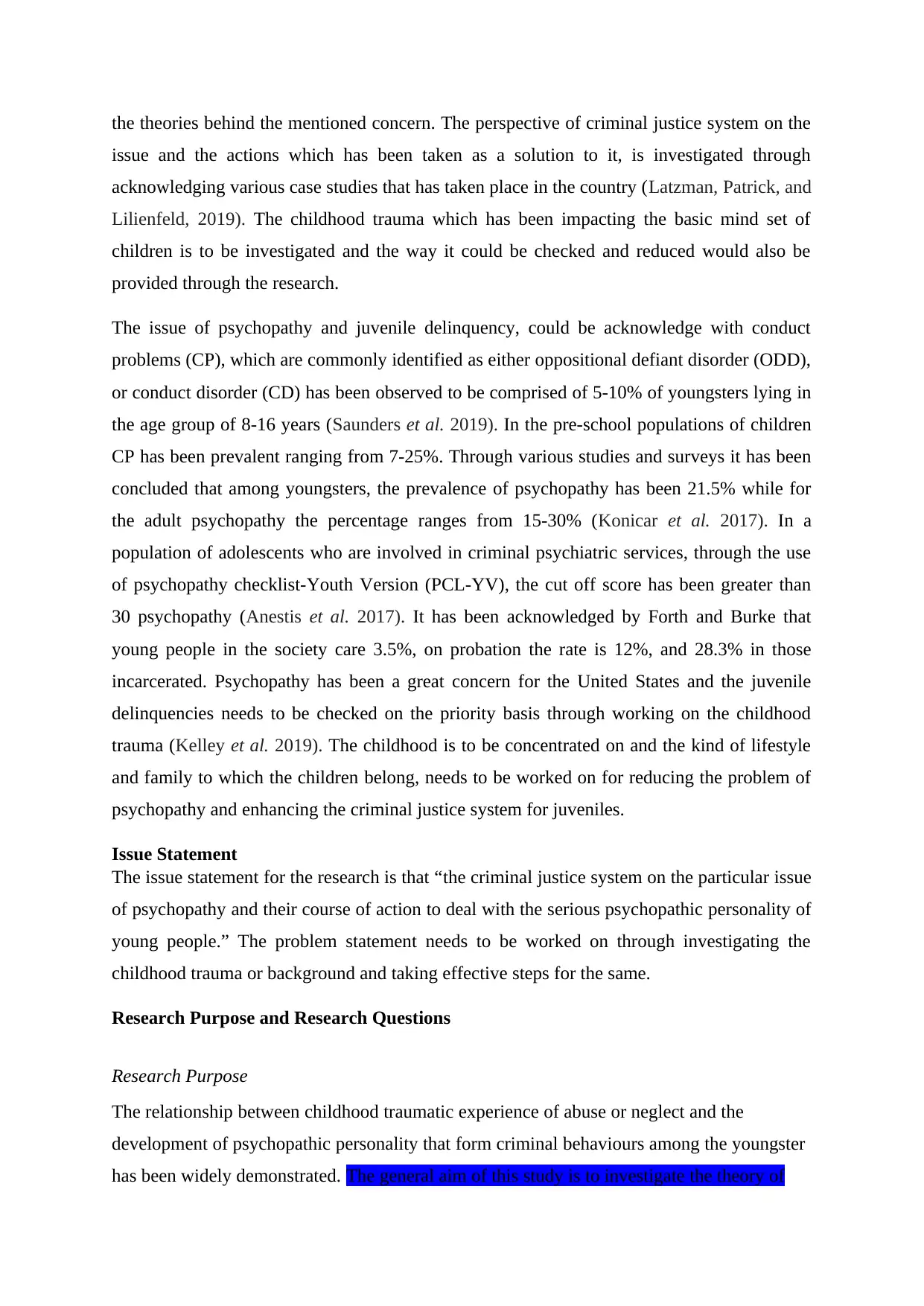
the theories behind the mentioned concern. The perspective of criminal justice system on the
issue and the actions which has been taken as a solution to it, is investigated through
acknowledging various case studies that has taken place in the country (Latzman, Patrick, and
Lilienfeld, 2019). The childhood trauma which has been impacting the basic mind set of
children is to be investigated and the way it could be checked and reduced would also be
provided through the research.
The issue of psychopathy and juvenile delinquency, could be acknowledge with conduct
problems (CP), which are commonly identified as either oppositional defiant disorder (ODD),
or conduct disorder (CD) has been observed to be comprised of 5-10% of youngsters lying in
the age group of 8-16 years (Saunders et al. 2019). In the pre-school populations of children
CP has been prevalent ranging from 7-25%. Through various studies and surveys it has been
concluded that among youngsters, the prevalence of psychopathy has been 21.5% while for
the adult psychopathy the percentage ranges from 15-30% (Konicar et al. 2017). In a
population of adolescents who are involved in criminal psychiatric services, through the use
of psychopathy checklist-Youth Version (PCL-YV), the cut off score has been greater than
30 psychopathy (Anestis et al. 2017). It has been acknowledged by Forth and Burke that
young people in the society care 3.5%, on probation the rate is 12%, and 28.3% in those
incarcerated. Psychopathy has been a great concern for the United States and the juvenile
delinquencies needs to be checked on the priority basis through working on the childhood
trauma (Kelley et al. 2019). The childhood is to be concentrated on and the kind of lifestyle
and family to which the children belong, needs to be worked on for reducing the problem of
psychopathy and enhancing the criminal justice system for juveniles.
Issue Statement
The issue statement for the research is that “the criminal justice system on the particular issue
of psychopathy and their course of action to deal with the serious psychopathic personality of
young people.” The problem statement needs to be worked on through investigating the
childhood trauma or background and taking effective steps for the same.
Research Purpose and Research Questions
Research Purpose
The relationship between childhood traumatic experience of abuse or neglect and the
development of psychopathic personality that form criminal behaviours among the youngster
has been widely demonstrated. The general aim of this study is to investigate the theory of
issue and the actions which has been taken as a solution to it, is investigated through
acknowledging various case studies that has taken place in the country (Latzman, Patrick, and
Lilienfeld, 2019). The childhood trauma which has been impacting the basic mind set of
children is to be investigated and the way it could be checked and reduced would also be
provided through the research.
The issue of psychopathy and juvenile delinquency, could be acknowledge with conduct
problems (CP), which are commonly identified as either oppositional defiant disorder (ODD),
or conduct disorder (CD) has been observed to be comprised of 5-10% of youngsters lying in
the age group of 8-16 years (Saunders et al. 2019). In the pre-school populations of children
CP has been prevalent ranging from 7-25%. Through various studies and surveys it has been
concluded that among youngsters, the prevalence of psychopathy has been 21.5% while for
the adult psychopathy the percentage ranges from 15-30% (Konicar et al. 2017). In a
population of adolescents who are involved in criminal psychiatric services, through the use
of psychopathy checklist-Youth Version (PCL-YV), the cut off score has been greater than
30 psychopathy (Anestis et al. 2017). It has been acknowledged by Forth and Burke that
young people in the society care 3.5%, on probation the rate is 12%, and 28.3% in those
incarcerated. Psychopathy has been a great concern for the United States and the juvenile
delinquencies needs to be checked on the priority basis through working on the childhood
trauma (Kelley et al. 2019). The childhood is to be concentrated on and the kind of lifestyle
and family to which the children belong, needs to be worked on for reducing the problem of
psychopathy and enhancing the criminal justice system for juveniles.
Issue Statement
The issue statement for the research is that “the criminal justice system on the particular issue
of psychopathy and their course of action to deal with the serious psychopathic personality of
young people.” The problem statement needs to be worked on through investigating the
childhood trauma or background and taking effective steps for the same.
Research Purpose and Research Questions
Research Purpose
The relationship between childhood traumatic experience of abuse or neglect and the
development of psychopathic personality that form criminal behaviours among the youngster
has been widely demonstrated. The general aim of this study is to investigate the theory of
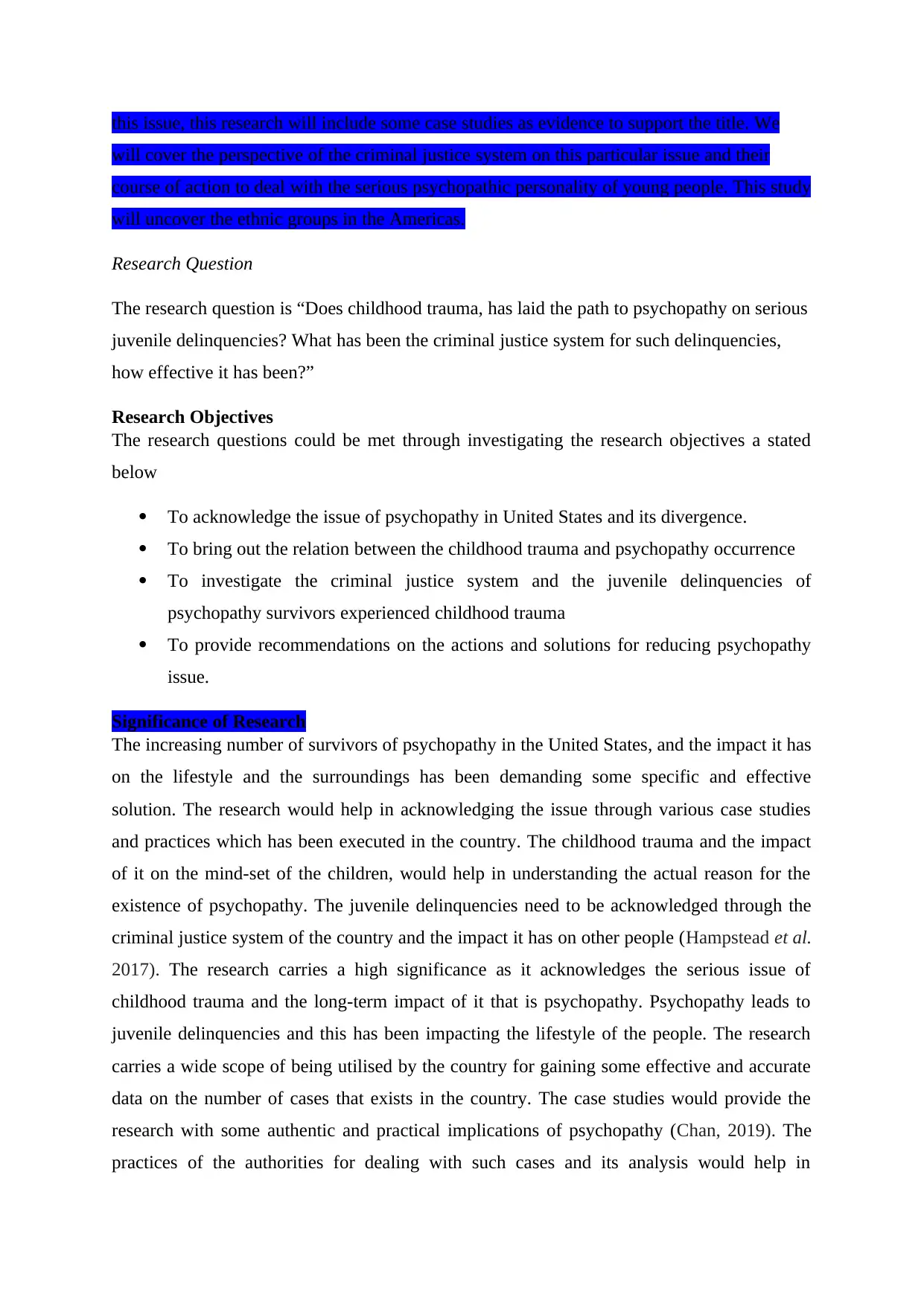
this issue, this research will include some case studies as evidence to support the title. We
will cover the perspective of the criminal justice system on this particular issue and their
course of action to deal with the serious psychopathic personality of young people. This study
will uncover the ethnic groups in the Americas.
Research Question
The research question is “Does childhood trauma, has laid the path to psychopathy on serious
juvenile delinquencies? What has been the criminal justice system for such delinquencies,
how effective it has been?”
Research Objectives
The research questions could be met through investigating the research objectives a stated
below
To acknowledge the issue of psychopathy in United States and its divergence.
To bring out the relation between the childhood trauma and psychopathy occurrence
To investigate the criminal justice system and the juvenile delinquencies of
psychopathy survivors experienced childhood trauma
To provide recommendations on the actions and solutions for reducing psychopathy
issue.
Significance of Research
The increasing number of survivors of psychopathy in the United States, and the impact it has
on the lifestyle and the surroundings has been demanding some specific and effective
solution. The research would help in acknowledging the issue through various case studies
and practices which has been executed in the country. The childhood trauma and the impact
of it on the mind-set of the children, would help in understanding the actual reason for the
existence of psychopathy. The juvenile delinquencies need to be acknowledged through the
criminal justice system of the country and the impact it has on other people (Hampstead et al.
2017). The research carries a high significance as it acknowledges the serious issue of
childhood trauma and the long-term impact of it that is psychopathy. Psychopathy leads to
juvenile delinquencies and this has been impacting the lifestyle of the people. The research
carries a wide scope of being utilised by the country for gaining some effective and accurate
data on the number of cases that exists in the country. The case studies would provide the
research with some authentic and practical implications of psychopathy (Chan, 2019). The
practices of the authorities for dealing with such cases and its analysis would help in
will cover the perspective of the criminal justice system on this particular issue and their
course of action to deal with the serious psychopathic personality of young people. This study
will uncover the ethnic groups in the Americas.
Research Question
The research question is “Does childhood trauma, has laid the path to psychopathy on serious
juvenile delinquencies? What has been the criminal justice system for such delinquencies,
how effective it has been?”
Research Objectives
The research questions could be met through investigating the research objectives a stated
below
To acknowledge the issue of psychopathy in United States and its divergence.
To bring out the relation between the childhood trauma and psychopathy occurrence
To investigate the criminal justice system and the juvenile delinquencies of
psychopathy survivors experienced childhood trauma
To provide recommendations on the actions and solutions for reducing psychopathy
issue.
Significance of Research
The increasing number of survivors of psychopathy in the United States, and the impact it has
on the lifestyle and the surroundings has been demanding some specific and effective
solution. The research would help in acknowledging the issue through various case studies
and practices which has been executed in the country. The childhood trauma and the impact
of it on the mind-set of the children, would help in understanding the actual reason for the
existence of psychopathy. The juvenile delinquencies need to be acknowledged through the
criminal justice system of the country and the impact it has on other people (Hampstead et al.
2017). The research carries a high significance as it acknowledges the serious issue of
childhood trauma and the long-term impact of it that is psychopathy. Psychopathy leads to
juvenile delinquencies and this has been impacting the lifestyle of the people. The research
carries a wide scope of being utilised by the country for gaining some effective and accurate
data on the number of cases that exists in the country. The case studies would provide the
research with some authentic and practical implications of psychopathy (Chan, 2019). The
practices of the authorities for dealing with such cases and its analysis would help in
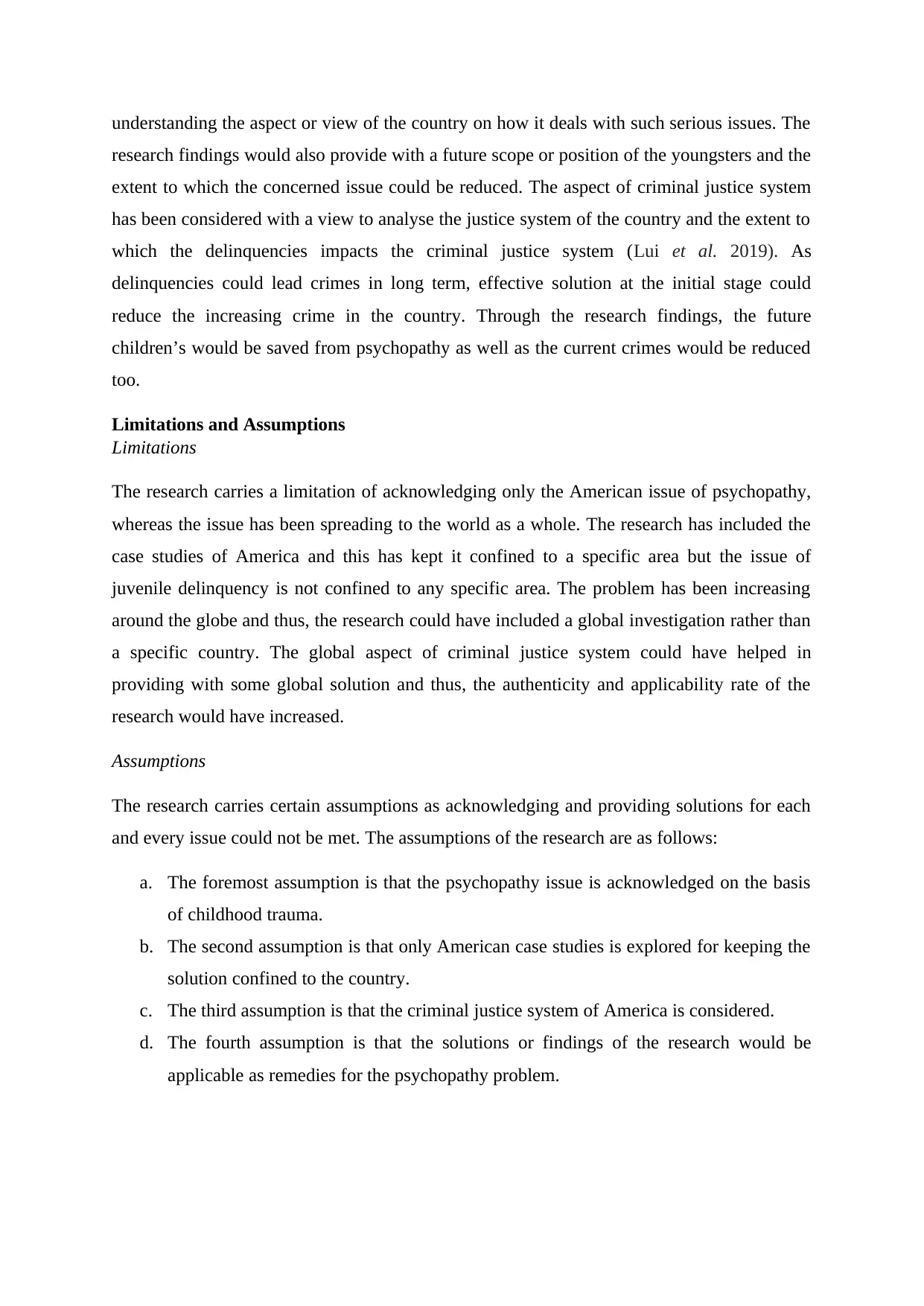
understanding the aspect or view of the country on how it deals with such serious issues. The
research findings would also provide with a future scope or position of the youngsters and the
extent to which the concerned issue could be reduced. The aspect of criminal justice system
has been considered with a view to analyse the justice system of the country and the extent to
which the delinquencies impacts the criminal justice system (Lui et al. 2019). As
delinquencies could lead crimes in long term, effective solution at the initial stage could
reduce the increasing crime in the country. Through the research findings, the future
children’s would be saved from psychopathy as well as the current crimes would be reduced
too.
Limitations and Assumptions
Limitations
The research carries a limitation of acknowledging only the American issue of psychopathy,
whereas the issue has been spreading to the world as a whole. The research has included the
case studies of America and this has kept it confined to a specific area but the issue of
juvenile delinquency is not confined to any specific area. The problem has been increasing
around the globe and thus, the research could have included a global investigation rather than
a specific country. The global aspect of criminal justice system could have helped in
providing with some global solution and thus, the authenticity and applicability rate of the
research would have increased.
Assumptions
The research carries certain assumptions as acknowledging and providing solutions for each
and every issue could not be met. The assumptions of the research are as follows:
a. The foremost assumption is that the psychopathy issue is acknowledged on the basis
of childhood trauma.
b. The second assumption is that only American case studies is explored for keeping the
solution confined to the country.
c. The third assumption is that the criminal justice system of America is considered.
d. The fourth assumption is that the solutions or findings of the research would be
applicable as remedies for the psychopathy problem.
research findings would also provide with a future scope or position of the youngsters and the
extent to which the concerned issue could be reduced. The aspect of criminal justice system
has been considered with a view to analyse the justice system of the country and the extent to
which the delinquencies impacts the criminal justice system (Lui et al. 2019). As
delinquencies could lead crimes in long term, effective solution at the initial stage could
reduce the increasing crime in the country. Through the research findings, the future
children’s would be saved from psychopathy as well as the current crimes would be reduced
too.
Limitations and Assumptions
Limitations
The research carries a limitation of acknowledging only the American issue of psychopathy,
whereas the issue has been spreading to the world as a whole. The research has included the
case studies of America and this has kept it confined to a specific area but the issue of
juvenile delinquency is not confined to any specific area. The problem has been increasing
around the globe and thus, the research could have included a global investigation rather than
a specific country. The global aspect of criminal justice system could have helped in
providing with some global solution and thus, the authenticity and applicability rate of the
research would have increased.
Assumptions
The research carries certain assumptions as acknowledging and providing solutions for each
and every issue could not be met. The assumptions of the research are as follows:
a. The foremost assumption is that the psychopathy issue is acknowledged on the basis
of childhood trauma.
b. The second assumption is that only American case studies is explored for keeping the
solution confined to the country.
c. The third assumption is that the criminal justice system of America is considered.
d. The fourth assumption is that the solutions or findings of the research would be
applicable as remedies for the psychopathy problem.
Paraphrase This Document
Need a fresh take? Get an instant paraphrase of this document with our AI Paraphraser
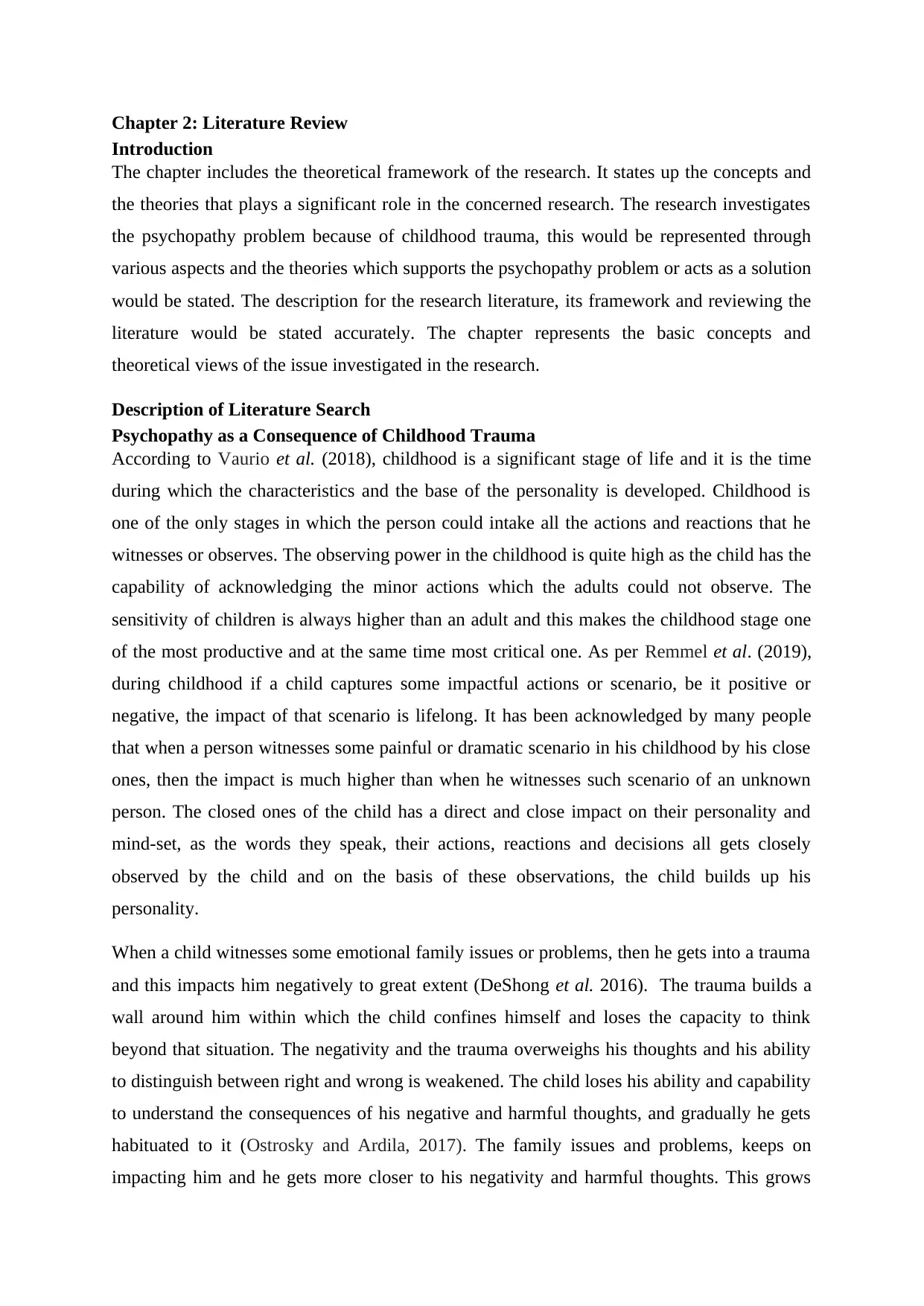
Chapter 2: Literature Review
Introduction
The chapter includes the theoretical framework of the research. It states up the concepts and
the theories that plays a significant role in the concerned research. The research investigates
the psychopathy problem because of childhood trauma, this would be represented through
various aspects and the theories which supports the psychopathy problem or acts as a solution
would be stated. The description for the research literature, its framework and reviewing the
literature would be stated accurately. The chapter represents the basic concepts and
theoretical views of the issue investigated in the research.
Description of Literature Search
Psychopathy as a Consequence of Childhood Trauma
According to Vaurio et al. (2018), childhood is a significant stage of life and it is the time
during which the characteristics and the base of the personality is developed. Childhood is
one of the only stages in which the person could intake all the actions and reactions that he
witnesses or observes. The observing power in the childhood is quite high as the child has the
capability of acknowledging the minor actions which the adults could not observe. The
sensitivity of children is always higher than an adult and this makes the childhood stage one
of the most productive and at the same time most critical one. As per Remmel et al. (2019),
during childhood if a child captures some impactful actions or scenario, be it positive or
negative, the impact of that scenario is lifelong. It has been acknowledged by many people
that when a person witnesses some painful or dramatic scenario in his childhood by his close
ones, then the impact is much higher than when he witnesses such scenario of an unknown
person. The closed ones of the child has a direct and close impact on their personality and
mind-set, as the words they speak, their actions, reactions and decisions all gets closely
observed by the child and on the basis of these observations, the child builds up his
personality.
When a child witnesses some emotional family issues or problems, then he gets into a trauma
and this impacts him negatively to great extent (DeShong et al. 2016). The trauma builds a
wall around him within which the child confines himself and loses the capacity to think
beyond that situation. The negativity and the trauma overweighs his thoughts and his ability
to distinguish between right and wrong is weakened. The child loses his ability and capability
to understand the consequences of his negative and harmful thoughts, and gradually he gets
habituated to it (Ostrosky and Ardila, 2017). The family issues and problems, keeps on
impacting him and he gets more closer to his negativity and harmful thoughts. This grows
Introduction
The chapter includes the theoretical framework of the research. It states up the concepts and
the theories that plays a significant role in the concerned research. The research investigates
the psychopathy problem because of childhood trauma, this would be represented through
various aspects and the theories which supports the psychopathy problem or acts as a solution
would be stated. The description for the research literature, its framework and reviewing the
literature would be stated accurately. The chapter represents the basic concepts and
theoretical views of the issue investigated in the research.
Description of Literature Search
Psychopathy as a Consequence of Childhood Trauma
According to Vaurio et al. (2018), childhood is a significant stage of life and it is the time
during which the characteristics and the base of the personality is developed. Childhood is
one of the only stages in which the person could intake all the actions and reactions that he
witnesses or observes. The observing power in the childhood is quite high as the child has the
capability of acknowledging the minor actions which the adults could not observe. The
sensitivity of children is always higher than an adult and this makes the childhood stage one
of the most productive and at the same time most critical one. As per Remmel et al. (2019),
during childhood if a child captures some impactful actions or scenario, be it positive or
negative, the impact of that scenario is lifelong. It has been acknowledged by many people
that when a person witnesses some painful or dramatic scenario in his childhood by his close
ones, then the impact is much higher than when he witnesses such scenario of an unknown
person. The closed ones of the child has a direct and close impact on their personality and
mind-set, as the words they speak, their actions, reactions and decisions all gets closely
observed by the child and on the basis of these observations, the child builds up his
personality.
When a child witnesses some emotional family issues or problems, then he gets into a trauma
and this impacts him negatively to great extent (DeShong et al. 2016). The trauma builds a
wall around him within which the child confines himself and loses the capacity to think
beyond that situation. The negativity and the trauma overweighs his thoughts and his ability
to distinguish between right and wrong is weakened. The child loses his ability and capability
to understand the consequences of his negative and harmful thoughts, and gradually he gets
habituated to it (Ostrosky and Ardila, 2017). The family issues and problems, keeps on
impacting him and he gets more closer to his negativity and harmful thoughts. This grows
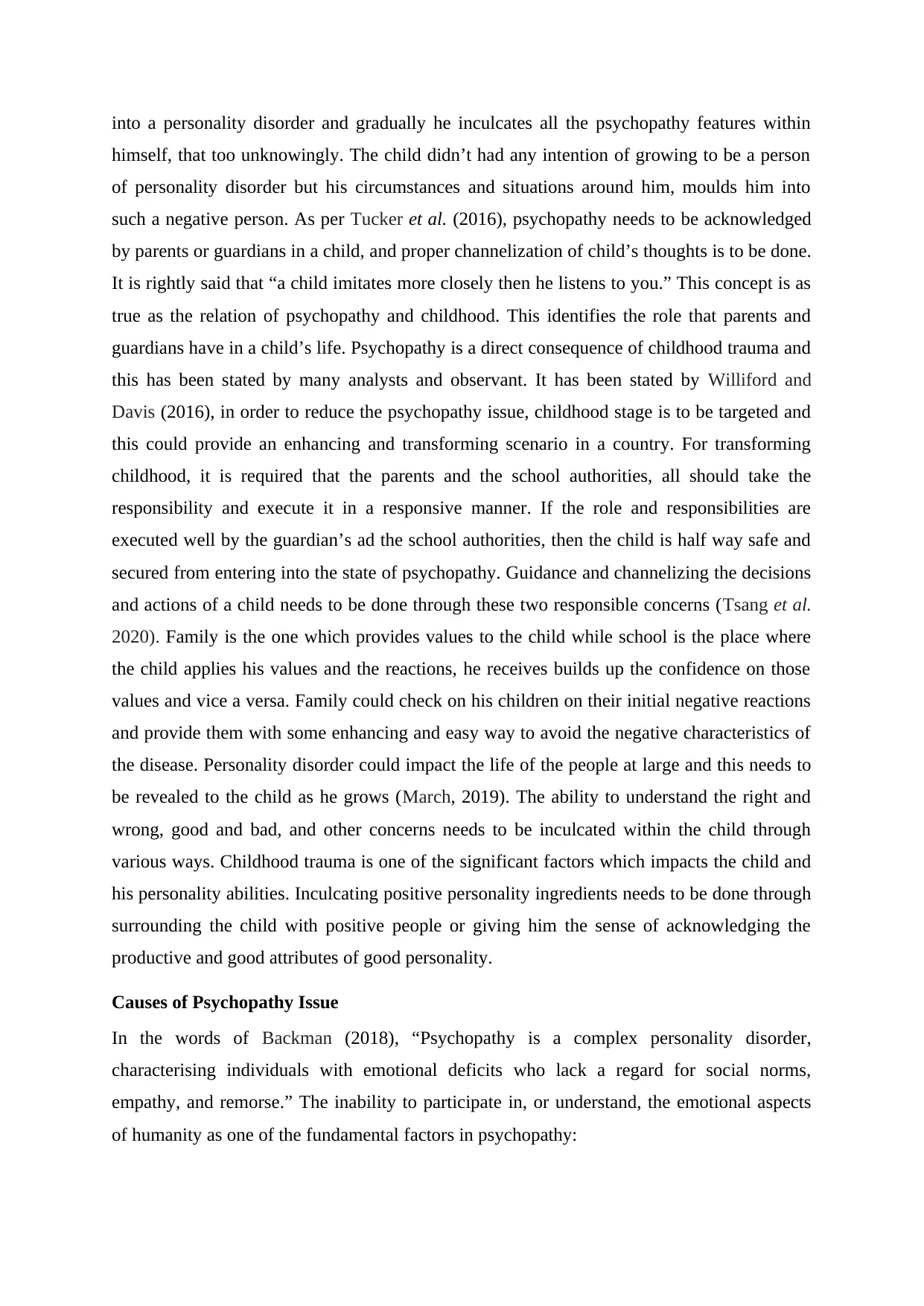
into a personality disorder and gradually he inculcates all the psychopathy features within
himself, that too unknowingly. The child didn’t had any intention of growing to be a person
of personality disorder but his circumstances and situations around him, moulds him into
such a negative person. As per Tucker et al. (2016), psychopathy needs to be acknowledged
by parents or guardians in a child, and proper channelization of child’s thoughts is to be done.
It is rightly said that “a child imitates more closely then he listens to you.” This concept is as
true as the relation of psychopathy and childhood. This identifies the role that parents and
guardians have in a child’s life. Psychopathy is a direct consequence of childhood trauma and
this has been stated by many analysts and observant. It has been stated by Williford and
Davis (2016), in order to reduce the psychopathy issue, childhood stage is to be targeted and
this could provide an enhancing and transforming scenario in a country. For transforming
childhood, it is required that the parents and the school authorities, all should take the
responsibility and execute it in a responsive manner. If the role and responsibilities are
executed well by the guardian’s ad the school authorities, then the child is half way safe and
secured from entering into the state of psychopathy. Guidance and channelizing the decisions
and actions of a child needs to be done through these two responsible concerns (Tsang et al.
2020). Family is the one which provides values to the child while school is the place where
the child applies his values and the reactions, he receives builds up the confidence on those
values and vice a versa. Family could check on his children on their initial negative reactions
and provide them with some enhancing and easy way to avoid the negative characteristics of
the disease. Personality disorder could impact the life of the people at large and this needs to
be revealed to the child as he grows (March, 2019). The ability to understand the right and
wrong, good and bad, and other concerns needs to be inculcated within the child through
various ways. Childhood trauma is one of the significant factors which impacts the child and
his personality abilities. Inculcating positive personality ingredients needs to be done through
surrounding the child with positive people or giving him the sense of acknowledging the
productive and good attributes of good personality.
Causes of Psychopathy Issue
In the words of Backman (2018), “Psychopathy is a complex personality disorder,
characterising individuals with emotional deficits who lack a regard for social norms,
empathy, and remorse.” The inability to participate in, or understand, the emotional aspects
of humanity as one of the fundamental factors in psychopathy:
himself, that too unknowingly. The child didn’t had any intention of growing to be a person
of personality disorder but his circumstances and situations around him, moulds him into
such a negative person. As per Tucker et al. (2016), psychopathy needs to be acknowledged
by parents or guardians in a child, and proper channelization of child’s thoughts is to be done.
It is rightly said that “a child imitates more closely then he listens to you.” This concept is as
true as the relation of psychopathy and childhood. This identifies the role that parents and
guardians have in a child’s life. Psychopathy is a direct consequence of childhood trauma and
this has been stated by many analysts and observant. It has been stated by Williford and
Davis (2016), in order to reduce the psychopathy issue, childhood stage is to be targeted and
this could provide an enhancing and transforming scenario in a country. For transforming
childhood, it is required that the parents and the school authorities, all should take the
responsibility and execute it in a responsive manner. If the role and responsibilities are
executed well by the guardian’s ad the school authorities, then the child is half way safe and
secured from entering into the state of psychopathy. Guidance and channelizing the decisions
and actions of a child needs to be done through these two responsible concerns (Tsang et al.
2020). Family is the one which provides values to the child while school is the place where
the child applies his values and the reactions, he receives builds up the confidence on those
values and vice a versa. Family could check on his children on their initial negative reactions
and provide them with some enhancing and easy way to avoid the negative characteristics of
the disease. Personality disorder could impact the life of the people at large and this needs to
be revealed to the child as he grows (March, 2019). The ability to understand the right and
wrong, good and bad, and other concerns needs to be inculcated within the child through
various ways. Childhood trauma is one of the significant factors which impacts the child and
his personality abilities. Inculcating positive personality ingredients needs to be done through
surrounding the child with positive people or giving him the sense of acknowledging the
productive and good attributes of good personality.
Causes of Psychopathy Issue
In the words of Backman (2018), “Psychopathy is a complex personality disorder,
characterising individuals with emotional deficits who lack a regard for social norms,
empathy, and remorse.” The inability to participate in, or understand, the emotional aspects
of humanity as one of the fundamental factors in psychopathy:
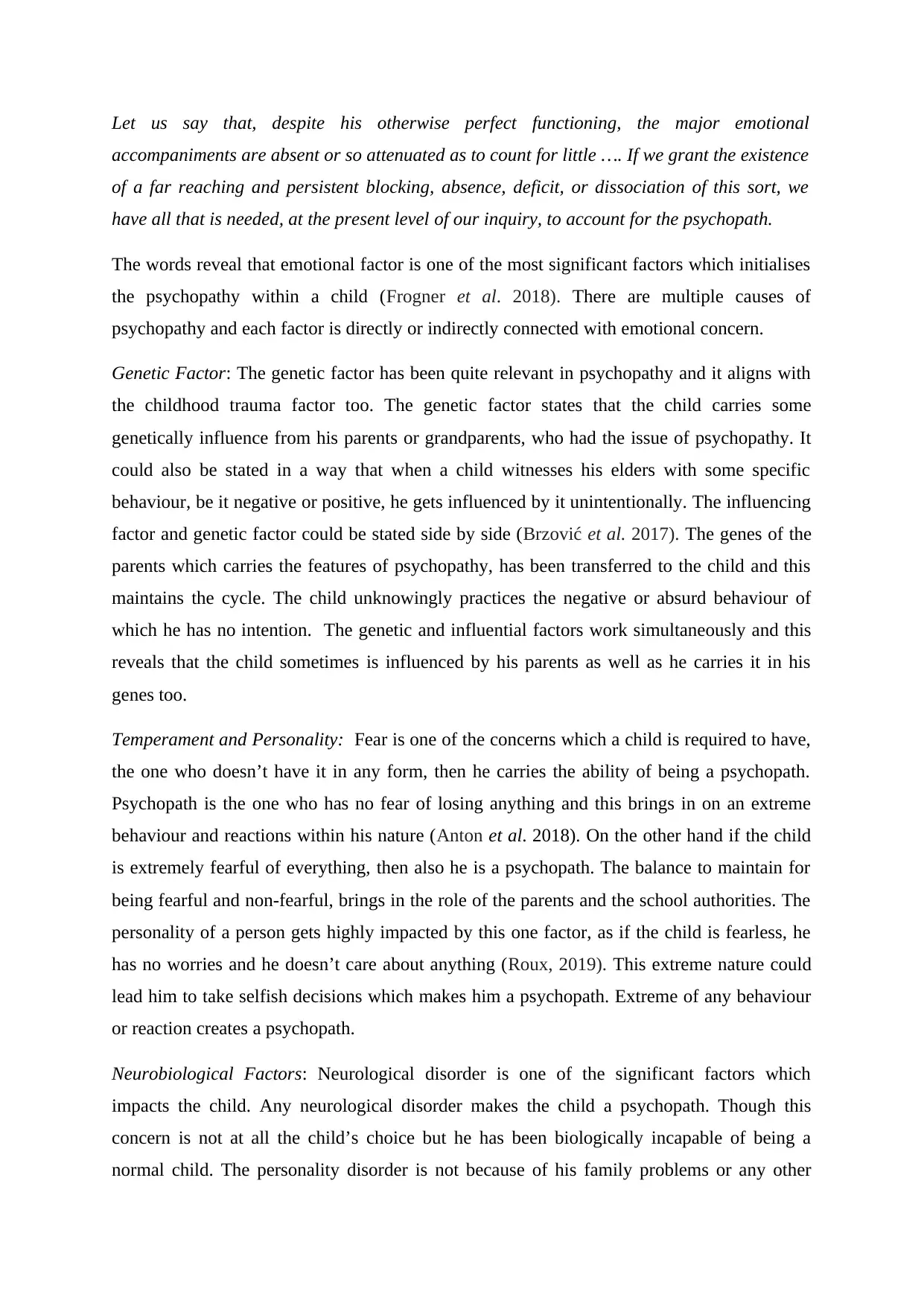
Let us say that, despite his otherwise perfect functioning, the major emotional
accompaniments are absent or so attenuated as to count for little …. If we grant the existence
of a far reaching and persistent blocking, absence, deficit, or dissociation of this sort, we
have all that is needed, at the present level of our inquiry, to account for the psychopath.
The words reveal that emotional factor is one of the most significant factors which initialises
the psychopathy within a child (Frogner et al. 2018). There are multiple causes of
psychopathy and each factor is directly or indirectly connected with emotional concern.
Genetic Factor: The genetic factor has been quite relevant in psychopathy and it aligns with
the childhood trauma factor too. The genetic factor states that the child carries some
genetically influence from his parents or grandparents, who had the issue of psychopathy. It
could also be stated in a way that when a child witnesses his elders with some specific
behaviour, be it negative or positive, he gets influenced by it unintentionally. The influencing
factor and genetic factor could be stated side by side (Brzović et al. 2017). The genes of the
parents which carries the features of psychopathy, has been transferred to the child and this
maintains the cycle. The child unknowingly practices the negative or absurd behaviour of
which he has no intention. The genetic and influential factors work simultaneously and this
reveals that the child sometimes is influenced by his parents as well as he carries it in his
genes too.
Temperament and Personality: Fear is one of the concerns which a child is required to have,
the one who doesn’t have it in any form, then he carries the ability of being a psychopath.
Psychopath is the one who has no fear of losing anything and this brings in on an extreme
behaviour and reactions within his nature (Anton et al. 2018). On the other hand if the child
is extremely fearful of everything, then also he is a psychopath. The balance to maintain for
being fearful and non-fearful, brings in the role of the parents and the school authorities. The
personality of a person gets highly impacted by this one factor, as if the child is fearless, he
has no worries and he doesn’t care about anything (Roux, 2019). This extreme nature could
lead him to take selfish decisions which makes him a psychopath. Extreme of any behaviour
or reaction creates a psychopath.
Neurobiological Factors: Neurological disorder is one of the significant factors which
impacts the child. Any neurological disorder makes the child a psychopath. Though this
concern is not at all the child’s choice but he has been biologically incapable of being a
normal child. The personality disorder is not because of his family problems or any other
accompaniments are absent or so attenuated as to count for little …. If we grant the existence
of a far reaching and persistent blocking, absence, deficit, or dissociation of this sort, we
have all that is needed, at the present level of our inquiry, to account for the psychopath.
The words reveal that emotional factor is one of the most significant factors which initialises
the psychopathy within a child (Frogner et al. 2018). There are multiple causes of
psychopathy and each factor is directly or indirectly connected with emotional concern.
Genetic Factor: The genetic factor has been quite relevant in psychopathy and it aligns with
the childhood trauma factor too. The genetic factor states that the child carries some
genetically influence from his parents or grandparents, who had the issue of psychopathy. It
could also be stated in a way that when a child witnesses his elders with some specific
behaviour, be it negative or positive, he gets influenced by it unintentionally. The influencing
factor and genetic factor could be stated side by side (Brzović et al. 2017). The genes of the
parents which carries the features of psychopathy, has been transferred to the child and this
maintains the cycle. The child unknowingly practices the negative or absurd behaviour of
which he has no intention. The genetic and influential factors work simultaneously and this
reveals that the child sometimes is influenced by his parents as well as he carries it in his
genes too.
Temperament and Personality: Fear is one of the concerns which a child is required to have,
the one who doesn’t have it in any form, then he carries the ability of being a psychopath.
Psychopath is the one who has no fear of losing anything and this brings in on an extreme
behaviour and reactions within his nature (Anton et al. 2018). On the other hand if the child
is extremely fearful of everything, then also he is a psychopath. The balance to maintain for
being fearful and non-fearful, brings in the role of the parents and the school authorities. The
personality of a person gets highly impacted by this one factor, as if the child is fearless, he
has no worries and he doesn’t care about anything (Roux, 2019). This extreme nature could
lead him to take selfish decisions which makes him a psychopath. Extreme of any behaviour
or reaction creates a psychopath.
Neurobiological Factors: Neurological disorder is one of the significant factors which
impacts the child. Any neurological disorder makes the child a psychopath. Though this
concern is not at all the child’s choice but he has been biologically incapable of being a
normal child. The personality disorder is not because of his family problems or any other
Secure Best Marks with AI Grader
Need help grading? Try our AI Grader for instant feedback on your assignments.
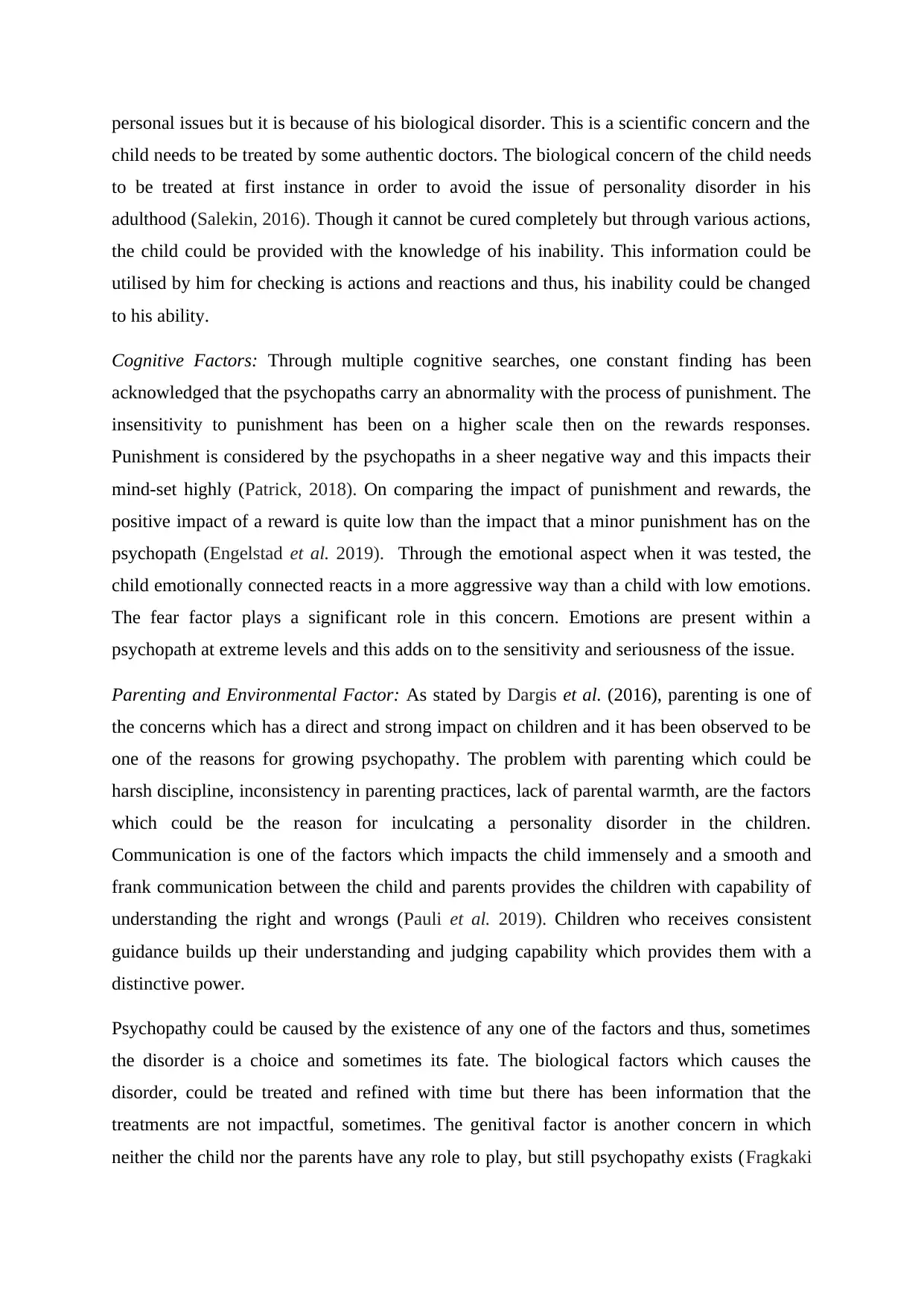
personal issues but it is because of his biological disorder. This is a scientific concern and the
child needs to be treated by some authentic doctors. The biological concern of the child needs
to be treated at first instance in order to avoid the issue of personality disorder in his
adulthood (Salekin, 2016). Though it cannot be cured completely but through various actions,
the child could be provided with the knowledge of his inability. This information could be
utilised by him for checking is actions and reactions and thus, his inability could be changed
to his ability.
Cognitive Factors: Through multiple cognitive searches, one constant finding has been
acknowledged that the psychopaths carry an abnormality with the process of punishment. The
insensitivity to punishment has been on a higher scale then on the rewards responses.
Punishment is considered by the psychopaths in a sheer negative way and this impacts their
mind-set highly (Patrick, 2018). On comparing the impact of punishment and rewards, the
positive impact of a reward is quite low than the impact that a minor punishment has on the
psychopath (Engelstad et al. 2019). Through the emotional aspect when it was tested, the
child emotionally connected reacts in a more aggressive way than a child with low emotions.
The fear factor plays a significant role in this concern. Emotions are present within a
psychopath at extreme levels and this adds on to the sensitivity and seriousness of the issue.
Parenting and Environmental Factor: As stated by Dargis et al. (2016), parenting is one of
the concerns which has a direct and strong impact on children and it has been observed to be
one of the reasons for growing psychopathy. The problem with parenting which could be
harsh discipline, inconsistency in parenting practices, lack of parental warmth, are the factors
which could be the reason for inculcating a personality disorder in the children.
Communication is one of the factors which impacts the child immensely and a smooth and
frank communication between the child and parents provides the children with capability of
understanding the right and wrongs (Pauli et al. 2019). Children who receives consistent
guidance builds up their understanding and judging capability which provides them with a
distinctive power.
Psychopathy could be caused by the existence of any one of the factors and thus, sometimes
the disorder is a choice and sometimes its fate. The biological factors which causes the
disorder, could be treated and refined with time but there has been information that the
treatments are not impactful, sometimes. The genitival factor is another concern in which
neither the child nor the parents have any role to play, but still psychopathy exists (Fragkaki
child needs to be treated by some authentic doctors. The biological concern of the child needs
to be treated at first instance in order to avoid the issue of personality disorder in his
adulthood (Salekin, 2016). Though it cannot be cured completely but through various actions,
the child could be provided with the knowledge of his inability. This information could be
utilised by him for checking is actions and reactions and thus, his inability could be changed
to his ability.
Cognitive Factors: Through multiple cognitive searches, one constant finding has been
acknowledged that the psychopaths carry an abnormality with the process of punishment. The
insensitivity to punishment has been on a higher scale then on the rewards responses.
Punishment is considered by the psychopaths in a sheer negative way and this impacts their
mind-set highly (Patrick, 2018). On comparing the impact of punishment and rewards, the
positive impact of a reward is quite low than the impact that a minor punishment has on the
psychopath (Engelstad et al. 2019). Through the emotional aspect when it was tested, the
child emotionally connected reacts in a more aggressive way than a child with low emotions.
The fear factor plays a significant role in this concern. Emotions are present within a
psychopath at extreme levels and this adds on to the sensitivity and seriousness of the issue.
Parenting and Environmental Factor: As stated by Dargis et al. (2016), parenting is one of
the concerns which has a direct and strong impact on children and it has been observed to be
one of the reasons for growing psychopathy. The problem with parenting which could be
harsh discipline, inconsistency in parenting practices, lack of parental warmth, are the factors
which could be the reason for inculcating a personality disorder in the children.
Communication is one of the factors which impacts the child immensely and a smooth and
frank communication between the child and parents provides the children with capability of
understanding the right and wrongs (Pauli et al. 2019). Children who receives consistent
guidance builds up their understanding and judging capability which provides them with a
distinctive power.
Psychopathy could be caused by the existence of any one of the factors and thus, sometimes
the disorder is a choice and sometimes its fate. The biological factors which causes the
disorder, could be treated and refined with time but there has been information that the
treatments are not impactful, sometimes. The genitival factor is another concern in which
neither the child nor the parents have any role to play, but still psychopathy exists (Fragkaki
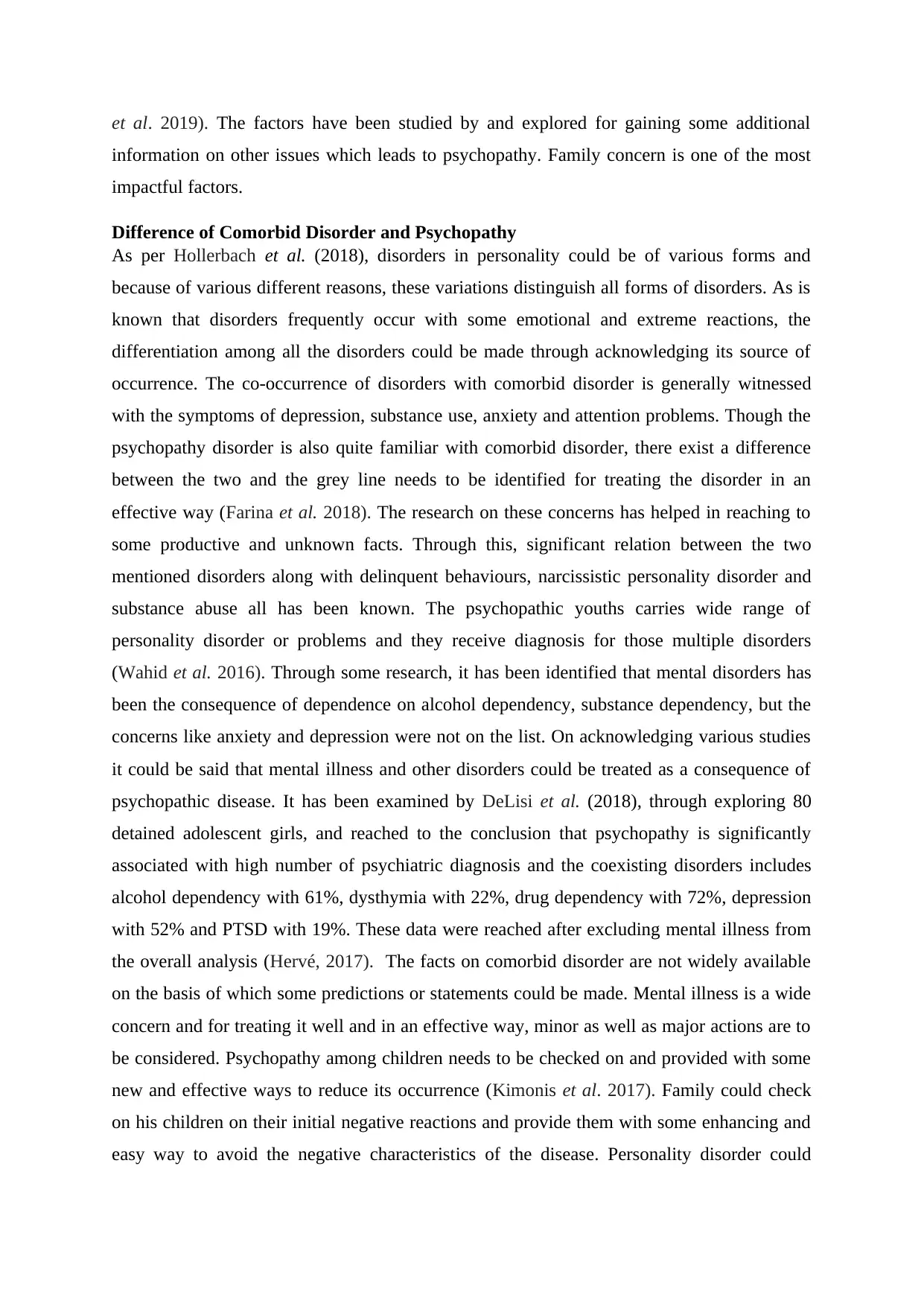
et al. 2019). The factors have been studied by and explored for gaining some additional
information on other issues which leads to psychopathy. Family concern is one of the most
impactful factors.
Difference of Comorbid Disorder and Psychopathy
As per Hollerbach et al. (2018), disorders in personality could be of various forms and
because of various different reasons, these variations distinguish all forms of disorders. As is
known that disorders frequently occur with some emotional and extreme reactions, the
differentiation among all the disorders could be made through acknowledging its source of
occurrence. The co-occurrence of disorders with comorbid disorder is generally witnessed
with the symptoms of depression, substance use, anxiety and attention problems. Though the
psychopathy disorder is also quite familiar with comorbid disorder, there exist a difference
between the two and the grey line needs to be identified for treating the disorder in an
effective way (Farina et al. 2018). The research on these concerns has helped in reaching to
some productive and unknown facts. Through this, significant relation between the two
mentioned disorders along with delinquent behaviours, narcissistic personality disorder and
substance abuse all has been known. The psychopathic youths carries wide range of
personality disorder or problems and they receive diagnosis for those multiple disorders
(Wahid et al. 2016). Through some research, it has been identified that mental disorders has
been the consequence of dependence on alcohol dependency, substance dependency, but the
concerns like anxiety and depression were not on the list. On acknowledging various studies
it could be said that mental illness and other disorders could be treated as a consequence of
psychopathic disease. It has been examined by DeLisi et al. (2018), through exploring 80
detained adolescent girls, and reached to the conclusion that psychopathy is significantly
associated with high number of psychiatric diagnosis and the coexisting disorders includes
alcohol dependency with 61%, dysthymia with 22%, drug dependency with 72%, depression
with 52% and PTSD with 19%. These data were reached after excluding mental illness from
the overall analysis (Hervé, 2017). The facts on comorbid disorder are not widely available
on the basis of which some predictions or statements could be made. Mental illness is a wide
concern and for treating it well and in an effective way, minor as well as major actions are to
be considered. Psychopathy among children needs to be checked on and provided with some
new and effective ways to reduce its occurrence (Kimonis et al. 2017). Family could check
on his children on their initial negative reactions and provide them with some enhancing and
easy way to avoid the negative characteristics of the disease. Personality disorder could
information on other issues which leads to psychopathy. Family concern is one of the most
impactful factors.
Difference of Comorbid Disorder and Psychopathy
As per Hollerbach et al. (2018), disorders in personality could be of various forms and
because of various different reasons, these variations distinguish all forms of disorders. As is
known that disorders frequently occur with some emotional and extreme reactions, the
differentiation among all the disorders could be made through acknowledging its source of
occurrence. The co-occurrence of disorders with comorbid disorder is generally witnessed
with the symptoms of depression, substance use, anxiety and attention problems. Though the
psychopathy disorder is also quite familiar with comorbid disorder, there exist a difference
between the two and the grey line needs to be identified for treating the disorder in an
effective way (Farina et al. 2018). The research on these concerns has helped in reaching to
some productive and unknown facts. Through this, significant relation between the two
mentioned disorders along with delinquent behaviours, narcissistic personality disorder and
substance abuse all has been known. The psychopathic youths carries wide range of
personality disorder or problems and they receive diagnosis for those multiple disorders
(Wahid et al. 2016). Through some research, it has been identified that mental disorders has
been the consequence of dependence on alcohol dependency, substance dependency, but the
concerns like anxiety and depression were not on the list. On acknowledging various studies
it could be said that mental illness and other disorders could be treated as a consequence of
psychopathic disease. It has been examined by DeLisi et al. (2018), through exploring 80
detained adolescent girls, and reached to the conclusion that psychopathy is significantly
associated with high number of psychiatric diagnosis and the coexisting disorders includes
alcohol dependency with 61%, dysthymia with 22%, drug dependency with 72%, depression
with 52% and PTSD with 19%. These data were reached after excluding mental illness from
the overall analysis (Hervé, 2017). The facts on comorbid disorder are not widely available
on the basis of which some predictions or statements could be made. Mental illness is a wide
concern and for treating it well and in an effective way, minor as well as major actions are to
be considered. Psychopathy among children needs to be checked on and provided with some
new and effective ways to reduce its occurrence (Kimonis et al. 2017). Family could check
on his children on their initial negative reactions and provide them with some enhancing and
easy way to avoid the negative characteristics of the disease. Personality disorder could
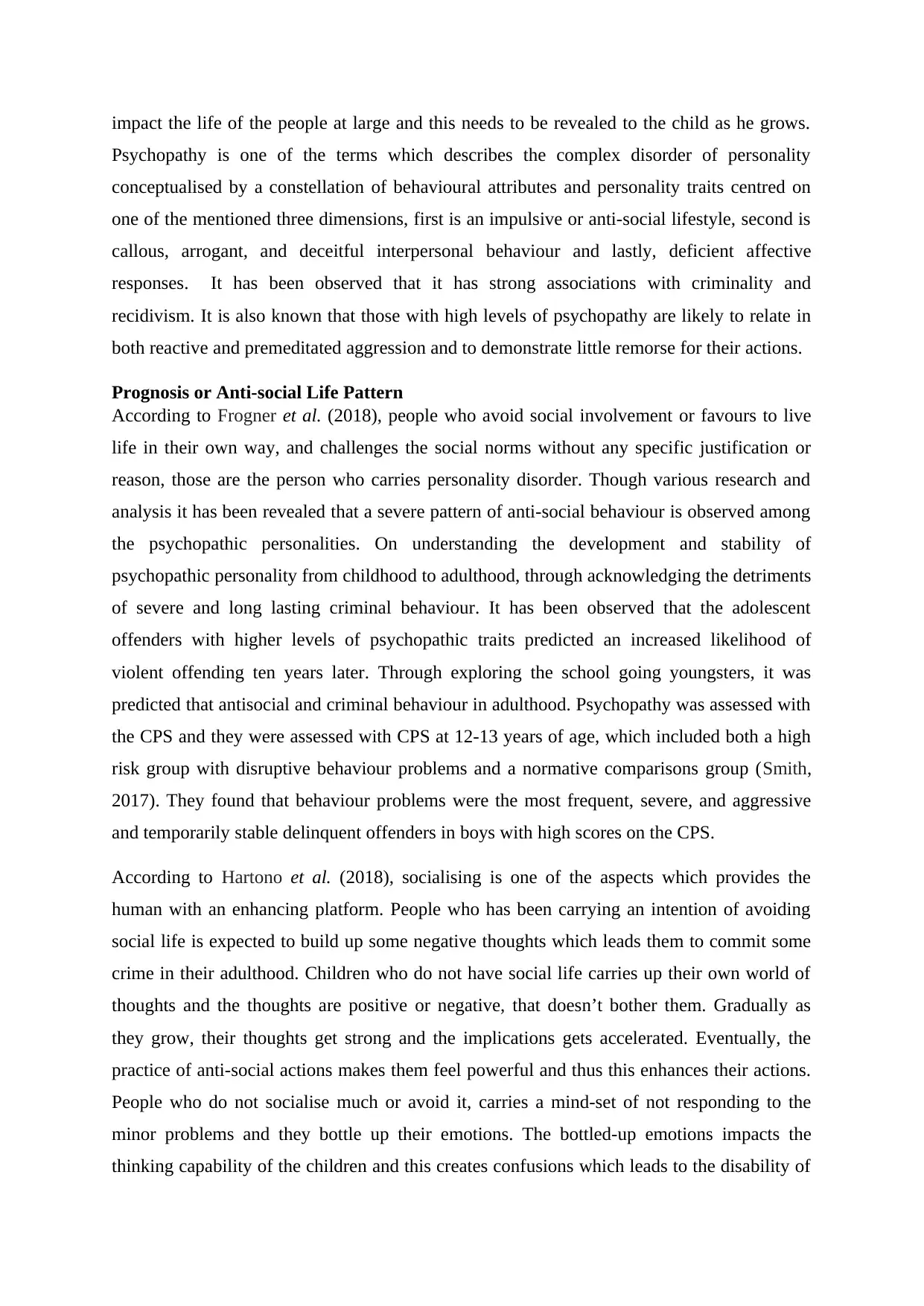
impact the life of the people at large and this needs to be revealed to the child as he grows.
Psychopathy is one of the terms which describes the complex disorder of personality
conceptualised by a constellation of behavioural attributes and personality traits centred on
one of the mentioned three dimensions, first is an impulsive or anti-social lifestyle, second is
callous, arrogant, and deceitful interpersonal behaviour and lastly, deficient affective
responses. It has been observed that it has strong associations with criminality and
recidivism. It is also known that those with high levels of psychopathy are likely to relate in
both reactive and premeditated aggression and to demonstrate little remorse for their actions.
Prognosis or Anti-social Life Pattern
According to Frogner et al. (2018), people who avoid social involvement or favours to live
life in their own way, and challenges the social norms without any specific justification or
reason, those are the person who carries personality disorder. Though various research and
analysis it has been revealed that a severe pattern of anti-social behaviour is observed among
the psychopathic personalities. On understanding the development and stability of
psychopathic personality from childhood to adulthood, through acknowledging the detriments
of severe and long lasting criminal behaviour. It has been observed that the adolescent
offenders with higher levels of psychopathic traits predicted an increased likelihood of
violent offending ten years later. Through exploring the school going youngsters, it was
predicted that antisocial and criminal behaviour in adulthood. Psychopathy was assessed with
the CPS and they were assessed with CPS at 12-13 years of age, which included both a high
risk group with disruptive behaviour problems and a normative comparisons group (Smith,
2017). They found that behaviour problems were the most frequent, severe, and aggressive
and temporarily stable delinquent offenders in boys with high scores on the CPS.
According to Hartono et al. (2018), socialising is one of the aspects which provides the
human with an enhancing platform. People who has been carrying an intention of avoiding
social life is expected to build up some negative thoughts which leads them to commit some
crime in their adulthood. Children who do not have social life carries up their own world of
thoughts and the thoughts are positive or negative, that doesn’t bother them. Gradually as
they grow, their thoughts get strong and the implications gets accelerated. Eventually, the
practice of anti-social actions makes them feel powerful and thus this enhances their actions.
People who do not socialise much or avoid it, carries a mind-set of not responding to the
minor problems and they bottle up their emotions. The bottled-up emotions impacts the
thinking capability of the children and this creates confusions which leads to the disability of
Psychopathy is one of the terms which describes the complex disorder of personality
conceptualised by a constellation of behavioural attributes and personality traits centred on
one of the mentioned three dimensions, first is an impulsive or anti-social lifestyle, second is
callous, arrogant, and deceitful interpersonal behaviour and lastly, deficient affective
responses. It has been observed that it has strong associations with criminality and
recidivism. It is also known that those with high levels of psychopathy are likely to relate in
both reactive and premeditated aggression and to demonstrate little remorse for their actions.
Prognosis or Anti-social Life Pattern
According to Frogner et al. (2018), people who avoid social involvement or favours to live
life in their own way, and challenges the social norms without any specific justification or
reason, those are the person who carries personality disorder. Though various research and
analysis it has been revealed that a severe pattern of anti-social behaviour is observed among
the psychopathic personalities. On understanding the development and stability of
psychopathic personality from childhood to adulthood, through acknowledging the detriments
of severe and long lasting criminal behaviour. It has been observed that the adolescent
offenders with higher levels of psychopathic traits predicted an increased likelihood of
violent offending ten years later. Through exploring the school going youngsters, it was
predicted that antisocial and criminal behaviour in adulthood. Psychopathy was assessed with
the CPS and they were assessed with CPS at 12-13 years of age, which included both a high
risk group with disruptive behaviour problems and a normative comparisons group (Smith,
2017). They found that behaviour problems were the most frequent, severe, and aggressive
and temporarily stable delinquent offenders in boys with high scores on the CPS.
According to Hartono et al. (2018), socialising is one of the aspects which provides the
human with an enhancing platform. People who has been carrying an intention of avoiding
social life is expected to build up some negative thoughts which leads them to commit some
crime in their adulthood. Children who do not have social life carries up their own world of
thoughts and the thoughts are positive or negative, that doesn’t bother them. Gradually as
they grow, their thoughts get strong and the implications gets accelerated. Eventually, the
practice of anti-social actions makes them feel powerful and thus this enhances their actions.
People who do not socialise much or avoid it, carries a mind-set of not responding to the
minor problems and they bottle up their emotions. The bottled-up emotions impacts the
thinking capability of the children and this creates confusions which leads to the disability of
Paraphrase This Document
Need a fresh take? Get an instant paraphrase of this document with our AI Paraphraser
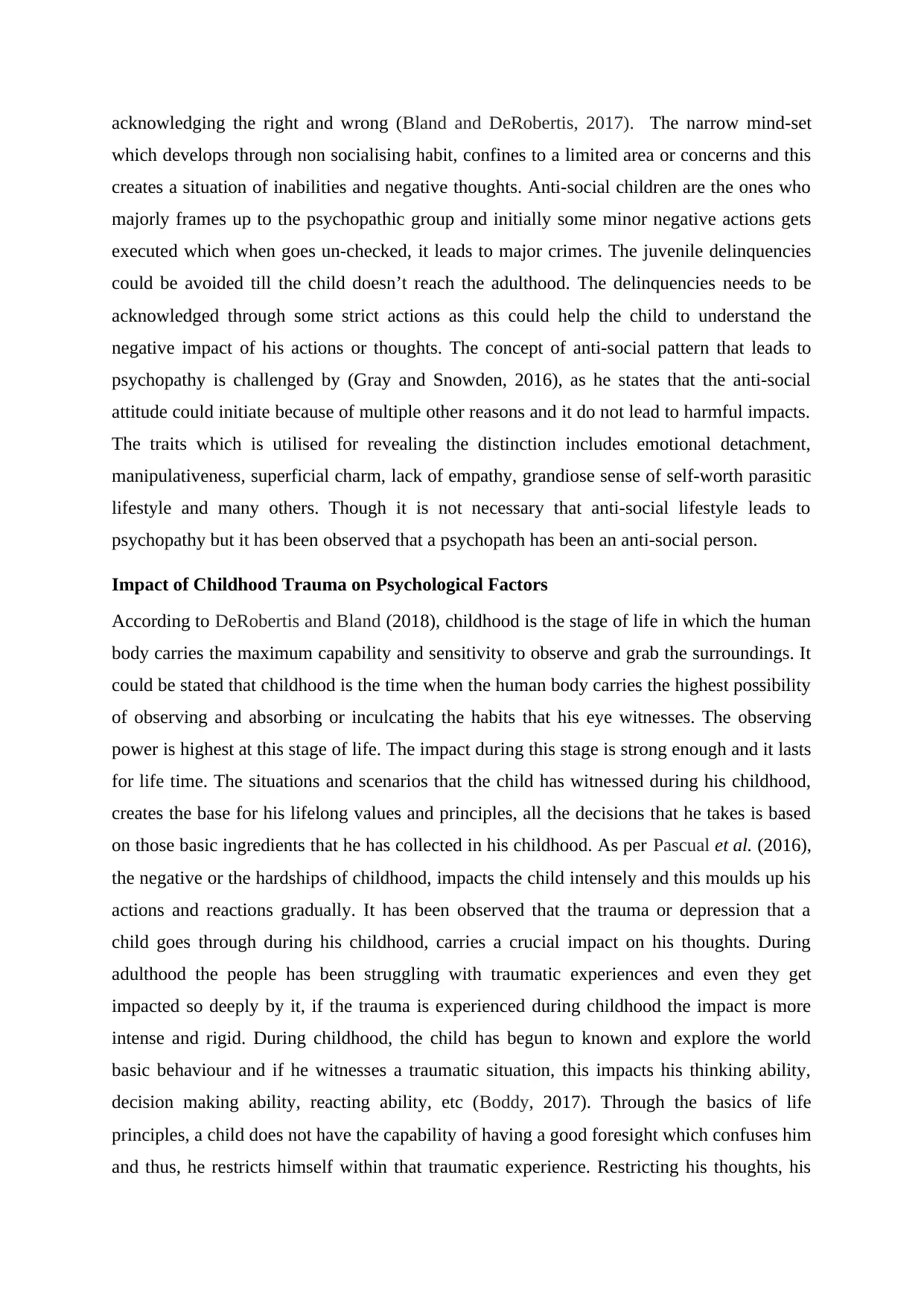
acknowledging the right and wrong (Bland and DeRobertis, 2017). The narrow mind-set
which develops through non socialising habit, confines to a limited area or concerns and this
creates a situation of inabilities and negative thoughts. Anti-social children are the ones who
majorly frames up to the psychopathic group and initially some minor negative actions gets
executed which when goes un-checked, it leads to major crimes. The juvenile delinquencies
could be avoided till the child doesn’t reach the adulthood. The delinquencies needs to be
acknowledged through some strict actions as this could help the child to understand the
negative impact of his actions or thoughts. The concept of anti-social pattern that leads to
psychopathy is challenged by (Gray and Snowden, 2016), as he states that the anti-social
attitude could initiate because of multiple other reasons and it do not lead to harmful impacts.
The traits which is utilised for revealing the distinction includes emotional detachment,
manipulativeness, superficial charm, lack of empathy, grandiose sense of self-worth parasitic
lifestyle and many others. Though it is not necessary that anti-social lifestyle leads to
psychopathy but it has been observed that a psychopath has been an anti-social person.
Impact of Childhood Trauma on Psychological Factors
According to DeRobertis and Bland (2018), childhood is the stage of life in which the human
body carries the maximum capability and sensitivity to observe and grab the surroundings. It
could be stated that childhood is the time when the human body carries the highest possibility
of observing and absorbing or inculcating the habits that his eye witnesses. The observing
power is highest at this stage of life. The impact during this stage is strong enough and it lasts
for life time. The situations and scenarios that the child has witnessed during his childhood,
creates the base for his lifelong values and principles, all the decisions that he takes is based
on those basic ingredients that he has collected in his childhood. As per Pascual et al. (2016),
the negative or the hardships of childhood, impacts the child intensely and this moulds up his
actions and reactions gradually. It has been observed that the trauma or depression that a
child goes through during his childhood, carries a crucial impact on his thoughts. During
adulthood the people has been struggling with traumatic experiences and even they get
impacted so deeply by it, if the trauma is experienced during childhood the impact is more
intense and rigid. During childhood, the child has begun to known and explore the world
basic behaviour and if he witnesses a traumatic situation, this impacts his thinking ability,
decision making ability, reacting ability, etc (Boddy, 2017). Through the basics of life
principles, a child does not have the capability of having a good foresight which confuses him
and thus, he restricts himself within that traumatic experience. Restricting his thoughts, his
which develops through non socialising habit, confines to a limited area or concerns and this
creates a situation of inabilities and negative thoughts. Anti-social children are the ones who
majorly frames up to the psychopathic group and initially some minor negative actions gets
executed which when goes un-checked, it leads to major crimes. The juvenile delinquencies
could be avoided till the child doesn’t reach the adulthood. The delinquencies needs to be
acknowledged through some strict actions as this could help the child to understand the
negative impact of his actions or thoughts. The concept of anti-social pattern that leads to
psychopathy is challenged by (Gray and Snowden, 2016), as he states that the anti-social
attitude could initiate because of multiple other reasons and it do not lead to harmful impacts.
The traits which is utilised for revealing the distinction includes emotional detachment,
manipulativeness, superficial charm, lack of empathy, grandiose sense of self-worth parasitic
lifestyle and many others. Though it is not necessary that anti-social lifestyle leads to
psychopathy but it has been observed that a psychopath has been an anti-social person.
Impact of Childhood Trauma on Psychological Factors
According to DeRobertis and Bland (2018), childhood is the stage of life in which the human
body carries the maximum capability and sensitivity to observe and grab the surroundings. It
could be stated that childhood is the time when the human body carries the highest possibility
of observing and absorbing or inculcating the habits that his eye witnesses. The observing
power is highest at this stage of life. The impact during this stage is strong enough and it lasts
for life time. The situations and scenarios that the child has witnessed during his childhood,
creates the base for his lifelong values and principles, all the decisions that he takes is based
on those basic ingredients that he has collected in his childhood. As per Pascual et al. (2016),
the negative or the hardships of childhood, impacts the child intensely and this moulds up his
actions and reactions gradually. It has been observed that the trauma or depression that a
child goes through during his childhood, carries a crucial impact on his thoughts. During
adulthood the people has been struggling with traumatic experiences and even they get
impacted so deeply by it, if the trauma is experienced during childhood the impact is more
intense and rigid. During childhood, the child has begun to known and explore the world
basic behaviour and if he witnesses a traumatic situation, this impacts his thinking ability,
decision making ability, reacting ability, etc (Boddy, 2017). Through the basics of life
principles, a child does not have the capability of having a good foresight which confuses him
and thus, he restricts himself within that traumatic experience. Restricting his thoughts, his
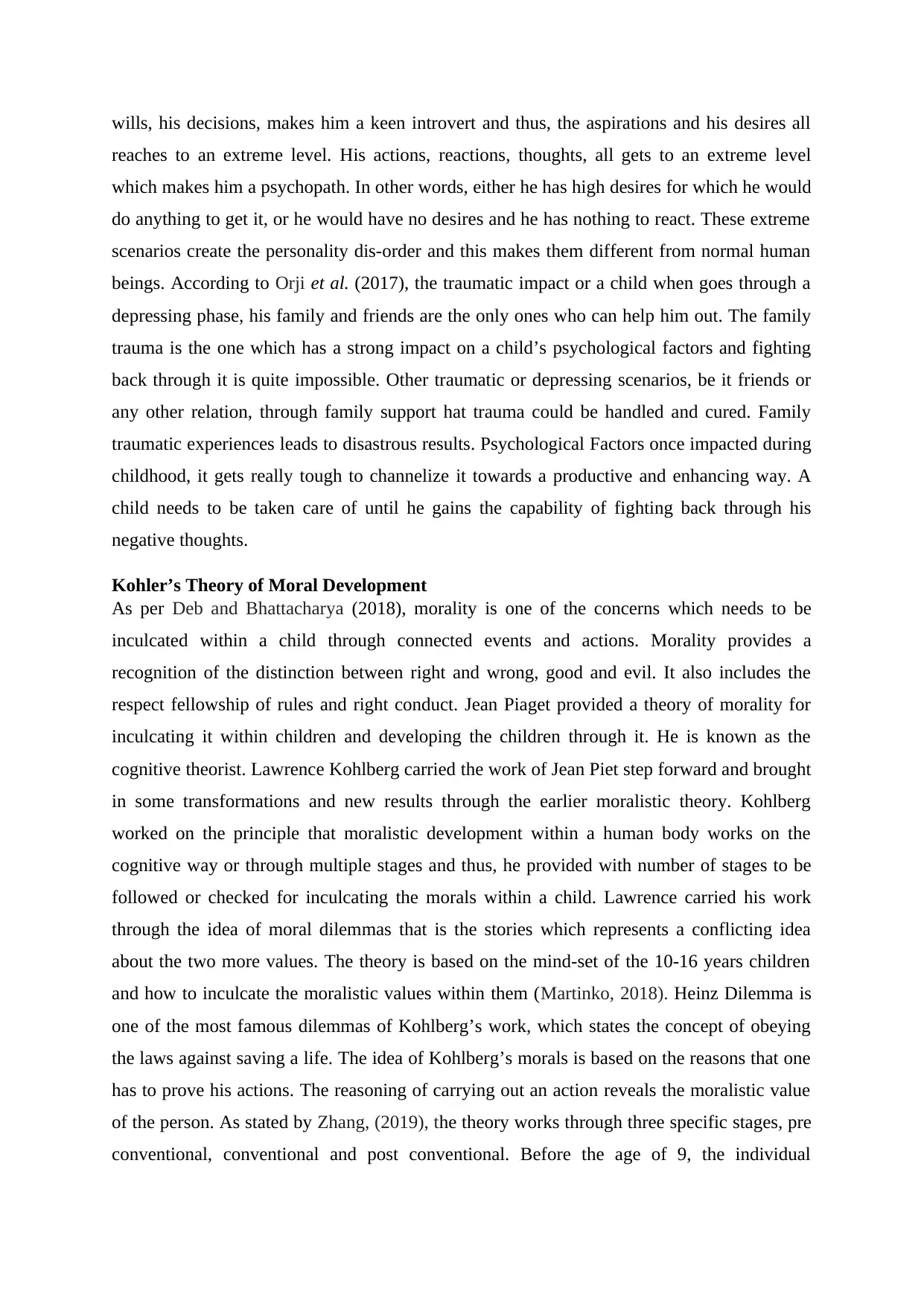
wills, his decisions, makes him a keen introvert and thus, the aspirations and his desires all
reaches to an extreme level. His actions, reactions, thoughts, all gets to an extreme level
which makes him a psychopath. In other words, either he has high desires for which he would
do anything to get it, or he would have no desires and he has nothing to react. These extreme
scenarios create the personality dis-order and this makes them different from normal human
beings. According to Orji et al. (2017), the traumatic impact or a child when goes through a
depressing phase, his family and friends are the only ones who can help him out. The family
trauma is the one which has a strong impact on a child’s psychological factors and fighting
back through it is quite impossible. Other traumatic or depressing scenarios, be it friends or
any other relation, through family support hat trauma could be handled and cured. Family
traumatic experiences leads to disastrous results. Psychological Factors once impacted during
childhood, it gets really tough to channelize it towards a productive and enhancing way. A
child needs to be taken care of until he gains the capability of fighting back through his
negative thoughts.
Kohler’s Theory of Moral Development
As per Deb and Bhattacharya (2018), morality is one of the concerns which needs to be
inculcated within a child through connected events and actions. Morality provides a
recognition of the distinction between right and wrong, good and evil. It also includes the
respect fellowship of rules and right conduct. Jean Piaget provided a theory of morality for
inculcating it within children and developing the children through it. He is known as the
cognitive theorist. Lawrence Kohlberg carried the work of Jean Piet step forward and brought
in some transformations and new results through the earlier moralistic theory. Kohlberg
worked on the principle that moralistic development within a human body works on the
cognitive way or through multiple stages and thus, he provided with number of stages to be
followed or checked for inculcating the morals within a child. Lawrence carried his work
through the idea of moral dilemmas that is the stories which represents a conflicting idea
about the two more values. The theory is based on the mind-set of the 10-16 years children
and how to inculcate the moralistic values within them (Martinko, 2018). Heinz Dilemma is
one of the most famous dilemmas of Kohlberg’s work, which states the concept of obeying
the laws against saving a life. The idea of Kohlberg’s morals is based on the reasons that one
has to prove his actions. The reasoning of carrying out an action reveals the moralistic value
of the person. As stated by Zhang, (2019), the theory works through three specific stages, pre
conventional, conventional and post conventional. Before the age of 9, the individual
reaches to an extreme level. His actions, reactions, thoughts, all gets to an extreme level
which makes him a psychopath. In other words, either he has high desires for which he would
do anything to get it, or he would have no desires and he has nothing to react. These extreme
scenarios create the personality dis-order and this makes them different from normal human
beings. According to Orji et al. (2017), the traumatic impact or a child when goes through a
depressing phase, his family and friends are the only ones who can help him out. The family
trauma is the one which has a strong impact on a child’s psychological factors and fighting
back through it is quite impossible. Other traumatic or depressing scenarios, be it friends or
any other relation, through family support hat trauma could be handled and cured. Family
traumatic experiences leads to disastrous results. Psychological Factors once impacted during
childhood, it gets really tough to channelize it towards a productive and enhancing way. A
child needs to be taken care of until he gains the capability of fighting back through his
negative thoughts.
Kohler’s Theory of Moral Development
As per Deb and Bhattacharya (2018), morality is one of the concerns which needs to be
inculcated within a child through connected events and actions. Morality provides a
recognition of the distinction between right and wrong, good and evil. It also includes the
respect fellowship of rules and right conduct. Jean Piaget provided a theory of morality for
inculcating it within children and developing the children through it. He is known as the
cognitive theorist. Lawrence Kohlberg carried the work of Jean Piet step forward and brought
in some transformations and new results through the earlier moralistic theory. Kohlberg
worked on the principle that moralistic development within a human body works on the
cognitive way or through multiple stages and thus, he provided with number of stages to be
followed or checked for inculcating the morals within a child. Lawrence carried his work
through the idea of moral dilemmas that is the stories which represents a conflicting idea
about the two more values. The theory is based on the mind-set of the 10-16 years children
and how to inculcate the moralistic values within them (Martinko, 2018). Heinz Dilemma is
one of the most famous dilemmas of Kohlberg’s work, which states the concept of obeying
the laws against saving a life. The idea of Kohlberg’s morals is based on the reasons that one
has to prove his actions. The reasoning of carrying out an action reveals the moralistic value
of the person. As stated by Zhang, (2019), the theory works through three specific stages, pre
conventional, conventional and post conventional. Before the age of 9, the individual
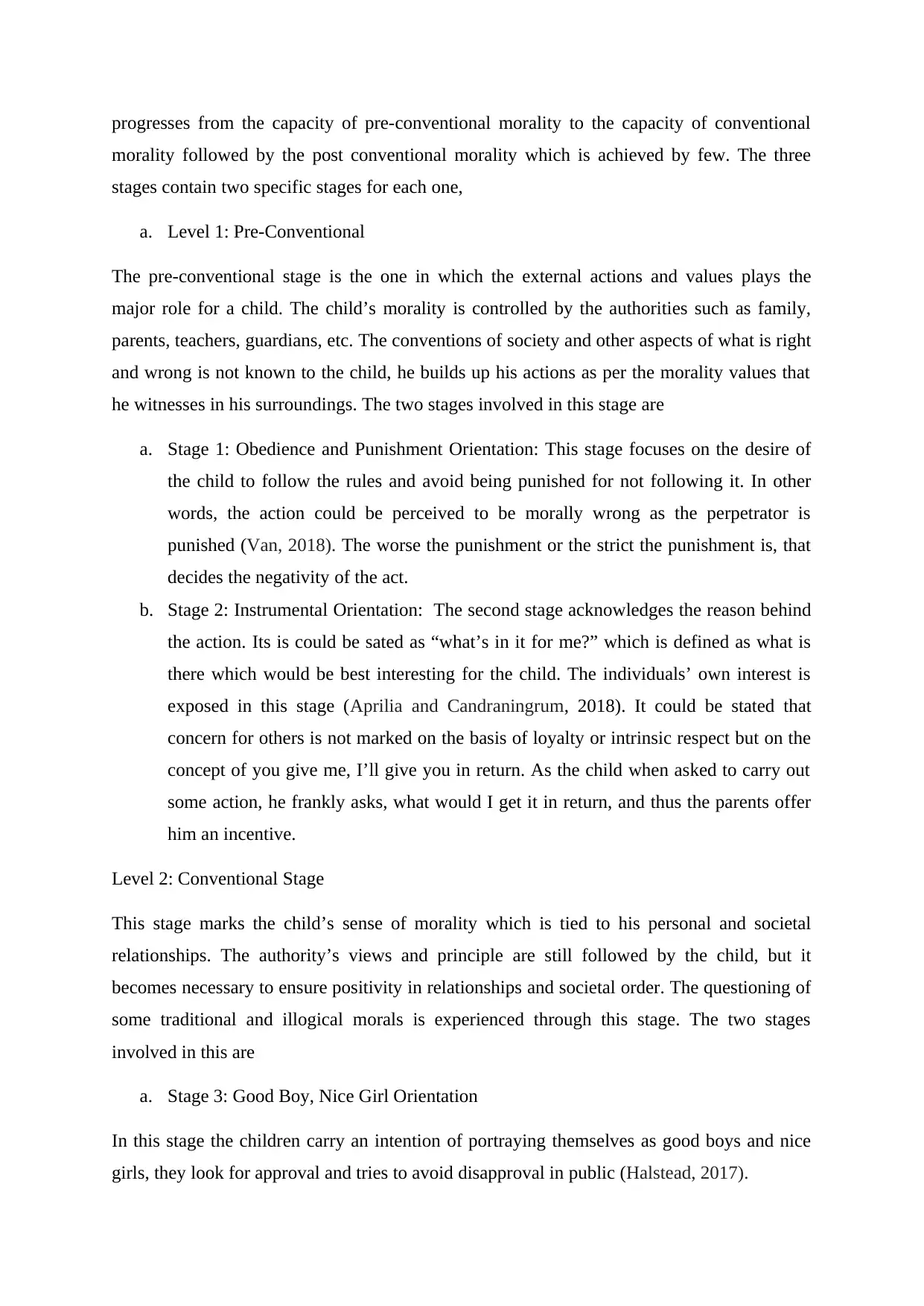
progresses from the capacity of pre-conventional morality to the capacity of conventional
morality followed by the post conventional morality which is achieved by few. The three
stages contain two specific stages for each one,
a. Level 1: Pre-Conventional
The pre-conventional stage is the one in which the external actions and values plays the
major role for a child. The child’s morality is controlled by the authorities such as family,
parents, teachers, guardians, etc. The conventions of society and other aspects of what is right
and wrong is not known to the child, he builds up his actions as per the morality values that
he witnesses in his surroundings. The two stages involved in this stage are
a. Stage 1: Obedience and Punishment Orientation: This stage focuses on the desire of
the child to follow the rules and avoid being punished for not following it. In other
words, the action could be perceived to be morally wrong as the perpetrator is
punished (Van, 2018). The worse the punishment or the strict the punishment is, that
decides the negativity of the act.
b. Stage 2: Instrumental Orientation: The second stage acknowledges the reason behind
the action. Its is could be sated as “what’s in it for me?” which is defined as what is
there which would be best interesting for the child. The individuals’ own interest is
exposed in this stage (Aprilia and Candraningrum, 2018). It could be stated that
concern for others is not marked on the basis of loyalty or intrinsic respect but on the
concept of you give me, I’ll give you in return. As the child when asked to carry out
some action, he frankly asks, what would I get it in return, and thus the parents offer
him an incentive.
Level 2: Conventional Stage
This stage marks the child’s sense of morality which is tied to his personal and societal
relationships. The authority’s views and principle are still followed by the child, but it
becomes necessary to ensure positivity in relationships and societal order. The questioning of
some traditional and illogical morals is experienced through this stage. The two stages
involved in this are
a. Stage 3: Good Boy, Nice Girl Orientation
In this stage the children carry an intention of portraying themselves as good boys and nice
girls, they look for approval and tries to avoid disapproval in public (Halstead, 2017).
morality followed by the post conventional morality which is achieved by few. The three
stages contain two specific stages for each one,
a. Level 1: Pre-Conventional
The pre-conventional stage is the one in which the external actions and values plays the
major role for a child. The child’s morality is controlled by the authorities such as family,
parents, teachers, guardians, etc. The conventions of society and other aspects of what is right
and wrong is not known to the child, he builds up his actions as per the morality values that
he witnesses in his surroundings. The two stages involved in this stage are
a. Stage 1: Obedience and Punishment Orientation: This stage focuses on the desire of
the child to follow the rules and avoid being punished for not following it. In other
words, the action could be perceived to be morally wrong as the perpetrator is
punished (Van, 2018). The worse the punishment or the strict the punishment is, that
decides the negativity of the act.
b. Stage 2: Instrumental Orientation: The second stage acknowledges the reason behind
the action. Its is could be sated as “what’s in it for me?” which is defined as what is
there which would be best interesting for the child. The individuals’ own interest is
exposed in this stage (Aprilia and Candraningrum, 2018). It could be stated that
concern for others is not marked on the basis of loyalty or intrinsic respect but on the
concept of you give me, I’ll give you in return. As the child when asked to carry out
some action, he frankly asks, what would I get it in return, and thus the parents offer
him an incentive.
Level 2: Conventional Stage
This stage marks the child’s sense of morality which is tied to his personal and societal
relationships. The authority’s views and principle are still followed by the child, but it
becomes necessary to ensure positivity in relationships and societal order. The questioning of
some traditional and illogical morals is experienced through this stage. The two stages
involved in this are
a. Stage 3: Good Boy, Nice Girl Orientation
In this stage the children carry an intention of portraying themselves as good boys and nice
girls, they look for approval and tries to avoid disapproval in public (Halstead, 2017).
Secure Best Marks with AI Grader
Need help grading? Try our AI Grader for instant feedback on your assignments.
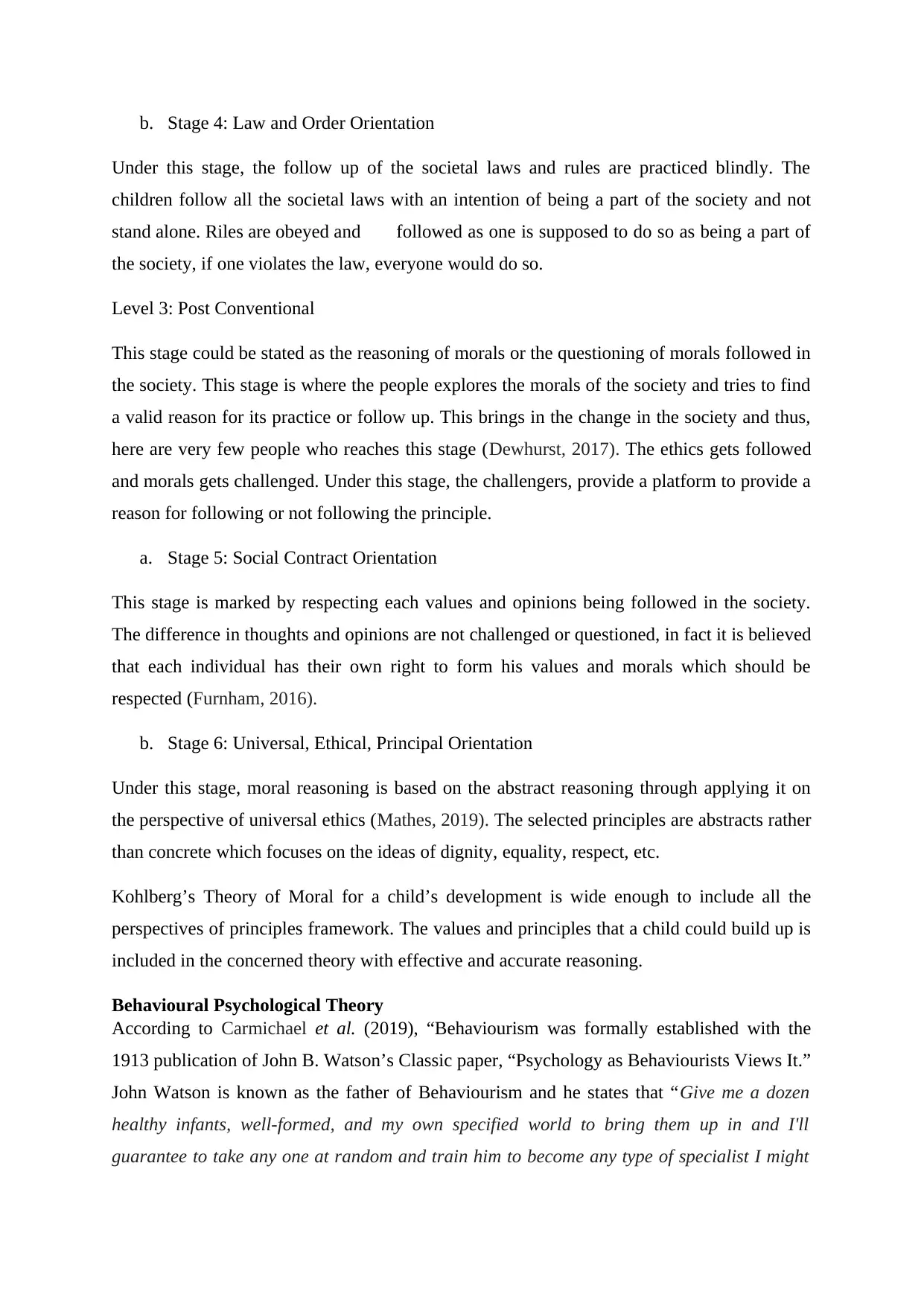
b. Stage 4: Law and Order Orientation
Under this stage, the follow up of the societal laws and rules are practiced blindly. The
children follow all the societal laws with an intention of being a part of the society and not
stand alone. Riles are obeyed and followed as one is supposed to do so as being a part of
the society, if one violates the law, everyone would do so.
Level 3: Post Conventional
This stage could be stated as the reasoning of morals or the questioning of morals followed in
the society. This stage is where the people explores the morals of the society and tries to find
a valid reason for its practice or follow up. This brings in the change in the society and thus,
here are very few people who reaches this stage (Dewhurst, 2017). The ethics gets followed
and morals gets challenged. Under this stage, the challengers, provide a platform to provide a
reason for following or not following the principle.
a. Stage 5: Social Contract Orientation
This stage is marked by respecting each values and opinions being followed in the society.
The difference in thoughts and opinions are not challenged or questioned, in fact it is believed
that each individual has their own right to form his values and morals which should be
respected (Furnham, 2016).
b. Stage 6: Universal, Ethical, Principal Orientation
Under this stage, moral reasoning is based on the abstract reasoning through applying it on
the perspective of universal ethics (Mathes, 2019). The selected principles are abstracts rather
than concrete which focuses on the ideas of dignity, equality, respect, etc.
Kohlberg’s Theory of Moral for a child’s development is wide enough to include all the
perspectives of principles framework. The values and principles that a child could build up is
included in the concerned theory with effective and accurate reasoning.
Behavioural Psychological Theory
According to Carmichael et al. (2019), “Behaviourism was formally established with the
1913 publication of John B. Watson’s Classic paper, “Psychology as Behaviourists Views It.”
John Watson is known as the father of Behaviourism and he states that “Give me a dozen
healthy infants, well-formed, and my own specified world to bring them up in and I'll
guarantee to take any one at random and train him to become any type of specialist I might
Under this stage, the follow up of the societal laws and rules are practiced blindly. The
children follow all the societal laws with an intention of being a part of the society and not
stand alone. Riles are obeyed and followed as one is supposed to do so as being a part of
the society, if one violates the law, everyone would do so.
Level 3: Post Conventional
This stage could be stated as the reasoning of morals or the questioning of morals followed in
the society. This stage is where the people explores the morals of the society and tries to find
a valid reason for its practice or follow up. This brings in the change in the society and thus,
here are very few people who reaches this stage (Dewhurst, 2017). The ethics gets followed
and morals gets challenged. Under this stage, the challengers, provide a platform to provide a
reason for following or not following the principle.
a. Stage 5: Social Contract Orientation
This stage is marked by respecting each values and opinions being followed in the society.
The difference in thoughts and opinions are not challenged or questioned, in fact it is believed
that each individual has their own right to form his values and morals which should be
respected (Furnham, 2016).
b. Stage 6: Universal, Ethical, Principal Orientation
Under this stage, moral reasoning is based on the abstract reasoning through applying it on
the perspective of universal ethics (Mathes, 2019). The selected principles are abstracts rather
than concrete which focuses on the ideas of dignity, equality, respect, etc.
Kohlberg’s Theory of Moral for a child’s development is wide enough to include all the
perspectives of principles framework. The values and principles that a child could build up is
included in the concerned theory with effective and accurate reasoning.
Behavioural Psychological Theory
According to Carmichael et al. (2019), “Behaviourism was formally established with the
1913 publication of John B. Watson’s Classic paper, “Psychology as Behaviourists Views It.”
John Watson is known as the father of Behaviourism and he states that “Give me a dozen
healthy infants, well-formed, and my own specified world to bring them up in and I'll
guarantee to take any one at random and train him to become any type of specialist I might
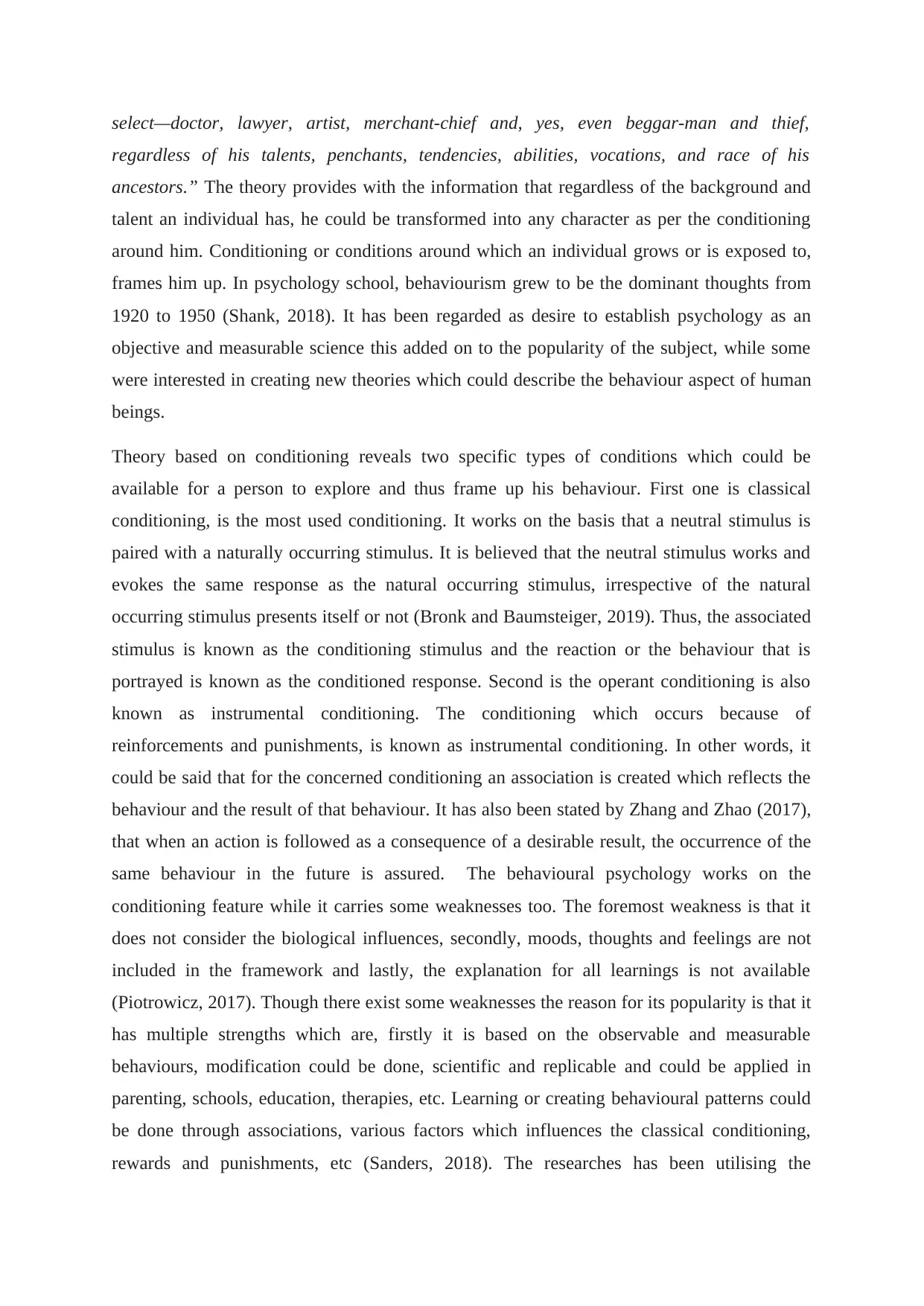
select—doctor, lawyer, artist, merchant-chief and, yes, even beggar-man and thief,
regardless of his talents, penchants, tendencies, abilities, vocations, and race of his
ancestors.” The theory provides with the information that regardless of the background and
talent an individual has, he could be transformed into any character as per the conditioning
around him. Conditioning or conditions around which an individual grows or is exposed to,
frames him up. In psychology school, behaviourism grew to be the dominant thoughts from
1920 to 1950 (Shank, 2018). It has been regarded as desire to establish psychology as an
objective and measurable science this added on to the popularity of the subject, while some
were interested in creating new theories which could describe the behaviour aspect of human
beings.
Theory based on conditioning reveals two specific types of conditions which could be
available for a person to explore and thus frame up his behaviour. First one is classical
conditioning, is the most used conditioning. It works on the basis that a neutral stimulus is
paired with a naturally occurring stimulus. It is believed that the neutral stimulus works and
evokes the same response as the natural occurring stimulus, irrespective of the natural
occurring stimulus presents itself or not (Bronk and Baumsteiger, 2019). Thus, the associated
stimulus is known as the conditioning stimulus and the reaction or the behaviour that is
portrayed is known as the conditioned response. Second is the operant conditioning is also
known as instrumental conditioning. The conditioning which occurs because of
reinforcements and punishments, is known as instrumental conditioning. In other words, it
could be said that for the concerned conditioning an association is created which reflects the
behaviour and the result of that behaviour. It has also been stated by Zhang and Zhao (2017),
that when an action is followed as a consequence of a desirable result, the occurrence of the
same behaviour in the future is assured. The behavioural psychology works on the
conditioning feature while it carries some weaknesses too. The foremost weakness is that it
does not consider the biological influences, secondly, moods, thoughts and feelings are not
included in the framework and lastly, the explanation for all learnings is not available
(Piotrowicz, 2017). Though there exist some weaknesses the reason for its popularity is that it
has multiple strengths which are, firstly it is based on the observable and measurable
behaviours, modification could be done, scientific and replicable and could be applied in
parenting, schools, education, therapies, etc. Learning or creating behavioural patterns could
be done through associations, various factors which influences the classical conditioning,
rewards and punishments, etc (Sanders, 2018). The researches has been utilising the
regardless of his talents, penchants, tendencies, abilities, vocations, and race of his
ancestors.” The theory provides with the information that regardless of the background and
talent an individual has, he could be transformed into any character as per the conditioning
around him. Conditioning or conditions around which an individual grows or is exposed to,
frames him up. In psychology school, behaviourism grew to be the dominant thoughts from
1920 to 1950 (Shank, 2018). It has been regarded as desire to establish psychology as an
objective and measurable science this added on to the popularity of the subject, while some
were interested in creating new theories which could describe the behaviour aspect of human
beings.
Theory based on conditioning reveals two specific types of conditions which could be
available for a person to explore and thus frame up his behaviour. First one is classical
conditioning, is the most used conditioning. It works on the basis that a neutral stimulus is
paired with a naturally occurring stimulus. It is believed that the neutral stimulus works and
evokes the same response as the natural occurring stimulus, irrespective of the natural
occurring stimulus presents itself or not (Bronk and Baumsteiger, 2019). Thus, the associated
stimulus is known as the conditioning stimulus and the reaction or the behaviour that is
portrayed is known as the conditioned response. Second is the operant conditioning is also
known as instrumental conditioning. The conditioning which occurs because of
reinforcements and punishments, is known as instrumental conditioning. In other words, it
could be said that for the concerned conditioning an association is created which reflects the
behaviour and the result of that behaviour. It has also been stated by Zhang and Zhao (2017),
that when an action is followed as a consequence of a desirable result, the occurrence of the
same behaviour in the future is assured. The behavioural psychology works on the
conditioning feature while it carries some weaknesses too. The foremost weakness is that it
does not consider the biological influences, secondly, moods, thoughts and feelings are not
included in the framework and lastly, the explanation for all learnings is not available
(Piotrowicz, 2017). Though there exist some weaknesses the reason for its popularity is that it
has multiple strengths which are, firstly it is based on the observable and measurable
behaviours, modification could be done, scientific and replicable and could be applied in
parenting, schools, education, therapies, etc. Learning or creating behavioural patterns could
be done through associations, various factors which influences the classical conditioning,
rewards and punishments, etc (Sanders, 2018). The researches has been utilising the
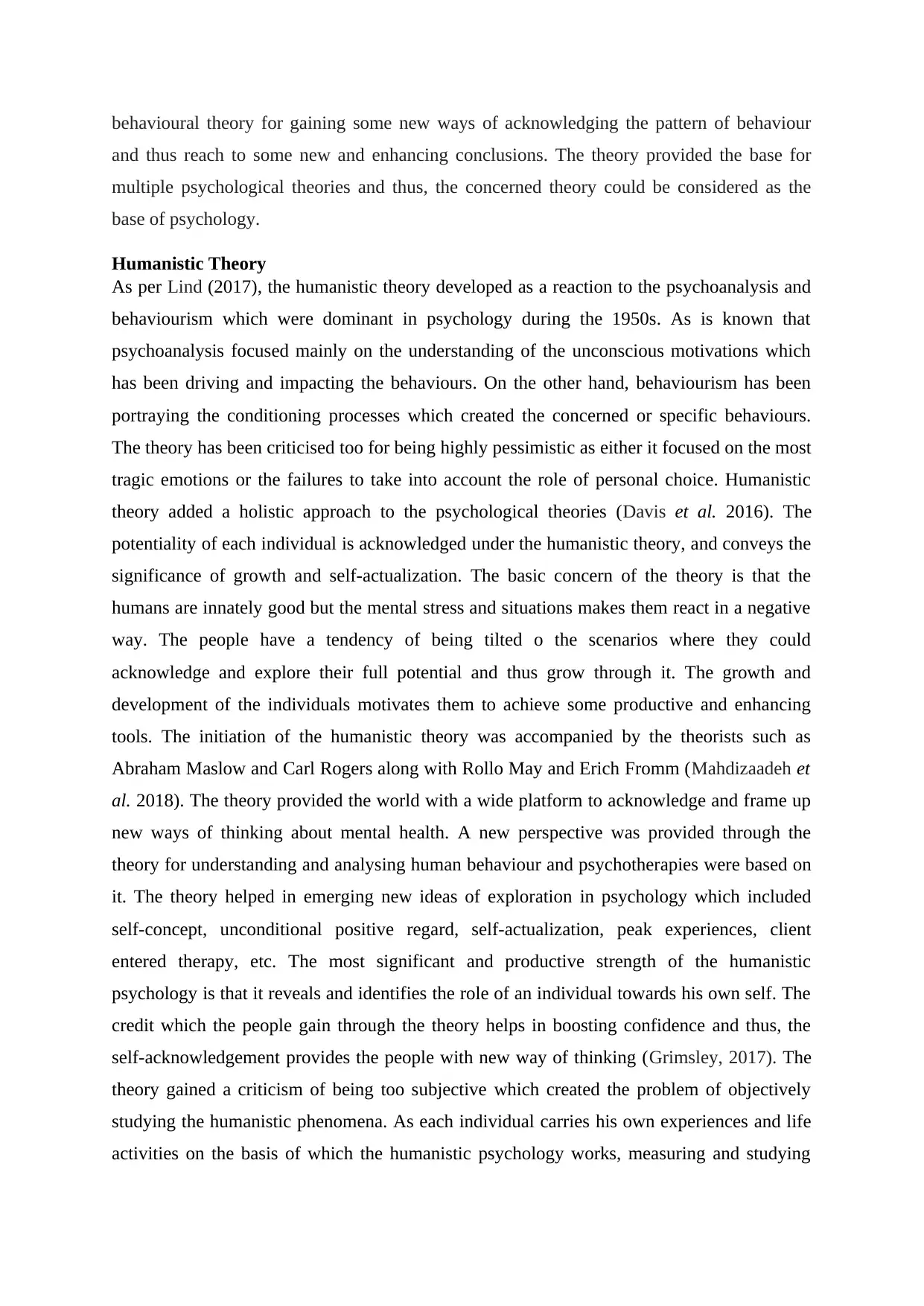
behavioural theory for gaining some new ways of acknowledging the pattern of behaviour
and thus reach to some new and enhancing conclusions. The theory provided the base for
multiple psychological theories and thus, the concerned theory could be considered as the
base of psychology.
Humanistic Theory
As per Lind (2017), the humanistic theory developed as a reaction to the psychoanalysis and
behaviourism which were dominant in psychology during the 1950s. As is known that
psychoanalysis focused mainly on the understanding of the unconscious motivations which
has been driving and impacting the behaviours. On the other hand, behaviourism has been
portraying the conditioning processes which created the concerned or specific behaviours.
The theory has been criticised too for being highly pessimistic as either it focused on the most
tragic emotions or the failures to take into account the role of personal choice. Humanistic
theory added a holistic approach to the psychological theories (Davis et al. 2016). The
potentiality of each individual is acknowledged under the humanistic theory, and conveys the
significance of growth and self-actualization. The basic concern of the theory is that the
humans are innately good but the mental stress and situations makes them react in a negative
way. The people have a tendency of being tilted o the scenarios where they could
acknowledge and explore their full potential and thus grow through it. The growth and
development of the individuals motivates them to achieve some productive and enhancing
tools. The initiation of the humanistic theory was accompanied by the theorists such as
Abraham Maslow and Carl Rogers along with Rollo May and Erich Fromm (Mahdizaadeh et
al. 2018). The theory provided the world with a wide platform to acknowledge and frame up
new ways of thinking about mental health. A new perspective was provided through the
theory for understanding and analysing human behaviour and psychotherapies were based on
it. The theory helped in emerging new ideas of exploration in psychology which included
self-concept, unconditional positive regard, self-actualization, peak experiences, client
entered therapy, etc. The most significant and productive strength of the humanistic
psychology is that it reveals and identifies the role of an individual towards his own self. The
credit which the people gain through the theory helps in boosting confidence and thus, the
self-acknowledgement provides the people with new way of thinking (Grimsley, 2017). The
theory gained a criticism of being too subjective which created the problem of objectively
studying the humanistic phenomena. As each individual carries his own experiences and life
activities on the basis of which the humanistic psychology works, measuring and studying
and thus reach to some new and enhancing conclusions. The theory provided the base for
multiple psychological theories and thus, the concerned theory could be considered as the
base of psychology.
Humanistic Theory
As per Lind (2017), the humanistic theory developed as a reaction to the psychoanalysis and
behaviourism which were dominant in psychology during the 1950s. As is known that
psychoanalysis focused mainly on the understanding of the unconscious motivations which
has been driving and impacting the behaviours. On the other hand, behaviourism has been
portraying the conditioning processes which created the concerned or specific behaviours.
The theory has been criticised too for being highly pessimistic as either it focused on the most
tragic emotions or the failures to take into account the role of personal choice. Humanistic
theory added a holistic approach to the psychological theories (Davis et al. 2016). The
potentiality of each individual is acknowledged under the humanistic theory, and conveys the
significance of growth and self-actualization. The basic concern of the theory is that the
humans are innately good but the mental stress and situations makes them react in a negative
way. The people have a tendency of being tilted o the scenarios where they could
acknowledge and explore their full potential and thus grow through it. The growth and
development of the individuals motivates them to achieve some productive and enhancing
tools. The initiation of the humanistic theory was accompanied by the theorists such as
Abraham Maslow and Carl Rogers along with Rollo May and Erich Fromm (Mahdizaadeh et
al. 2018). The theory provided the world with a wide platform to acknowledge and frame up
new ways of thinking about mental health. A new perspective was provided through the
theory for understanding and analysing human behaviour and psychotherapies were based on
it. The theory helped in emerging new ideas of exploration in psychology which included
self-concept, unconditional positive regard, self-actualization, peak experiences, client
entered therapy, etc. The most significant and productive strength of the humanistic
psychology is that it reveals and identifies the role of an individual towards his own self. The
credit which the people gain through the theory helps in boosting confidence and thus, the
self-acknowledgement provides the people with new way of thinking (Grimsley, 2017). The
theory gained a criticism of being too subjective which created the problem of objectively
studying the humanistic phenomena. As each individual carries his own experiences and life
activities on the basis of which the humanistic psychology works, measuring and studying
Paraphrase This Document
Need a fresh take? Get an instant paraphrase of this document with our AI Paraphraser
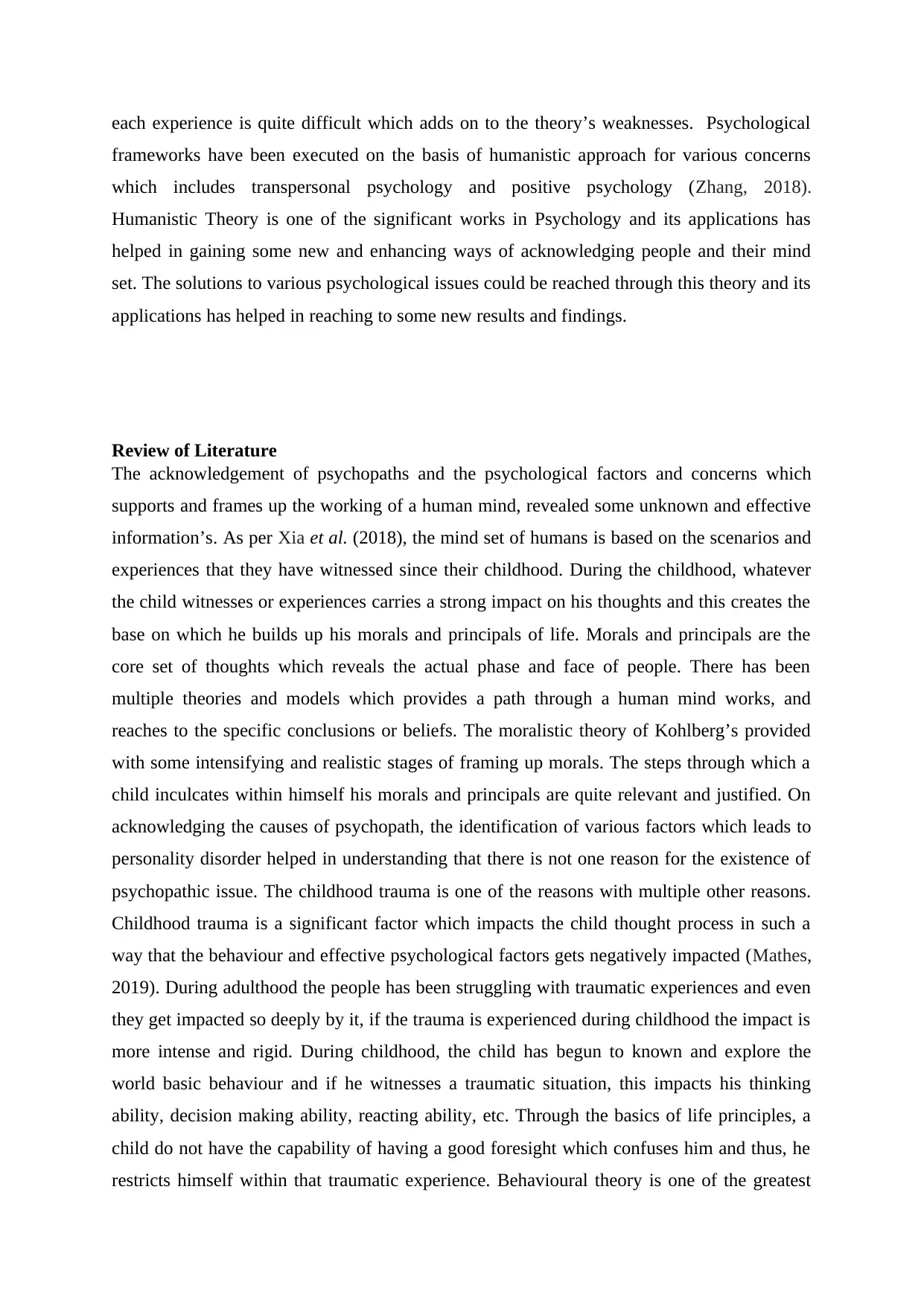
each experience is quite difficult which adds on to the theory’s weaknesses. Psychological
frameworks have been executed on the basis of humanistic approach for various concerns
which includes transpersonal psychology and positive psychology (Zhang, 2018).
Humanistic Theory is one of the significant works in Psychology and its applications has
helped in gaining some new and enhancing ways of acknowledging people and their mind
set. The solutions to various psychological issues could be reached through this theory and its
applications has helped in reaching to some new results and findings.
Review of Literature
The acknowledgement of psychopaths and the psychological factors and concerns which
supports and frames up the working of a human mind, revealed some unknown and effective
information’s. As per Xia et al. (2018), the mind set of humans is based on the scenarios and
experiences that they have witnessed since their childhood. During the childhood, whatever
the child witnesses or experiences carries a strong impact on his thoughts and this creates the
base on which he builds up his morals and principals of life. Morals and principals are the
core set of thoughts which reveals the actual phase and face of people. There has been
multiple theories and models which provides a path through a human mind works, and
reaches to the specific conclusions or beliefs. The moralistic theory of Kohlberg’s provided
with some intensifying and realistic stages of framing up morals. The steps through which a
child inculcates within himself his morals and principals are quite relevant and justified. On
acknowledging the causes of psychopath, the identification of various factors which leads to
personality disorder helped in understanding that there is not one reason for the existence of
psychopathic issue. The childhood trauma is one of the reasons with multiple other reasons.
Childhood trauma is a significant factor which impacts the child thought process in such a
way that the behaviour and effective psychological factors gets negatively impacted (Mathes,
2019). During adulthood the people has been struggling with traumatic experiences and even
they get impacted so deeply by it, if the trauma is experienced during childhood the impact is
more intense and rigid. During childhood, the child has begun to known and explore the
world basic behaviour and if he witnesses a traumatic situation, this impacts his thinking
ability, decision making ability, reacting ability, etc. Through the basics of life principles, a
child do not have the capability of having a good foresight which confuses him and thus, he
restricts himself within that traumatic experience. Behavioural theory is one of the greatest
frameworks have been executed on the basis of humanistic approach for various concerns
which includes transpersonal psychology and positive psychology (Zhang, 2018).
Humanistic Theory is one of the significant works in Psychology and its applications has
helped in gaining some new and enhancing ways of acknowledging people and their mind
set. The solutions to various psychological issues could be reached through this theory and its
applications has helped in reaching to some new results and findings.
Review of Literature
The acknowledgement of psychopaths and the psychological factors and concerns which
supports and frames up the working of a human mind, revealed some unknown and effective
information’s. As per Xia et al. (2018), the mind set of humans is based on the scenarios and
experiences that they have witnessed since their childhood. During the childhood, whatever
the child witnesses or experiences carries a strong impact on his thoughts and this creates the
base on which he builds up his morals and principals of life. Morals and principals are the
core set of thoughts which reveals the actual phase and face of people. There has been
multiple theories and models which provides a path through a human mind works, and
reaches to the specific conclusions or beliefs. The moralistic theory of Kohlberg’s provided
with some intensifying and realistic stages of framing up morals. The steps through which a
child inculcates within himself his morals and principals are quite relevant and justified. On
acknowledging the causes of psychopath, the identification of various factors which leads to
personality disorder helped in understanding that there is not one reason for the existence of
psychopathic issue. The childhood trauma is one of the reasons with multiple other reasons.
Childhood trauma is a significant factor which impacts the child thought process in such a
way that the behaviour and effective psychological factors gets negatively impacted (Mathes,
2019). During adulthood the people has been struggling with traumatic experiences and even
they get impacted so deeply by it, if the trauma is experienced during childhood the impact is
more intense and rigid. During childhood, the child has begun to known and explore the
world basic behaviour and if he witnesses a traumatic situation, this impacts his thinking
ability, decision making ability, reacting ability, etc. Through the basics of life principles, a
child do not have the capability of having a good foresight which confuses him and thus, he
restricts himself within that traumatic experience. Behavioural theory is one of the greatest
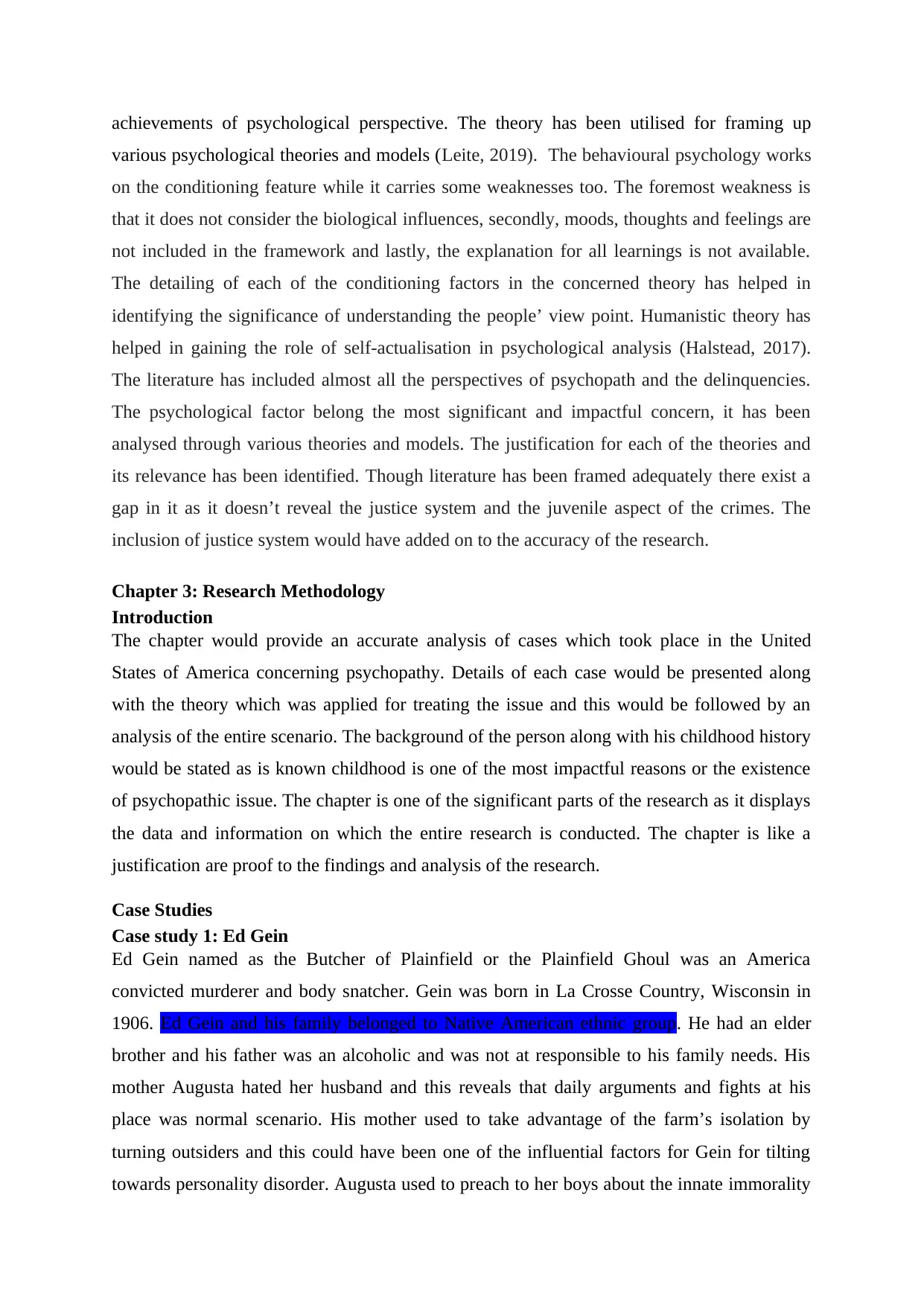
achievements of psychological perspective. The theory has been utilised for framing up
various psychological theories and models (Leite, 2019). The behavioural psychology works
on the conditioning feature while it carries some weaknesses too. The foremost weakness is
that it does not consider the biological influences, secondly, moods, thoughts and feelings are
not included in the framework and lastly, the explanation for all learnings is not available.
The detailing of each of the conditioning factors in the concerned theory has helped in
identifying the significance of understanding the people’ view point. Humanistic theory has
helped in gaining the role of self-actualisation in psychological analysis (Halstead, 2017).
The literature has included almost all the perspectives of psychopath and the delinquencies.
The psychological factor belong the most significant and impactful concern, it has been
analysed through various theories and models. The justification for each of the theories and
its relevance has been identified. Though literature has been framed adequately there exist a
gap in it as it doesn’t reveal the justice system and the juvenile aspect of the crimes. The
inclusion of justice system would have added on to the accuracy of the research.
Chapter 3: Research Methodology
Introduction
The chapter would provide an accurate analysis of cases which took place in the United
States of America concerning psychopathy. Details of each case would be presented along
with the theory which was applied for treating the issue and this would be followed by an
analysis of the entire scenario. The background of the person along with his childhood history
would be stated as is known childhood is one of the most impactful reasons or the existence
of psychopathic issue. The chapter is one of the significant parts of the research as it displays
the data and information on which the entire research is conducted. The chapter is like a
justification are proof to the findings and analysis of the research.
Case Studies
Case study 1: Ed Gein
Ed Gein named as the Butcher of Plainfield or the Plainfield Ghoul was an America
convicted murderer and body snatcher. Gein was born in La Crosse Country, Wisconsin in
1906. Ed Gein and his family belonged to Native American ethnic group. He had an elder
brother and his father was an alcoholic and was not at responsible to his family needs. His
mother Augusta hated her husband and this reveals that daily arguments and fights at his
place was normal scenario. His mother used to take advantage of the farm’s isolation by
turning outsiders and this could have been one of the influential factors for Gein for tilting
towards personality disorder. Augusta used to preach to her boys about the innate immorality
various psychological theories and models (Leite, 2019). The behavioural psychology works
on the conditioning feature while it carries some weaknesses too. The foremost weakness is
that it does not consider the biological influences, secondly, moods, thoughts and feelings are
not included in the framework and lastly, the explanation for all learnings is not available.
The detailing of each of the conditioning factors in the concerned theory has helped in
identifying the significance of understanding the people’ view point. Humanistic theory has
helped in gaining the role of self-actualisation in psychological analysis (Halstead, 2017).
The literature has included almost all the perspectives of psychopath and the delinquencies.
The psychological factor belong the most significant and impactful concern, it has been
analysed through various theories and models. The justification for each of the theories and
its relevance has been identified. Though literature has been framed adequately there exist a
gap in it as it doesn’t reveal the justice system and the juvenile aspect of the crimes. The
inclusion of justice system would have added on to the accuracy of the research.
Chapter 3: Research Methodology
Introduction
The chapter would provide an accurate analysis of cases which took place in the United
States of America concerning psychopathy. Details of each case would be presented along
with the theory which was applied for treating the issue and this would be followed by an
analysis of the entire scenario. The background of the person along with his childhood history
would be stated as is known childhood is one of the most impactful reasons or the existence
of psychopathic issue. The chapter is one of the significant parts of the research as it displays
the data and information on which the entire research is conducted. The chapter is like a
justification are proof to the findings and analysis of the research.
Case Studies
Case study 1: Ed Gein
Ed Gein named as the Butcher of Plainfield or the Plainfield Ghoul was an America
convicted murderer and body snatcher. Gein was born in La Crosse Country, Wisconsin in
1906. Ed Gein and his family belonged to Native American ethnic group. He had an elder
brother and his father was an alcoholic and was not at responsible to his family needs. His
mother Augusta hated her husband and this reveals that daily arguments and fights at his
place was normal scenario. His mother used to take advantage of the farm’s isolation by
turning outsiders and this could have been one of the influential factors for Gein for tilting
towards personality disorder. Augusta used to preach to her boys about the innate immorality
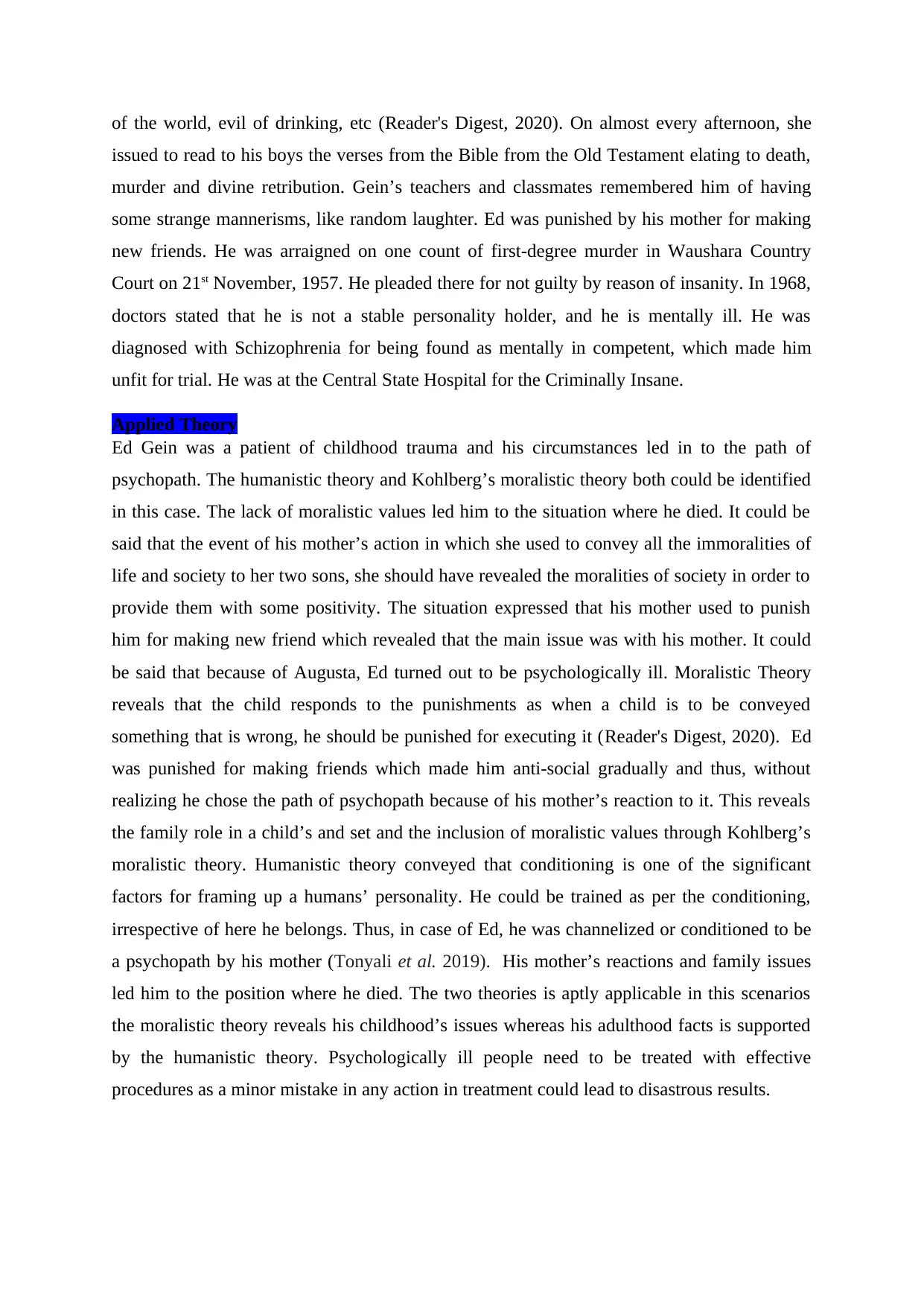
of the world, evil of drinking, etc (Reader's Digest, 2020). On almost every afternoon, she
issued to read to his boys the verses from the Bible from the Old Testament elating to death,
murder and divine retribution. Gein’s teachers and classmates remembered him of having
some strange mannerisms, like random laughter. Ed was punished by his mother for making
new friends. He was arraigned on one count of first-degree murder in Waushara Country
Court on 21st November, 1957. He pleaded there for not guilty by reason of insanity. In 1968,
doctors stated that he is not a stable personality holder, and he is mentally ill. He was
diagnosed with Schizophrenia for being found as mentally in competent, which made him
unfit for trial. He was at the Central State Hospital for the Criminally Insane.
Applied Theory
Ed Gein was a patient of childhood trauma and his circumstances led in to the path of
psychopath. The humanistic theory and Kohlberg’s moralistic theory both could be identified
in this case. The lack of moralistic values led him to the situation where he died. It could be
said that the event of his mother’s action in which she used to convey all the immoralities of
life and society to her two sons, she should have revealed the moralities of society in order to
provide them with some positivity. The situation expressed that his mother used to punish
him for making new friend which revealed that the main issue was with his mother. It could
be said that because of Augusta, Ed turned out to be psychologically ill. Moralistic Theory
reveals that the child responds to the punishments as when a child is to be conveyed
something that is wrong, he should be punished for executing it (Reader's Digest, 2020). Ed
was punished for making friends which made him anti-social gradually and thus, without
realizing he chose the path of psychopath because of his mother’s reaction to it. This reveals
the family role in a child’s and set and the inclusion of moralistic values through Kohlberg’s
moralistic theory. Humanistic theory conveyed that conditioning is one of the significant
factors for framing up a humans’ personality. He could be trained as per the conditioning,
irrespective of here he belongs. Thus, in case of Ed, he was channelized or conditioned to be
a psychopath by his mother (Tonyali et al. 2019). His mother’s reactions and family issues
led him to the position where he died. The two theories is aptly applicable in this scenarios
the moralistic theory reveals his childhood’s issues whereas his adulthood facts is supported
by the humanistic theory. Psychologically ill people need to be treated with effective
procedures as a minor mistake in any action in treatment could lead to disastrous results.
issued to read to his boys the verses from the Bible from the Old Testament elating to death,
murder and divine retribution. Gein’s teachers and classmates remembered him of having
some strange mannerisms, like random laughter. Ed was punished by his mother for making
new friends. He was arraigned on one count of first-degree murder in Waushara Country
Court on 21st November, 1957. He pleaded there for not guilty by reason of insanity. In 1968,
doctors stated that he is not a stable personality holder, and he is mentally ill. He was
diagnosed with Schizophrenia for being found as mentally in competent, which made him
unfit for trial. He was at the Central State Hospital for the Criminally Insane.
Applied Theory
Ed Gein was a patient of childhood trauma and his circumstances led in to the path of
psychopath. The humanistic theory and Kohlberg’s moralistic theory both could be identified
in this case. The lack of moralistic values led him to the situation where he died. It could be
said that the event of his mother’s action in which she used to convey all the immoralities of
life and society to her two sons, she should have revealed the moralities of society in order to
provide them with some positivity. The situation expressed that his mother used to punish
him for making new friend which revealed that the main issue was with his mother. It could
be said that because of Augusta, Ed turned out to be psychologically ill. Moralistic Theory
reveals that the child responds to the punishments as when a child is to be conveyed
something that is wrong, he should be punished for executing it (Reader's Digest, 2020). Ed
was punished for making friends which made him anti-social gradually and thus, without
realizing he chose the path of psychopath because of his mother’s reaction to it. This reveals
the family role in a child’s and set and the inclusion of moralistic values through Kohlberg’s
moralistic theory. Humanistic theory conveyed that conditioning is one of the significant
factors for framing up a humans’ personality. He could be trained as per the conditioning,
irrespective of here he belongs. Thus, in case of Ed, he was channelized or conditioned to be
a psychopath by his mother (Tonyali et al. 2019). His mother’s reactions and family issues
led him to the position where he died. The two theories is aptly applicable in this scenarios
the moralistic theory reveals his childhood’s issues whereas his adulthood facts is supported
by the humanistic theory. Psychologically ill people need to be treated with effective
procedures as a minor mistake in any action in treatment could lead to disastrous results.
Secure Best Marks with AI Grader
Need help grading? Try our AI Grader for instant feedback on your assignments.
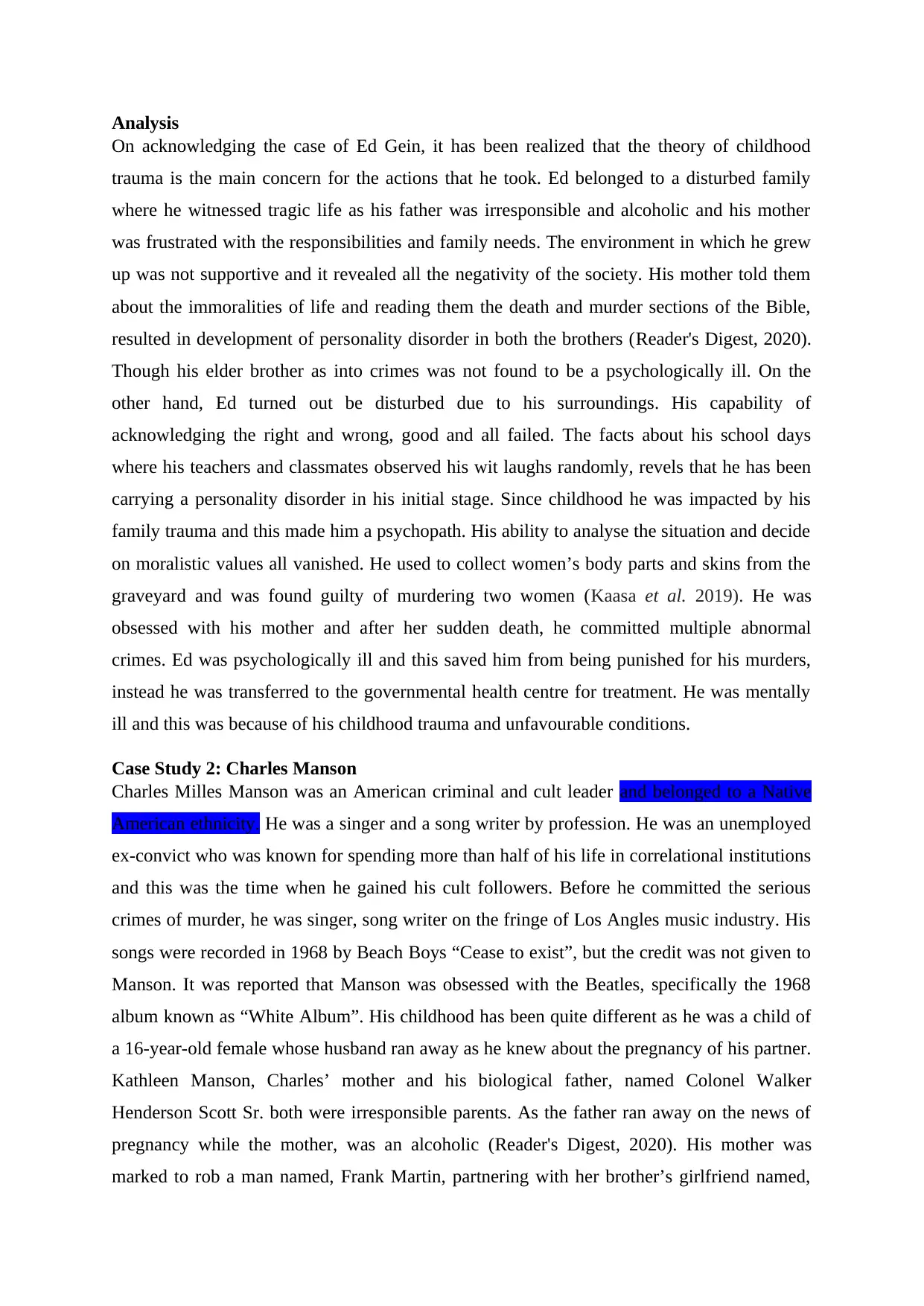
Analysis
On acknowledging the case of Ed Gein, it has been realized that the theory of childhood
trauma is the main concern for the actions that he took. Ed belonged to a disturbed family
where he witnessed tragic life as his father was irresponsible and alcoholic and his mother
was frustrated with the responsibilities and family needs. The environment in which he grew
up was not supportive and it revealed all the negativity of the society. His mother told them
about the immoralities of life and reading them the death and murder sections of the Bible,
resulted in development of personality disorder in both the brothers (Reader's Digest, 2020).
Though his elder brother as into crimes was not found to be a psychologically ill. On the
other hand, Ed turned out be disturbed due to his surroundings. His capability of
acknowledging the right and wrong, good and all failed. The facts about his school days
where his teachers and classmates observed his wit laughs randomly, revels that he has been
carrying a personality disorder in his initial stage. Since childhood he was impacted by his
family trauma and this made him a psychopath. His ability to analyse the situation and decide
on moralistic values all vanished. He used to collect women’s body parts and skins from the
graveyard and was found guilty of murdering two women (Kaasa et al. 2019). He was
obsessed with his mother and after her sudden death, he committed multiple abnormal
crimes. Ed was psychologically ill and this saved him from being punished for his murders,
instead he was transferred to the governmental health centre for treatment. He was mentally
ill and this was because of his childhood trauma and unfavourable conditions.
Case Study 2: Charles Manson
Charles Milles Manson was an American criminal and cult leader and belonged to a Native
American ethnicity. He was a singer and a song writer by profession. He was an unemployed
ex-convict who was known for spending more than half of his life in correlational institutions
and this was the time when he gained his cult followers. Before he committed the serious
crimes of murder, he was singer, song writer on the fringe of Los Angles music industry. His
songs were recorded in 1968 by Beach Boys “Cease to exist”, but the credit was not given to
Manson. It was reported that Manson was obsessed with the Beatles, specifically the 1968
album known as “White Album”. His childhood has been quite different as he was a child of
a 16-year-old female whose husband ran away as he knew about the pregnancy of his partner.
Kathleen Manson, Charles’ mother and his biological father, named Colonel Walker
Henderson Scott Sr. both were irresponsible parents. As the father ran away on the news of
pregnancy while the mother, was an alcoholic (Reader's Digest, 2020). His mother was
marked to rob a man named, Frank Martin, partnering with her brother’s girlfriend named,
On acknowledging the case of Ed Gein, it has been realized that the theory of childhood
trauma is the main concern for the actions that he took. Ed belonged to a disturbed family
where he witnessed tragic life as his father was irresponsible and alcoholic and his mother
was frustrated with the responsibilities and family needs. The environment in which he grew
up was not supportive and it revealed all the negativity of the society. His mother told them
about the immoralities of life and reading them the death and murder sections of the Bible,
resulted in development of personality disorder in both the brothers (Reader's Digest, 2020).
Though his elder brother as into crimes was not found to be a psychologically ill. On the
other hand, Ed turned out be disturbed due to his surroundings. His capability of
acknowledging the right and wrong, good and all failed. The facts about his school days
where his teachers and classmates observed his wit laughs randomly, revels that he has been
carrying a personality disorder in his initial stage. Since childhood he was impacted by his
family trauma and this made him a psychopath. His ability to analyse the situation and decide
on moralistic values all vanished. He used to collect women’s body parts and skins from the
graveyard and was found guilty of murdering two women (Kaasa et al. 2019). He was
obsessed with his mother and after her sudden death, he committed multiple abnormal
crimes. Ed was psychologically ill and this saved him from being punished for his murders,
instead he was transferred to the governmental health centre for treatment. He was mentally
ill and this was because of his childhood trauma and unfavourable conditions.
Case Study 2: Charles Manson
Charles Milles Manson was an American criminal and cult leader and belonged to a Native
American ethnicity. He was a singer and a song writer by profession. He was an unemployed
ex-convict who was known for spending more than half of his life in correlational institutions
and this was the time when he gained his cult followers. Before he committed the serious
crimes of murder, he was singer, song writer on the fringe of Los Angles music industry. His
songs were recorded in 1968 by Beach Boys “Cease to exist”, but the credit was not given to
Manson. It was reported that Manson was obsessed with the Beatles, specifically the 1968
album known as “White Album”. His childhood has been quite different as he was a child of
a 16-year-old female whose husband ran away as he knew about the pregnancy of his partner.
Kathleen Manson, Charles’ mother and his biological father, named Colonel Walker
Henderson Scott Sr. both were irresponsible parents. As the father ran away on the news of
pregnancy while the mother, was an alcoholic (Reader's Digest, 2020). His mother was
marked to rob a man named, Frank Martin, partnering with her brother’s girlfriend named,
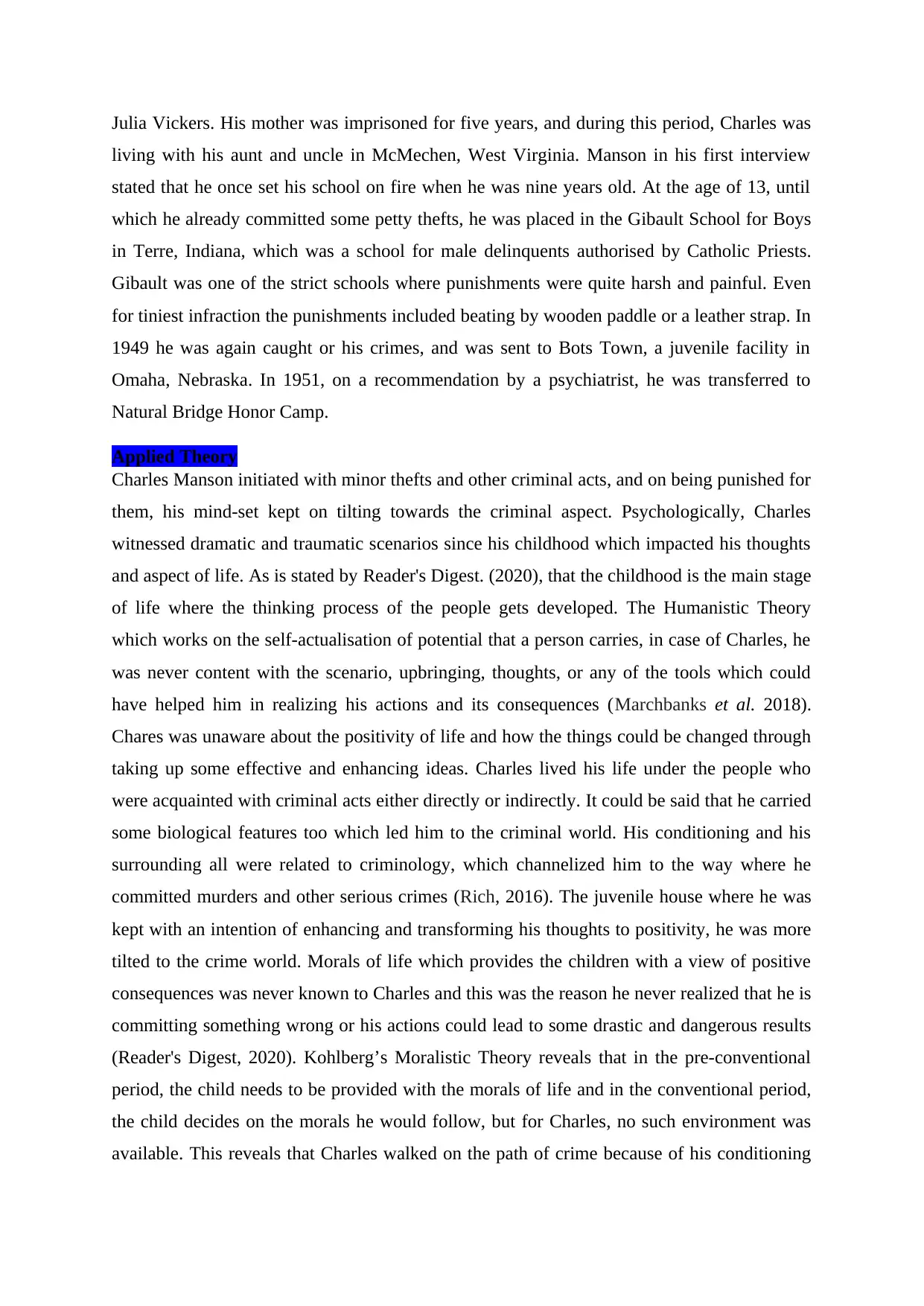
Julia Vickers. His mother was imprisoned for five years, and during this period, Charles was
living with his aunt and uncle in McMechen, West Virginia. Manson in his first interview
stated that he once set his school on fire when he was nine years old. At the age of 13, until
which he already committed some petty thefts, he was placed in the Gibault School for Boys
in Terre, Indiana, which was a school for male delinquents authorised by Catholic Priests.
Gibault was one of the strict schools where punishments were quite harsh and painful. Even
for tiniest infraction the punishments included beating by wooden paddle or a leather strap. In
1949 he was again caught or his crimes, and was sent to Bots Town, a juvenile facility in
Omaha, Nebraska. In 1951, on a recommendation by a psychiatrist, he was transferred to
Natural Bridge Honor Camp.
Applied Theory
Charles Manson initiated with minor thefts and other criminal acts, and on being punished for
them, his mind-set kept on tilting towards the criminal aspect. Psychologically, Charles
witnessed dramatic and traumatic scenarios since his childhood which impacted his thoughts
and aspect of life. As is stated by Reader's Digest. (2020), that the childhood is the main stage
of life where the thinking process of the people gets developed. The Humanistic Theory
which works on the self-actualisation of potential that a person carries, in case of Charles, he
was never content with the scenario, upbringing, thoughts, or any of the tools which could
have helped him in realizing his actions and its consequences (Marchbanks et al. 2018).
Chares was unaware about the positivity of life and how the things could be changed through
taking up some effective and enhancing ideas. Charles lived his life under the people who
were acquainted with criminal acts either directly or indirectly. It could be said that he carried
some biological features too which led him to the criminal world. His conditioning and his
surrounding all were related to criminology, which channelized him to the way where he
committed murders and other serious crimes (Rich, 2016). The juvenile house where he was
kept with an intention of enhancing and transforming his thoughts to positivity, he was more
tilted to the crime world. Morals of life which provides the children with a view of positive
consequences was never known to Charles and this was the reason he never realized that he is
committing something wrong or his actions could lead to some drastic and dangerous results
(Reader's Digest, 2020). Kohlberg’s Moralistic Theory reveals that in the pre-conventional
period, the child needs to be provided with the morals of life and in the conventional period,
the child decides on the morals he would follow, but for Charles, no such environment was
available. This reveals that Charles walked on the path of crime because of his conditioning
living with his aunt and uncle in McMechen, West Virginia. Manson in his first interview
stated that he once set his school on fire when he was nine years old. At the age of 13, until
which he already committed some petty thefts, he was placed in the Gibault School for Boys
in Terre, Indiana, which was a school for male delinquents authorised by Catholic Priests.
Gibault was one of the strict schools where punishments were quite harsh and painful. Even
for tiniest infraction the punishments included beating by wooden paddle or a leather strap. In
1949 he was again caught or his crimes, and was sent to Bots Town, a juvenile facility in
Omaha, Nebraska. In 1951, on a recommendation by a psychiatrist, he was transferred to
Natural Bridge Honor Camp.
Applied Theory
Charles Manson initiated with minor thefts and other criminal acts, and on being punished for
them, his mind-set kept on tilting towards the criminal aspect. Psychologically, Charles
witnessed dramatic and traumatic scenarios since his childhood which impacted his thoughts
and aspect of life. As is stated by Reader's Digest. (2020), that the childhood is the main stage
of life where the thinking process of the people gets developed. The Humanistic Theory
which works on the self-actualisation of potential that a person carries, in case of Charles, he
was never content with the scenario, upbringing, thoughts, or any of the tools which could
have helped him in realizing his actions and its consequences (Marchbanks et al. 2018).
Chares was unaware about the positivity of life and how the things could be changed through
taking up some effective and enhancing ideas. Charles lived his life under the people who
were acquainted with criminal acts either directly or indirectly. It could be said that he carried
some biological features too which led him to the criminal world. His conditioning and his
surrounding all were related to criminology, which channelized him to the way where he
committed murders and other serious crimes (Rich, 2016). The juvenile house where he was
kept with an intention of enhancing and transforming his thoughts to positivity, he was more
tilted to the crime world. Morals of life which provides the children with a view of positive
consequences was never known to Charles and this was the reason he never realized that he is
committing something wrong or his actions could lead to some drastic and dangerous results
(Reader's Digest, 2020). Kohlberg’s Moralistic Theory reveals that in the pre-conventional
period, the child needs to be provided with the morals of life and in the conventional period,
the child decides on the morals he would follow, but for Charles, no such environment was
available. This reveals that Charles walked on the path of crime because of his conditioning
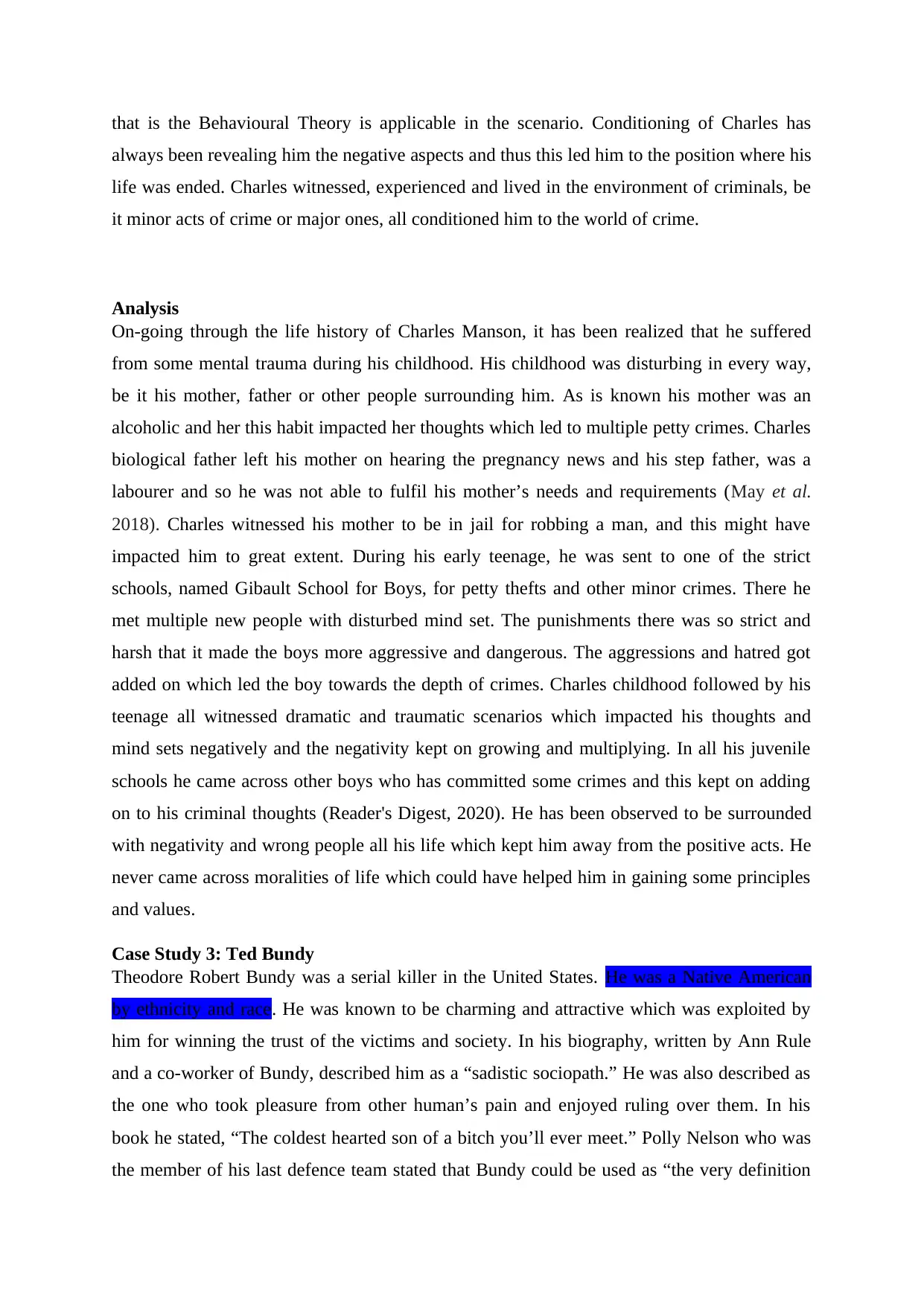
that is the Behavioural Theory is applicable in the scenario. Conditioning of Charles has
always been revealing him the negative aspects and thus this led him to the position where his
life was ended. Charles witnessed, experienced and lived in the environment of criminals, be
it minor acts of crime or major ones, all conditioned him to the world of crime.
Analysis
On-going through the life history of Charles Manson, it has been realized that he suffered
from some mental trauma during his childhood. His childhood was disturbing in every way,
be it his mother, father or other people surrounding him. As is known his mother was an
alcoholic and her this habit impacted her thoughts which led to multiple petty crimes. Charles
biological father left his mother on hearing the pregnancy news and his step father, was a
labourer and so he was not able to fulfil his mother’s needs and requirements (May et al.
2018). Charles witnessed his mother to be in jail for robbing a man, and this might have
impacted him to great extent. During his early teenage, he was sent to one of the strict
schools, named Gibault School for Boys, for petty thefts and other minor crimes. There he
met multiple new people with disturbed mind set. The punishments there was so strict and
harsh that it made the boys more aggressive and dangerous. The aggressions and hatred got
added on which led the boy towards the depth of crimes. Charles childhood followed by his
teenage all witnessed dramatic and traumatic scenarios which impacted his thoughts and
mind sets negatively and the negativity kept on growing and multiplying. In all his juvenile
schools he came across other boys who has committed some crimes and this kept on adding
on to his criminal thoughts (Reader's Digest, 2020). He has been observed to be surrounded
with negativity and wrong people all his life which kept him away from the positive acts. He
never came across moralities of life which could have helped him in gaining some principles
and values.
Case Study 3: Ted Bundy
Theodore Robert Bundy was a serial killer in the United States. He was a Native American
by ethnicity and race. He was known to be charming and attractive which was exploited by
him for winning the trust of the victims and society. In his biography, written by Ann Rule
and a co-worker of Bundy, described him as a “sadistic sociopath.” He was also described as
the one who took pleasure from other human’s pain and enjoyed ruling over them. In his
book he stated, “The coldest hearted son of a bitch you’ll ever meet.” Polly Nelson who was
the member of his last defence team stated that Bundy could be used as “the very definition
always been revealing him the negative aspects and thus this led him to the position where his
life was ended. Charles witnessed, experienced and lived in the environment of criminals, be
it minor acts of crime or major ones, all conditioned him to the world of crime.
Analysis
On-going through the life history of Charles Manson, it has been realized that he suffered
from some mental trauma during his childhood. His childhood was disturbing in every way,
be it his mother, father or other people surrounding him. As is known his mother was an
alcoholic and her this habit impacted her thoughts which led to multiple petty crimes. Charles
biological father left his mother on hearing the pregnancy news and his step father, was a
labourer and so he was not able to fulfil his mother’s needs and requirements (May et al.
2018). Charles witnessed his mother to be in jail for robbing a man, and this might have
impacted him to great extent. During his early teenage, he was sent to one of the strict
schools, named Gibault School for Boys, for petty thefts and other minor crimes. There he
met multiple new people with disturbed mind set. The punishments there was so strict and
harsh that it made the boys more aggressive and dangerous. The aggressions and hatred got
added on which led the boy towards the depth of crimes. Charles childhood followed by his
teenage all witnessed dramatic and traumatic scenarios which impacted his thoughts and
mind sets negatively and the negativity kept on growing and multiplying. In all his juvenile
schools he came across other boys who has committed some crimes and this kept on adding
on to his criminal thoughts (Reader's Digest, 2020). He has been observed to be surrounded
with negativity and wrong people all his life which kept him away from the positive acts. He
never came across moralities of life which could have helped him in gaining some principles
and values.
Case Study 3: Ted Bundy
Theodore Robert Bundy was a serial killer in the United States. He was a Native American
by ethnicity and race. He was known to be charming and attractive which was exploited by
him for winning the trust of the victims and society. In his biography, written by Ann Rule
and a co-worker of Bundy, described him as a “sadistic sociopath.” He was also described as
the one who took pleasure from other human’s pain and enjoyed ruling over them. In his
book he stated, “The coldest hearted son of a bitch you’ll ever meet.” Polly Nelson who was
the member of his last defence team stated that Bundy could be used as “the very definition
Paraphrase This Document
Need a fresh take? Get an instant paraphrase of this document with our AI Paraphraser
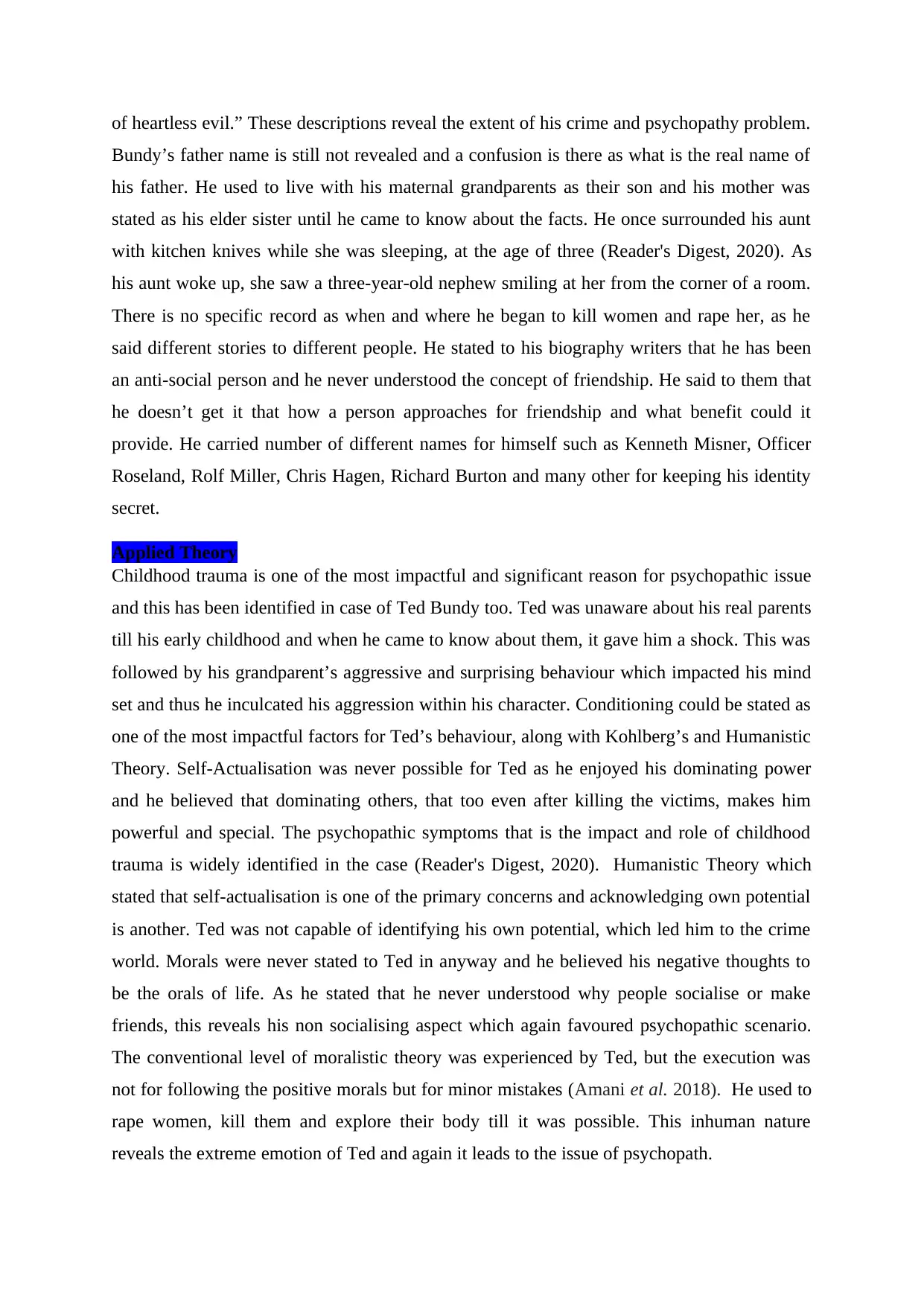
of heartless evil.” These descriptions reveal the extent of his crime and psychopathy problem.
Bundy’s father name is still not revealed and a confusion is there as what is the real name of
his father. He used to live with his maternal grandparents as their son and his mother was
stated as his elder sister until he came to know about the facts. He once surrounded his aunt
with kitchen knives while she was sleeping, at the age of three (Reader's Digest, 2020). As
his aunt woke up, she saw a three-year-old nephew smiling at her from the corner of a room.
There is no specific record as when and where he began to kill women and rape her, as he
said different stories to different people. He stated to his biography writers that he has been
an anti-social person and he never understood the concept of friendship. He said to them that
he doesn’t get it that how a person approaches for friendship and what benefit could it
provide. He carried number of different names for himself such as Kenneth Misner, Officer
Roseland, Rolf Miller, Chris Hagen, Richard Burton and many other for keeping his identity
secret.
Applied Theory
Childhood trauma is one of the most impactful and significant reason for psychopathic issue
and this has been identified in case of Ted Bundy too. Ted was unaware about his real parents
till his early childhood and when he came to know about them, it gave him a shock. This was
followed by his grandparent’s aggressive and surprising behaviour which impacted his mind
set and thus he inculcated his aggression within his character. Conditioning could be stated as
one of the most impactful factors for Ted’s behaviour, along with Kohlberg’s and Humanistic
Theory. Self-Actualisation was never possible for Ted as he enjoyed his dominating power
and he believed that dominating others, that too even after killing the victims, makes him
powerful and special. The psychopathic symptoms that is the impact and role of childhood
trauma is widely identified in the case (Reader's Digest, 2020). Humanistic Theory which
stated that self-actualisation is one of the primary concerns and acknowledging own potential
is another. Ted was not capable of identifying his own potential, which led him to the crime
world. Morals were never stated to Ted in anyway and he believed his negative thoughts to
be the orals of life. As he stated that he never understood why people socialise or make
friends, this reveals his non socialising aspect which again favoured psychopathic scenario.
The conventional level of moralistic theory was experienced by Ted, but the execution was
not for following the positive morals but for minor mistakes (Amani et al. 2018). He used to
rape women, kill them and explore their body till it was possible. This inhuman nature
reveals the extreme emotion of Ted and again it leads to the issue of psychopath.
Bundy’s father name is still not revealed and a confusion is there as what is the real name of
his father. He used to live with his maternal grandparents as their son and his mother was
stated as his elder sister until he came to know about the facts. He once surrounded his aunt
with kitchen knives while she was sleeping, at the age of three (Reader's Digest, 2020). As
his aunt woke up, she saw a three-year-old nephew smiling at her from the corner of a room.
There is no specific record as when and where he began to kill women and rape her, as he
said different stories to different people. He stated to his biography writers that he has been
an anti-social person and he never understood the concept of friendship. He said to them that
he doesn’t get it that how a person approaches for friendship and what benefit could it
provide. He carried number of different names for himself such as Kenneth Misner, Officer
Roseland, Rolf Miller, Chris Hagen, Richard Burton and many other for keeping his identity
secret.
Applied Theory
Childhood trauma is one of the most impactful and significant reason for psychopathic issue
and this has been identified in case of Ted Bundy too. Ted was unaware about his real parents
till his early childhood and when he came to know about them, it gave him a shock. This was
followed by his grandparent’s aggressive and surprising behaviour which impacted his mind
set and thus he inculcated his aggression within his character. Conditioning could be stated as
one of the most impactful factors for Ted’s behaviour, along with Kohlberg’s and Humanistic
Theory. Self-Actualisation was never possible for Ted as he enjoyed his dominating power
and he believed that dominating others, that too even after killing the victims, makes him
powerful and special. The psychopathic symptoms that is the impact and role of childhood
trauma is widely identified in the case (Reader's Digest, 2020). Humanistic Theory which
stated that self-actualisation is one of the primary concerns and acknowledging own potential
is another. Ted was not capable of identifying his own potential, which led him to the crime
world. Morals were never stated to Ted in anyway and he believed his negative thoughts to
be the orals of life. As he stated that he never understood why people socialise or make
friends, this reveals his non socialising aspect which again favoured psychopathic scenario.
The conventional level of moralistic theory was experienced by Ted, but the execution was
not for following the positive morals but for minor mistakes (Amani et al. 2018). He used to
rape women, kill them and explore their body till it was possible. This inhuman nature
reveals the extreme emotion of Ted and again it leads to the issue of psychopath.
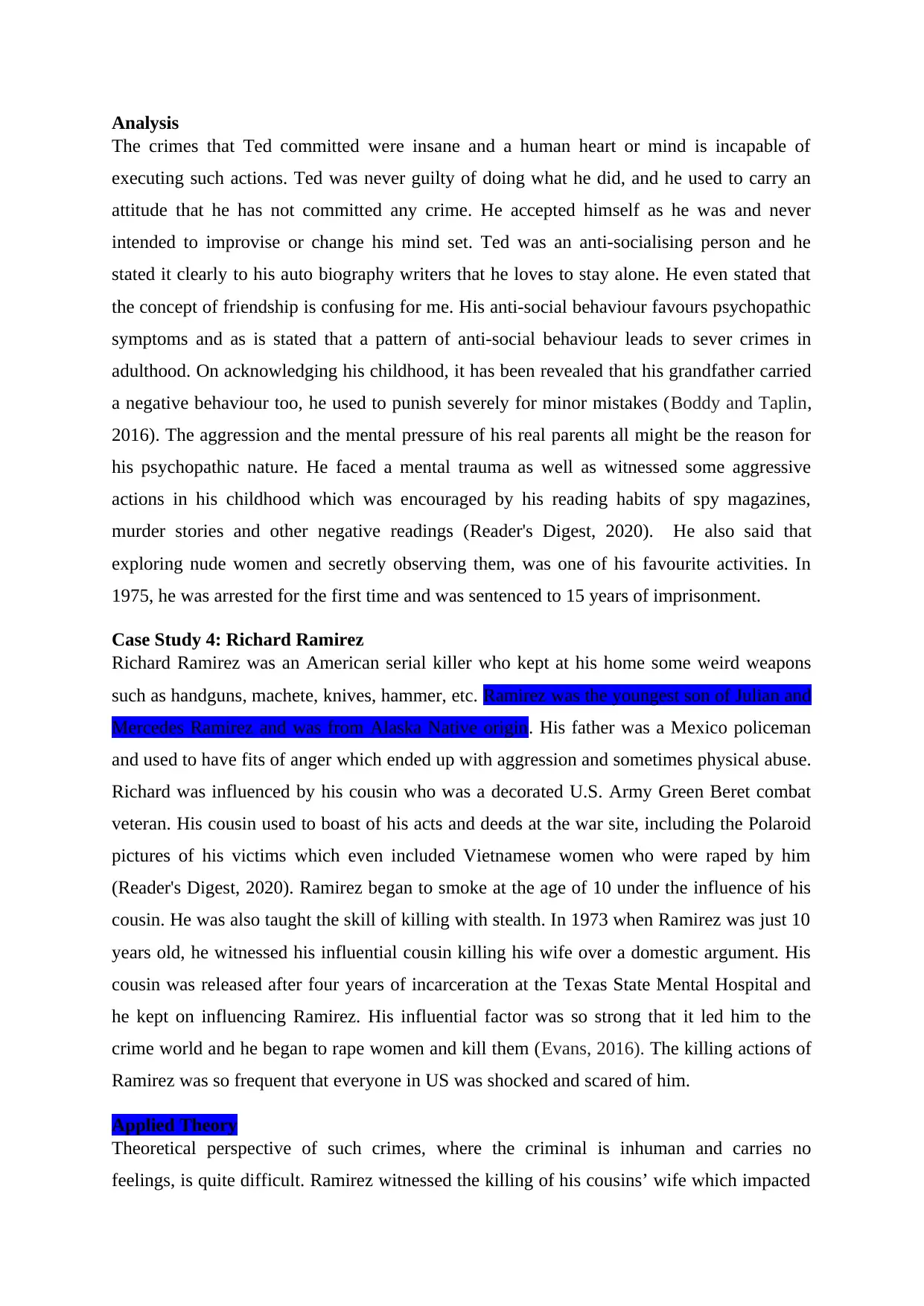
Analysis
The crimes that Ted committed were insane and a human heart or mind is incapable of
executing such actions. Ted was never guilty of doing what he did, and he used to carry an
attitude that he has not committed any crime. He accepted himself as he was and never
intended to improvise or change his mind set. Ted was an anti-socialising person and he
stated it clearly to his auto biography writers that he loves to stay alone. He even stated that
the concept of friendship is confusing for me. His anti-social behaviour favours psychopathic
symptoms and as is stated that a pattern of anti-social behaviour leads to sever crimes in
adulthood. On acknowledging his childhood, it has been revealed that his grandfather carried
a negative behaviour too, he used to punish severely for minor mistakes (Boddy and Taplin,
2016). The aggression and the mental pressure of his real parents all might be the reason for
his psychopathic nature. He faced a mental trauma as well as witnessed some aggressive
actions in his childhood which was encouraged by his reading habits of spy magazines,
murder stories and other negative readings (Reader's Digest, 2020). He also said that
exploring nude women and secretly observing them, was one of his favourite activities. In
1975, he was arrested for the first time and was sentenced to 15 years of imprisonment.
Case Study 4: Richard Ramirez
Richard Ramirez was an American serial killer who kept at his home some weird weapons
such as handguns, machete, knives, hammer, etc. Ramirez was the youngest son of Julian and
Mercedes Ramirez and was from Alaska Native origin. His father was a Mexico policeman
and used to have fits of anger which ended up with aggression and sometimes physical abuse.
Richard was influenced by his cousin who was a decorated U.S. Army Green Beret combat
veteran. His cousin used to boast of his acts and deeds at the war site, including the Polaroid
pictures of his victims which even included Vietnamese women who were raped by him
(Reader's Digest, 2020). Ramirez began to smoke at the age of 10 under the influence of his
cousin. He was also taught the skill of killing with stealth. In 1973 when Ramirez was just 10
years old, he witnessed his influential cousin killing his wife over a domestic argument. His
cousin was released after four years of incarceration at the Texas State Mental Hospital and
he kept on influencing Ramirez. His influential factor was so strong that it led him to the
crime world and he began to rape women and kill them (Evans, 2016). The killing actions of
Ramirez was so frequent that everyone in US was shocked and scared of him.
Applied Theory
Theoretical perspective of such crimes, where the criminal is inhuman and carries no
feelings, is quite difficult. Ramirez witnessed the killing of his cousins’ wife which impacted
The crimes that Ted committed were insane and a human heart or mind is incapable of
executing such actions. Ted was never guilty of doing what he did, and he used to carry an
attitude that he has not committed any crime. He accepted himself as he was and never
intended to improvise or change his mind set. Ted was an anti-socialising person and he
stated it clearly to his auto biography writers that he loves to stay alone. He even stated that
the concept of friendship is confusing for me. His anti-social behaviour favours psychopathic
symptoms and as is stated that a pattern of anti-social behaviour leads to sever crimes in
adulthood. On acknowledging his childhood, it has been revealed that his grandfather carried
a negative behaviour too, he used to punish severely for minor mistakes (Boddy and Taplin,
2016). The aggression and the mental pressure of his real parents all might be the reason for
his psychopathic nature. He faced a mental trauma as well as witnessed some aggressive
actions in his childhood which was encouraged by his reading habits of spy magazines,
murder stories and other negative readings (Reader's Digest, 2020). He also said that
exploring nude women and secretly observing them, was one of his favourite activities. In
1975, he was arrested for the first time and was sentenced to 15 years of imprisonment.
Case Study 4: Richard Ramirez
Richard Ramirez was an American serial killer who kept at his home some weird weapons
such as handguns, machete, knives, hammer, etc. Ramirez was the youngest son of Julian and
Mercedes Ramirez and was from Alaska Native origin. His father was a Mexico policeman
and used to have fits of anger which ended up with aggression and sometimes physical abuse.
Richard was influenced by his cousin who was a decorated U.S. Army Green Beret combat
veteran. His cousin used to boast of his acts and deeds at the war site, including the Polaroid
pictures of his victims which even included Vietnamese women who were raped by him
(Reader's Digest, 2020). Ramirez began to smoke at the age of 10 under the influence of his
cousin. He was also taught the skill of killing with stealth. In 1973 when Ramirez was just 10
years old, he witnessed his influential cousin killing his wife over a domestic argument. His
cousin was released after four years of incarceration at the Texas State Mental Hospital and
he kept on influencing Ramirez. His influential factor was so strong that it led him to the
crime world and he began to rape women and kill them (Evans, 2016). The killing actions of
Ramirez was so frequent that everyone in US was shocked and scared of him.
Applied Theory
Theoretical perspective of such crimes, where the criminal is inhuman and carries no
feelings, is quite difficult. Ramirez witnessed the killing of his cousins’ wife which impacted
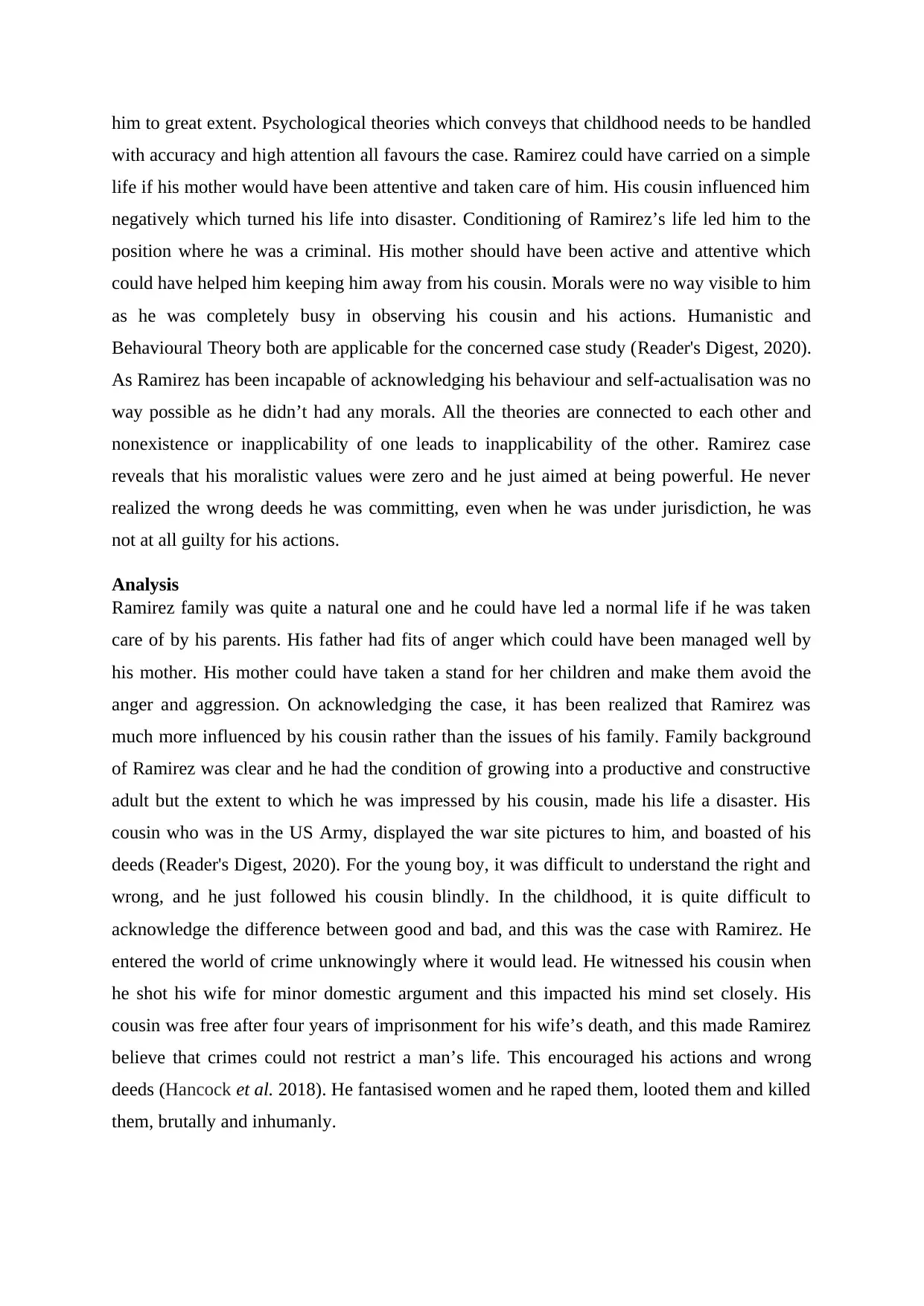
him to great extent. Psychological theories which conveys that childhood needs to be handled
with accuracy and high attention all favours the case. Ramirez could have carried on a simple
life if his mother would have been attentive and taken care of him. His cousin influenced him
negatively which turned his life into disaster. Conditioning of Ramirez’s life led him to the
position where he was a criminal. His mother should have been active and attentive which
could have helped him keeping him away from his cousin. Morals were no way visible to him
as he was completely busy in observing his cousin and his actions. Humanistic and
Behavioural Theory both are applicable for the concerned case study (Reader's Digest, 2020).
As Ramirez has been incapable of acknowledging his behaviour and self-actualisation was no
way possible as he didn’t had any morals. All the theories are connected to each other and
nonexistence or inapplicability of one leads to inapplicability of the other. Ramirez case
reveals that his moralistic values were zero and he just aimed at being powerful. He never
realized the wrong deeds he was committing, even when he was under jurisdiction, he was
not at all guilty for his actions.
Analysis
Ramirez family was quite a natural one and he could have led a normal life if he was taken
care of by his parents. His father had fits of anger which could have been managed well by
his mother. His mother could have taken a stand for her children and make them avoid the
anger and aggression. On acknowledging the case, it has been realized that Ramirez was
much more influenced by his cousin rather than the issues of his family. Family background
of Ramirez was clear and he had the condition of growing into a productive and constructive
adult but the extent to which he was impressed by his cousin, made his life a disaster. His
cousin who was in the US Army, displayed the war site pictures to him, and boasted of his
deeds (Reader's Digest, 2020). For the young boy, it was difficult to understand the right and
wrong, and he just followed his cousin blindly. In the childhood, it is quite difficult to
acknowledge the difference between good and bad, and this was the case with Ramirez. He
entered the world of crime unknowingly where it would lead. He witnessed his cousin when
he shot his wife for minor domestic argument and this impacted his mind set closely. His
cousin was free after four years of imprisonment for his wife’s death, and this made Ramirez
believe that crimes could not restrict a man’s life. This encouraged his actions and wrong
deeds (Hancock et al. 2018). He fantasised women and he raped them, looted them and killed
them, brutally and inhumanly.
with accuracy and high attention all favours the case. Ramirez could have carried on a simple
life if his mother would have been attentive and taken care of him. His cousin influenced him
negatively which turned his life into disaster. Conditioning of Ramirez’s life led him to the
position where he was a criminal. His mother should have been active and attentive which
could have helped him keeping him away from his cousin. Morals were no way visible to him
as he was completely busy in observing his cousin and his actions. Humanistic and
Behavioural Theory both are applicable for the concerned case study (Reader's Digest, 2020).
As Ramirez has been incapable of acknowledging his behaviour and self-actualisation was no
way possible as he didn’t had any morals. All the theories are connected to each other and
nonexistence or inapplicability of one leads to inapplicability of the other. Ramirez case
reveals that his moralistic values were zero and he just aimed at being powerful. He never
realized the wrong deeds he was committing, even when he was under jurisdiction, he was
not at all guilty for his actions.
Analysis
Ramirez family was quite a natural one and he could have led a normal life if he was taken
care of by his parents. His father had fits of anger which could have been managed well by
his mother. His mother could have taken a stand for her children and make them avoid the
anger and aggression. On acknowledging the case, it has been realized that Ramirez was
much more influenced by his cousin rather than the issues of his family. Family background
of Ramirez was clear and he had the condition of growing into a productive and constructive
adult but the extent to which he was impressed by his cousin, made his life a disaster. His
cousin who was in the US Army, displayed the war site pictures to him, and boasted of his
deeds (Reader's Digest, 2020). For the young boy, it was difficult to understand the right and
wrong, and he just followed his cousin blindly. In the childhood, it is quite difficult to
acknowledge the difference between good and bad, and this was the case with Ramirez. He
entered the world of crime unknowingly where it would lead. He witnessed his cousin when
he shot his wife for minor domestic argument and this impacted his mind set closely. His
cousin was free after four years of imprisonment for his wife’s death, and this made Ramirez
believe that crimes could not restrict a man’s life. This encouraged his actions and wrong
deeds (Hancock et al. 2018). He fantasised women and he raped them, looted them and killed
them, brutally and inhumanly.
Secure Best Marks with AI Grader
Need help grading? Try our AI Grader for instant feedback on your assignments.
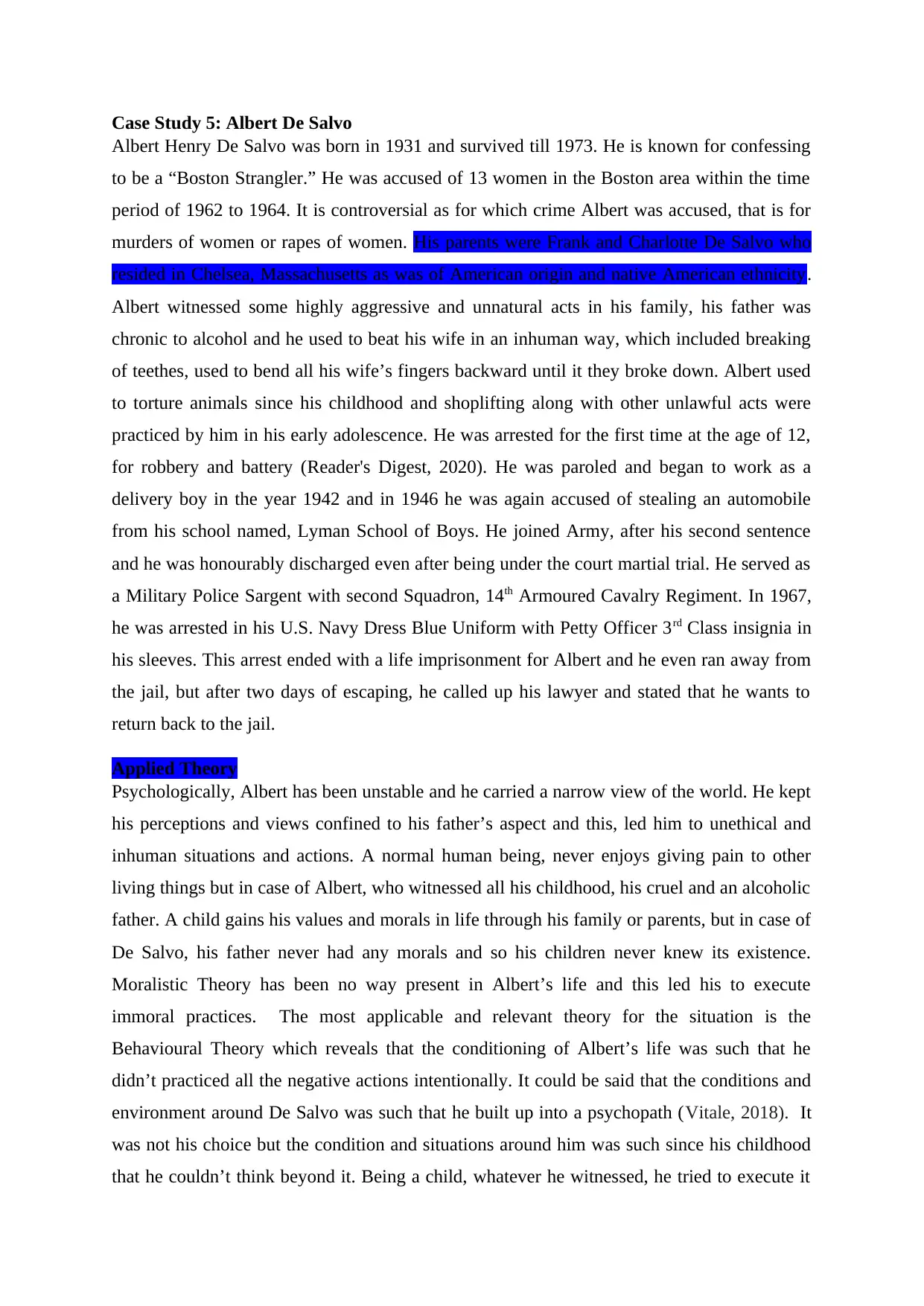
Case Study 5: Albert De Salvo
Albert Henry De Salvo was born in 1931 and survived till 1973. He is known for confessing
to be a “Boston Strangler.” He was accused of 13 women in the Boston area within the time
period of 1962 to 1964. It is controversial as for which crime Albert was accused, that is for
murders of women or rapes of women. His parents were Frank and Charlotte De Salvo who
resided in Chelsea, Massachusetts as was of American origin and native American ethnicity.
Albert witnessed some highly aggressive and unnatural acts in his family, his father was
chronic to alcohol and he used to beat his wife in an inhuman way, which included breaking
of teethes, used to bend all his wife’s fingers backward until it they broke down. Albert used
to torture animals since his childhood and shoplifting along with other unlawful acts were
practiced by him in his early adolescence. He was arrested for the first time at the age of 12,
for robbery and battery (Reader's Digest, 2020). He was paroled and began to work as a
delivery boy in the year 1942 and in 1946 he was again accused of stealing an automobile
from his school named, Lyman School of Boys. He joined Army, after his second sentence
and he was honourably discharged even after being under the court martial trial. He served as
a Military Police Sargent with second Squadron, 14th Armoured Cavalry Regiment. In 1967,
he was arrested in his U.S. Navy Dress Blue Uniform with Petty Officer 3rd Class insignia in
his sleeves. This arrest ended with a life imprisonment for Albert and he even ran away from
the jail, but after two days of escaping, he called up his lawyer and stated that he wants to
return back to the jail.
Applied Theory
Psychologically, Albert has been unstable and he carried a narrow view of the world. He kept
his perceptions and views confined to his father’s aspect and this, led him to unethical and
inhuman situations and actions. A normal human being, never enjoys giving pain to other
living things but in case of Albert, who witnessed all his childhood, his cruel and an alcoholic
father. A child gains his values and morals in life through his family or parents, but in case of
De Salvo, his father never had any morals and so his children never knew its existence.
Moralistic Theory has been no way present in Albert’s life and this led his to execute
immoral practices. The most applicable and relevant theory for the situation is the
Behavioural Theory which reveals that the conditioning of Albert’s life was such that he
didn’t practiced all the negative actions intentionally. It could be said that the conditions and
environment around De Salvo was such that he built up into a psychopath (Vitale, 2018). It
was not his choice but the condition and situations around him was such since his childhood
that he couldn’t think beyond it. Being a child, whatever he witnessed, he tried to execute it
Albert Henry De Salvo was born in 1931 and survived till 1973. He is known for confessing
to be a “Boston Strangler.” He was accused of 13 women in the Boston area within the time
period of 1962 to 1964. It is controversial as for which crime Albert was accused, that is for
murders of women or rapes of women. His parents were Frank and Charlotte De Salvo who
resided in Chelsea, Massachusetts as was of American origin and native American ethnicity.
Albert witnessed some highly aggressive and unnatural acts in his family, his father was
chronic to alcohol and he used to beat his wife in an inhuman way, which included breaking
of teethes, used to bend all his wife’s fingers backward until it they broke down. Albert used
to torture animals since his childhood and shoplifting along with other unlawful acts were
practiced by him in his early adolescence. He was arrested for the first time at the age of 12,
for robbery and battery (Reader's Digest, 2020). He was paroled and began to work as a
delivery boy in the year 1942 and in 1946 he was again accused of stealing an automobile
from his school named, Lyman School of Boys. He joined Army, after his second sentence
and he was honourably discharged even after being under the court martial trial. He served as
a Military Police Sargent with second Squadron, 14th Armoured Cavalry Regiment. In 1967,
he was arrested in his U.S. Navy Dress Blue Uniform with Petty Officer 3rd Class insignia in
his sleeves. This arrest ended with a life imprisonment for Albert and he even ran away from
the jail, but after two days of escaping, he called up his lawyer and stated that he wants to
return back to the jail.
Applied Theory
Psychologically, Albert has been unstable and he carried a narrow view of the world. He kept
his perceptions and views confined to his father’s aspect and this, led him to unethical and
inhuman situations and actions. A normal human being, never enjoys giving pain to other
living things but in case of Albert, who witnessed all his childhood, his cruel and an alcoholic
father. A child gains his values and morals in life through his family or parents, but in case of
De Salvo, his father never had any morals and so his children never knew its existence.
Moralistic Theory has been no way present in Albert’s life and this led his to execute
immoral practices. The most applicable and relevant theory for the situation is the
Behavioural Theory which reveals that the conditioning of Albert’s life was such that he
didn’t practiced all the negative actions intentionally. It could be said that the conditions and
environment around De Salvo was such that he built up into a psychopath (Vitale, 2018). It
was not his choice but the condition and situations around him was such since his childhood
that he couldn’t think beyond it. Being a child, whatever he witnessed, he tried to execute it
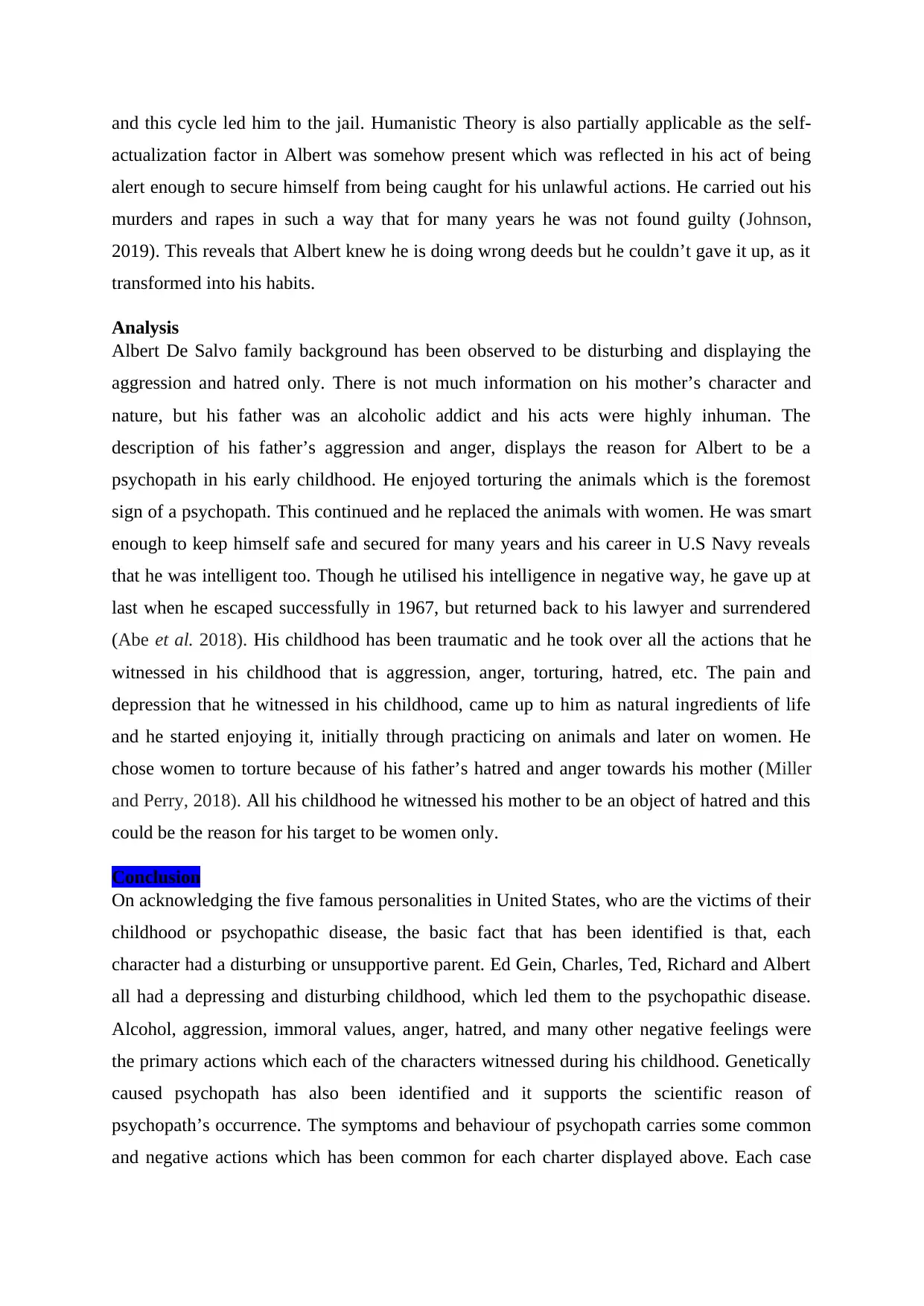
and this cycle led him to the jail. Humanistic Theory is also partially applicable as the self-
actualization factor in Albert was somehow present which was reflected in his act of being
alert enough to secure himself from being caught for his unlawful actions. He carried out his
murders and rapes in such a way that for many years he was not found guilty (Johnson,
2019). This reveals that Albert knew he is doing wrong deeds but he couldn’t gave it up, as it
transformed into his habits.
Analysis
Albert De Salvo family background has been observed to be disturbing and displaying the
aggression and hatred only. There is not much information on his mother’s character and
nature, but his father was an alcoholic addict and his acts were highly inhuman. The
description of his father’s aggression and anger, displays the reason for Albert to be a
psychopath in his early childhood. He enjoyed torturing the animals which is the foremost
sign of a psychopath. This continued and he replaced the animals with women. He was smart
enough to keep himself safe and secured for many years and his career in U.S Navy reveals
that he was intelligent too. Though he utilised his intelligence in negative way, he gave up at
last when he escaped successfully in 1967, but returned back to his lawyer and surrendered
(Abe et al. 2018). His childhood has been traumatic and he took over all the actions that he
witnessed in his childhood that is aggression, anger, torturing, hatred, etc. The pain and
depression that he witnessed in his childhood, came up to him as natural ingredients of life
and he started enjoying it, initially through practicing on animals and later on women. He
chose women to torture because of his father’s hatred and anger towards his mother (Miller
and Perry, 2018). All his childhood he witnessed his mother to be an object of hatred and this
could be the reason for his target to be women only.
Conclusion
On acknowledging the five famous personalities in United States, who are the victims of their
childhood or psychopathic disease, the basic fact that has been identified is that, each
character had a disturbing or unsupportive parent. Ed Gein, Charles, Ted, Richard and Albert
all had a depressing and disturbing childhood, which led them to the psychopathic disease.
Alcohol, aggression, immoral values, anger, hatred, and many other negative feelings were
the primary actions which each of the characters witnessed during his childhood. Genetically
caused psychopath has also been identified and it supports the scientific reason of
psychopath’s occurrence. The symptoms and behaviour of psychopath carries some common
and negative actions which has been common for each charter displayed above. Each case
actualization factor in Albert was somehow present which was reflected in his act of being
alert enough to secure himself from being caught for his unlawful actions. He carried out his
murders and rapes in such a way that for many years he was not found guilty (Johnson,
2019). This reveals that Albert knew he is doing wrong deeds but he couldn’t gave it up, as it
transformed into his habits.
Analysis
Albert De Salvo family background has been observed to be disturbing and displaying the
aggression and hatred only. There is not much information on his mother’s character and
nature, but his father was an alcoholic addict and his acts were highly inhuman. The
description of his father’s aggression and anger, displays the reason for Albert to be a
psychopath in his early childhood. He enjoyed torturing the animals which is the foremost
sign of a psychopath. This continued and he replaced the animals with women. He was smart
enough to keep himself safe and secured for many years and his career in U.S Navy reveals
that he was intelligent too. Though he utilised his intelligence in negative way, he gave up at
last when he escaped successfully in 1967, but returned back to his lawyer and surrendered
(Abe et al. 2018). His childhood has been traumatic and he took over all the actions that he
witnessed in his childhood that is aggression, anger, torturing, hatred, etc. The pain and
depression that he witnessed in his childhood, came up to him as natural ingredients of life
and he started enjoying it, initially through practicing on animals and later on women. He
chose women to torture because of his father’s hatred and anger towards his mother (Miller
and Perry, 2018). All his childhood he witnessed his mother to be an object of hatred and this
could be the reason for his target to be women only.
Conclusion
On acknowledging the five famous personalities in United States, who are the victims of their
childhood or psychopathic disease, the basic fact that has been identified is that, each
character had a disturbing or unsupportive parent. Ed Gein, Charles, Ted, Richard and Albert
all had a depressing and disturbing childhood, which led them to the psychopathic disease.
Alcohol, aggression, immoral values, anger, hatred, and many other negative feelings were
the primary actions which each of the characters witnessed during his childhood. Genetically
caused psychopath has also been identified and it supports the scientific reason of
psychopath’s occurrence. The symptoms and behaviour of psychopath carries some common
and negative actions which has been common for each charter displayed above. Each case
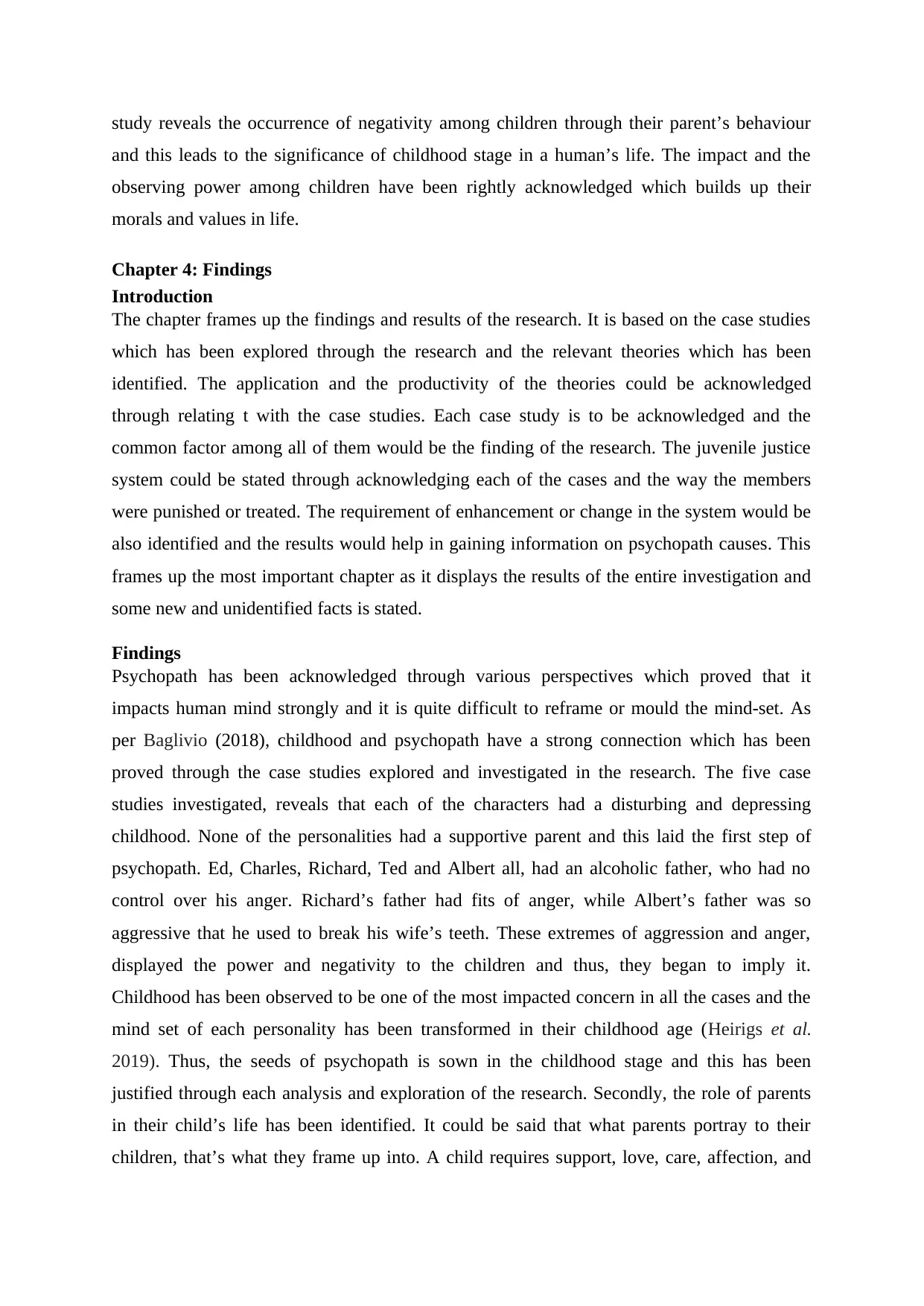
study reveals the occurrence of negativity among children through their parent’s behaviour
and this leads to the significance of childhood stage in a human’s life. The impact and the
observing power among children have been rightly acknowledged which builds up their
morals and values in life.
Chapter 4: Findings
Introduction
The chapter frames up the findings and results of the research. It is based on the case studies
which has been explored through the research and the relevant theories which has been
identified. The application and the productivity of the theories could be acknowledged
through relating t with the case studies. Each case study is to be acknowledged and the
common factor among all of them would be the finding of the research. The juvenile justice
system could be stated through acknowledging each of the cases and the way the members
were punished or treated. The requirement of enhancement or change in the system would be
also identified and the results would help in gaining information on psychopath causes. This
frames up the most important chapter as it displays the results of the entire investigation and
some new and unidentified facts is stated.
Findings
Psychopath has been acknowledged through various perspectives which proved that it
impacts human mind strongly and it is quite difficult to reframe or mould the mind-set. As
per Baglivio (2018), childhood and psychopath have a strong connection which has been
proved through the case studies explored and investigated in the research. The five case
studies investigated, reveals that each of the characters had a disturbing and depressing
childhood. None of the personalities had a supportive parent and this laid the first step of
psychopath. Ed, Charles, Richard, Ted and Albert all, had an alcoholic father, who had no
control over his anger. Richard’s father had fits of anger, while Albert’s father was so
aggressive that he used to break his wife’s teeth. These extremes of aggression and anger,
displayed the power and negativity to the children and thus, they began to imply it.
Childhood has been observed to be one of the most impacted concern in all the cases and the
mind set of each personality has been transformed in their childhood age (Heirigs et al.
2019). Thus, the seeds of psychopath is sown in the childhood stage and this has been
justified through each analysis and exploration of the research. Secondly, the role of parents
in their child’s life has been identified. It could be said that what parents portray to their
children, that’s what they frame up into. A child requires support, love, care, affection, and
and this leads to the significance of childhood stage in a human’s life. The impact and the
observing power among children have been rightly acknowledged which builds up their
morals and values in life.
Chapter 4: Findings
Introduction
The chapter frames up the findings and results of the research. It is based on the case studies
which has been explored through the research and the relevant theories which has been
identified. The application and the productivity of the theories could be acknowledged
through relating t with the case studies. Each case study is to be acknowledged and the
common factor among all of them would be the finding of the research. The juvenile justice
system could be stated through acknowledging each of the cases and the way the members
were punished or treated. The requirement of enhancement or change in the system would be
also identified and the results would help in gaining information on psychopath causes. This
frames up the most important chapter as it displays the results of the entire investigation and
some new and unidentified facts is stated.
Findings
Psychopath has been acknowledged through various perspectives which proved that it
impacts human mind strongly and it is quite difficult to reframe or mould the mind-set. As
per Baglivio (2018), childhood and psychopath have a strong connection which has been
proved through the case studies explored and investigated in the research. The five case
studies investigated, reveals that each of the characters had a disturbing and depressing
childhood. None of the personalities had a supportive parent and this laid the first step of
psychopath. Ed, Charles, Richard, Ted and Albert all, had an alcoholic father, who had no
control over his anger. Richard’s father had fits of anger, while Albert’s father was so
aggressive that he used to break his wife’s teeth. These extremes of aggression and anger,
displayed the power and negativity to the children and thus, they began to imply it.
Childhood has been observed to be one of the most impacted concern in all the cases and the
mind set of each personality has been transformed in their childhood age (Heirigs et al.
2019). Thus, the seeds of psychopath is sown in the childhood stage and this has been
justified through each analysis and exploration of the research. Secondly, the role of parents
in their child’s life has been identified. It could be said that what parents portray to their
children, that’s what they frame up into. A child requires support, love, care, affection, and
Paraphrase This Document
Need a fresh take? Get an instant paraphrase of this document with our AI Paraphraser
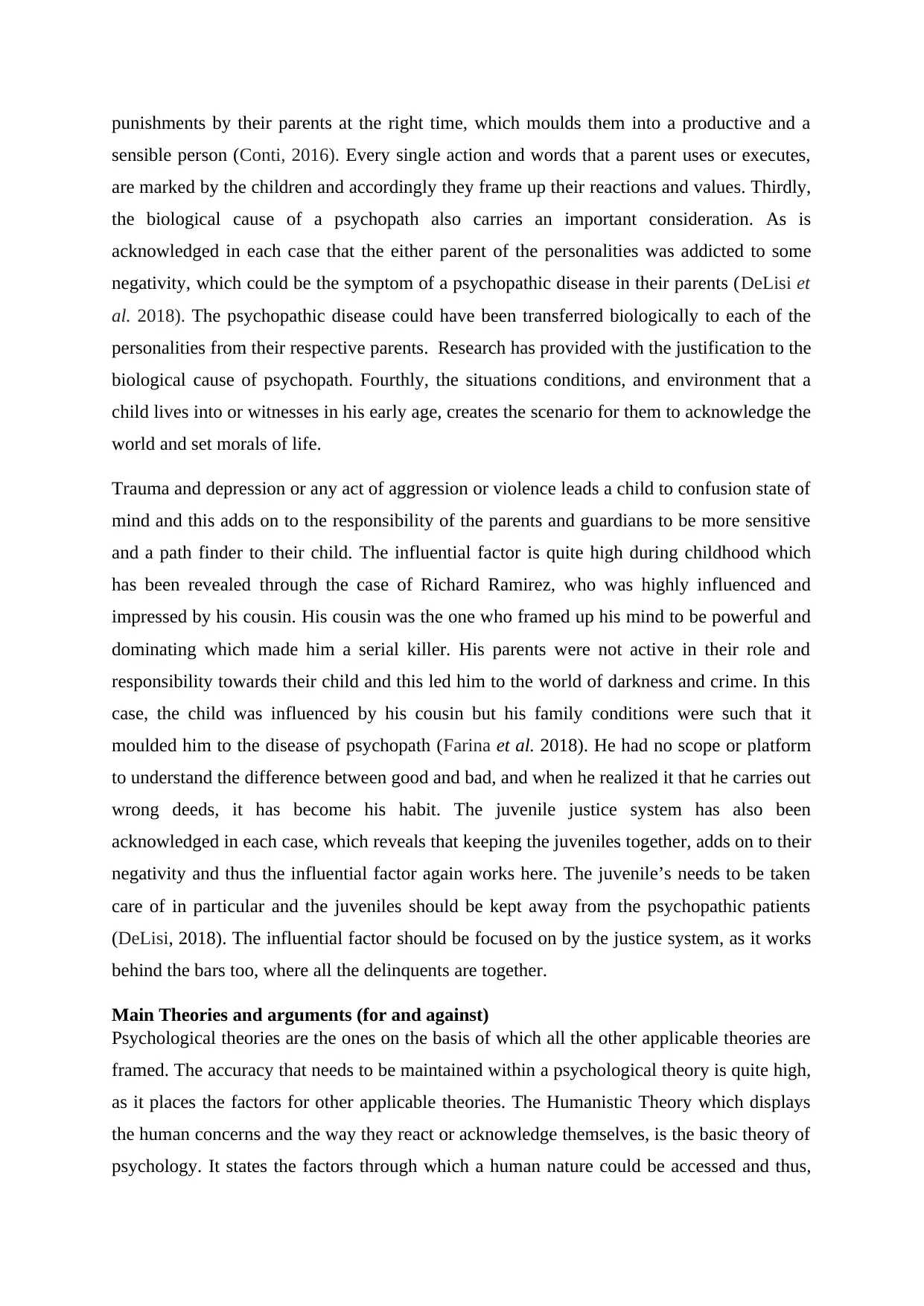
punishments by their parents at the right time, which moulds them into a productive and a
sensible person (Conti, 2016). Every single action and words that a parent uses or executes,
are marked by the children and accordingly they frame up their reactions and values. Thirdly,
the biological cause of a psychopath also carries an important consideration. As is
acknowledged in each case that the either parent of the personalities was addicted to some
negativity, which could be the symptom of a psychopathic disease in their parents (DeLisi et
al. 2018). The psychopathic disease could have been transferred biologically to each of the
personalities from their respective parents. Research has provided with the justification to the
biological cause of psychopath. Fourthly, the situations conditions, and environment that a
child lives into or witnesses in his early age, creates the scenario for them to acknowledge the
world and set morals of life.
Trauma and depression or any act of aggression or violence leads a child to confusion state of
mind and this adds on to the responsibility of the parents and guardians to be more sensitive
and a path finder to their child. The influential factor is quite high during childhood which
has been revealed through the case of Richard Ramirez, who was highly influenced and
impressed by his cousin. His cousin was the one who framed up his mind to be powerful and
dominating which made him a serial killer. His parents were not active in their role and
responsibility towards their child and this led him to the world of darkness and crime. In this
case, the child was influenced by his cousin but his family conditions were such that it
moulded him to the disease of psychopath (Farina et al. 2018). He had no scope or platform
to understand the difference between good and bad, and when he realized it that he carries out
wrong deeds, it has become his habit. The juvenile justice system has also been
acknowledged in each case, which reveals that keeping the juveniles together, adds on to their
negativity and thus the influential factor again works here. The juvenile’s needs to be taken
care of in particular and the juveniles should be kept away from the psychopathic patients
(DeLisi, 2018). The influential factor should be focused on by the justice system, as it works
behind the bars too, where all the delinquents are together.
Main Theories and arguments (for and against)
Psychological theories are the ones on the basis of which all the other applicable theories are
framed. The accuracy that needs to be maintained within a psychological theory is quite high,
as it places the factors for other applicable theories. The Humanistic Theory which displays
the human concerns and the way they react or acknowledge themselves, is the basic theory of
psychology. It states the factors through which a human nature could be accessed and thus,
sensible person (Conti, 2016). Every single action and words that a parent uses or executes,
are marked by the children and accordingly they frame up their reactions and values. Thirdly,
the biological cause of a psychopath also carries an important consideration. As is
acknowledged in each case that the either parent of the personalities was addicted to some
negativity, which could be the symptom of a psychopathic disease in their parents (DeLisi et
al. 2018). The psychopathic disease could have been transferred biologically to each of the
personalities from their respective parents. Research has provided with the justification to the
biological cause of psychopath. Fourthly, the situations conditions, and environment that a
child lives into or witnesses in his early age, creates the scenario for them to acknowledge the
world and set morals of life.
Trauma and depression or any act of aggression or violence leads a child to confusion state of
mind and this adds on to the responsibility of the parents and guardians to be more sensitive
and a path finder to their child. The influential factor is quite high during childhood which
has been revealed through the case of Richard Ramirez, who was highly influenced and
impressed by his cousin. His cousin was the one who framed up his mind to be powerful and
dominating which made him a serial killer. His parents were not active in their role and
responsibility towards their child and this led him to the world of darkness and crime. In this
case, the child was influenced by his cousin but his family conditions were such that it
moulded him to the disease of psychopath (Farina et al. 2018). He had no scope or platform
to understand the difference between good and bad, and when he realized it that he carries out
wrong deeds, it has become his habit. The juvenile justice system has also been
acknowledged in each case, which reveals that keeping the juveniles together, adds on to their
negativity and thus the influential factor again works here. The juvenile’s needs to be taken
care of in particular and the juveniles should be kept away from the psychopathic patients
(DeLisi, 2018). The influential factor should be focused on by the justice system, as it works
behind the bars too, where all the delinquents are together.
Main Theories and arguments (for and against)
Psychological theories are the ones on the basis of which all the other applicable theories are
framed. The accuracy that needs to be maintained within a psychological theory is quite high,
as it places the factors for other applicable theories. The Humanistic Theory which displays
the human concerns and the way they react or acknowledge themselves, is the basic theory of
psychology. It states the factors through which a human nature could be accessed and thus,
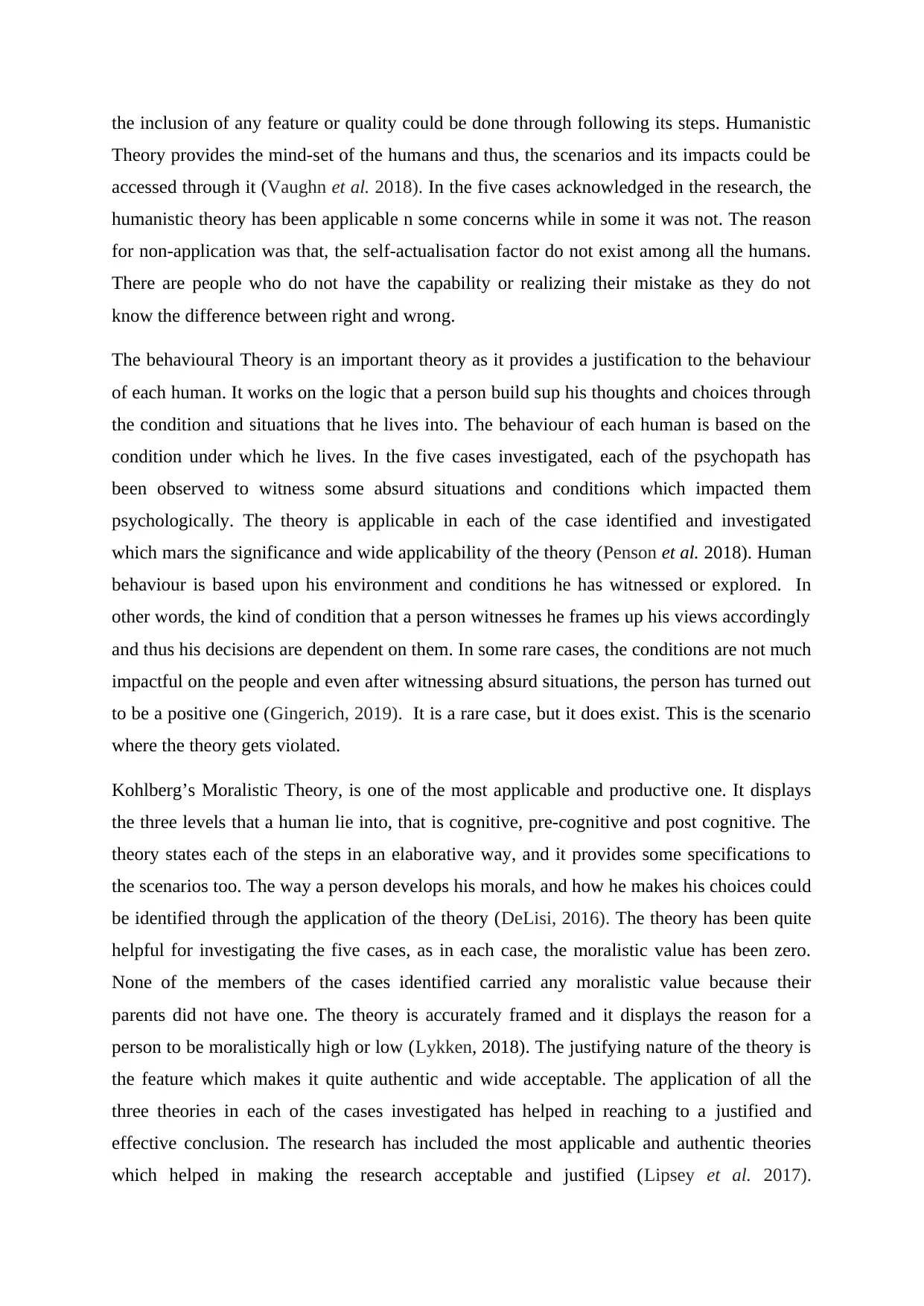
the inclusion of any feature or quality could be done through following its steps. Humanistic
Theory provides the mind-set of the humans and thus, the scenarios and its impacts could be
accessed through it (Vaughn et al. 2018). In the five cases acknowledged in the research, the
humanistic theory has been applicable n some concerns while in some it was not. The reason
for non-application was that, the self-actualisation factor do not exist among all the humans.
There are people who do not have the capability or realizing their mistake as they do not
know the difference between right and wrong.
The behavioural Theory is an important theory as it provides a justification to the behaviour
of each human. It works on the logic that a person build sup his thoughts and choices through
the condition and situations that he lives into. The behaviour of each human is based on the
condition under which he lives. In the five cases investigated, each of the psychopath has
been observed to witness some absurd situations and conditions which impacted them
psychologically. The theory is applicable in each of the case identified and investigated
which mars the significance and wide applicability of the theory (Penson et al. 2018). Human
behaviour is based upon his environment and conditions he has witnessed or explored. In
other words, the kind of condition that a person witnesses he frames up his views accordingly
and thus his decisions are dependent on them. In some rare cases, the conditions are not much
impactful on the people and even after witnessing absurd situations, the person has turned out
to be a positive one (Gingerich, 2019). It is a rare case, but it does exist. This is the scenario
where the theory gets violated.
Kohlberg’s Moralistic Theory, is one of the most applicable and productive one. It displays
the three levels that a human lie into, that is cognitive, pre-cognitive and post cognitive. The
theory states each of the steps in an elaborative way, and it provides some specifications to
the scenarios too. The way a person develops his morals, and how he makes his choices could
be identified through the application of the theory (DeLisi, 2016). The theory has been quite
helpful for investigating the five cases, as in each case, the moralistic value has been zero.
None of the members of the cases identified carried any moralistic value because their
parents did not have one. The theory is accurately framed and it displays the reason for a
person to be moralistically high or low (Lykken, 2018). The justifying nature of the theory is
the feature which makes it quite authentic and wide acceptable. The application of all the
three theories in each of the cases investigated has helped in reaching to a justified and
effective conclusion. The research has included the most applicable and authentic theories
which helped in making the research acceptable and justified (Lipsey et al. 2017).
Theory provides the mind-set of the humans and thus, the scenarios and its impacts could be
accessed through it (Vaughn et al. 2018). In the five cases acknowledged in the research, the
humanistic theory has been applicable n some concerns while in some it was not. The reason
for non-application was that, the self-actualisation factor do not exist among all the humans.
There are people who do not have the capability or realizing their mistake as they do not
know the difference between right and wrong.
The behavioural Theory is an important theory as it provides a justification to the behaviour
of each human. It works on the logic that a person build sup his thoughts and choices through
the condition and situations that he lives into. The behaviour of each human is based on the
condition under which he lives. In the five cases investigated, each of the psychopath has
been observed to witness some absurd situations and conditions which impacted them
psychologically. The theory is applicable in each of the case identified and investigated
which mars the significance and wide applicability of the theory (Penson et al. 2018). Human
behaviour is based upon his environment and conditions he has witnessed or explored. In
other words, the kind of condition that a person witnesses he frames up his views accordingly
and thus his decisions are dependent on them. In some rare cases, the conditions are not much
impactful on the people and even after witnessing absurd situations, the person has turned out
to be a positive one (Gingerich, 2019). It is a rare case, but it does exist. This is the scenario
where the theory gets violated.
Kohlberg’s Moralistic Theory, is one of the most applicable and productive one. It displays
the three levels that a human lie into, that is cognitive, pre-cognitive and post cognitive. The
theory states each of the steps in an elaborative way, and it provides some specifications to
the scenarios too. The way a person develops his morals, and how he makes his choices could
be identified through the application of the theory (DeLisi, 2016). The theory has been quite
helpful for investigating the five cases, as in each case, the moralistic value has been zero.
None of the members of the cases identified carried any moralistic value because their
parents did not have one. The theory is accurately framed and it displays the reason for a
person to be moralistically high or low (Lykken, 2018). The justifying nature of the theory is
the feature which makes it quite authentic and wide acceptable. The application of all the
three theories in each of the cases investigated has helped in reaching to a justified and
effective conclusion. The research has included the most applicable and authentic theories
which helped in making the research acceptable and justified (Lipsey et al. 2017).
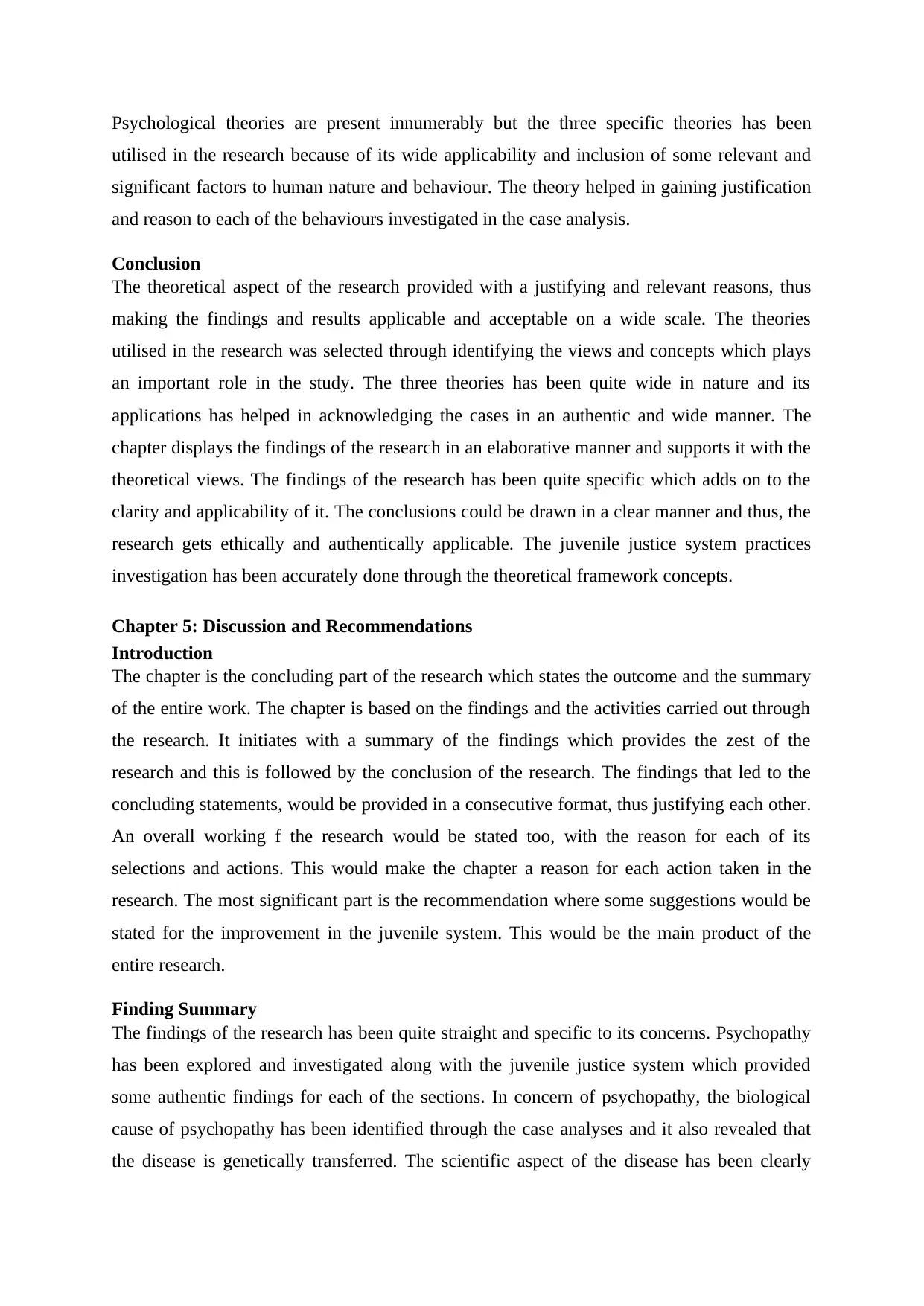
Psychological theories are present innumerably but the three specific theories has been
utilised in the research because of its wide applicability and inclusion of some relevant and
significant factors to human nature and behaviour. The theory helped in gaining justification
and reason to each of the behaviours investigated in the case analysis.
Conclusion
The theoretical aspect of the research provided with a justifying and relevant reasons, thus
making the findings and results applicable and acceptable on a wide scale. The theories
utilised in the research was selected through identifying the views and concepts which plays
an important role in the study. The three theories has been quite wide in nature and its
applications has helped in acknowledging the cases in an authentic and wide manner. The
chapter displays the findings of the research in an elaborative manner and supports it with the
theoretical views. The findings of the research has been quite specific which adds on to the
clarity and applicability of it. The conclusions could be drawn in a clear manner and thus, the
research gets ethically and authentically applicable. The juvenile justice system practices
investigation has been accurately done through the theoretical framework concepts.
Chapter 5: Discussion and Recommendations
Introduction
The chapter is the concluding part of the research which states the outcome and the summary
of the entire work. The chapter is based on the findings and the activities carried out through
the research. It initiates with a summary of the findings which provides the zest of the
research and this is followed by the conclusion of the research. The findings that led to the
concluding statements, would be provided in a consecutive format, thus justifying each other.
An overall working f the research would be stated too, with the reason for each of its
selections and actions. This would make the chapter a reason for each action taken in the
research. The most significant part is the recommendation where some suggestions would be
stated for the improvement in the juvenile system. This would be the main product of the
entire research.
Finding Summary
The findings of the research has been quite straight and specific to its concerns. Psychopathy
has been explored and investigated along with the juvenile justice system which provided
some authentic findings for each of the sections. In concern of psychopathy, the biological
cause of psychopathy has been identified through the case analyses and it also revealed that
the disease is genetically transferred. The scientific aspect of the disease has been clearly
utilised in the research because of its wide applicability and inclusion of some relevant and
significant factors to human nature and behaviour. The theory helped in gaining justification
and reason to each of the behaviours investigated in the case analysis.
Conclusion
The theoretical aspect of the research provided with a justifying and relevant reasons, thus
making the findings and results applicable and acceptable on a wide scale. The theories
utilised in the research was selected through identifying the views and concepts which plays
an important role in the study. The three theories has been quite wide in nature and its
applications has helped in acknowledging the cases in an authentic and wide manner. The
chapter displays the findings of the research in an elaborative manner and supports it with the
theoretical views. The findings of the research has been quite specific which adds on to the
clarity and applicability of it. The conclusions could be drawn in a clear manner and thus, the
research gets ethically and authentically applicable. The juvenile justice system practices
investigation has been accurately done through the theoretical framework concepts.
Chapter 5: Discussion and Recommendations
Introduction
The chapter is the concluding part of the research which states the outcome and the summary
of the entire work. The chapter is based on the findings and the activities carried out through
the research. It initiates with a summary of the findings which provides the zest of the
research and this is followed by the conclusion of the research. The findings that led to the
concluding statements, would be provided in a consecutive format, thus justifying each other.
An overall working f the research would be stated too, with the reason for each of its
selections and actions. This would make the chapter a reason for each action taken in the
research. The most significant part is the recommendation where some suggestions would be
stated for the improvement in the juvenile system. This would be the main product of the
entire research.
Finding Summary
The findings of the research has been quite straight and specific to its concerns. Psychopathy
has been explored and investigated along with the juvenile justice system which provided
some authentic findings for each of the sections. In concern of psychopathy, the biological
cause of psychopathy has been identified through the case analyses and it also revealed that
the disease is genetically transferred. The scientific aspect of the disease has been clearly
Secure Best Marks with AI Grader
Need help grading? Try our AI Grader for instant feedback on your assignments.
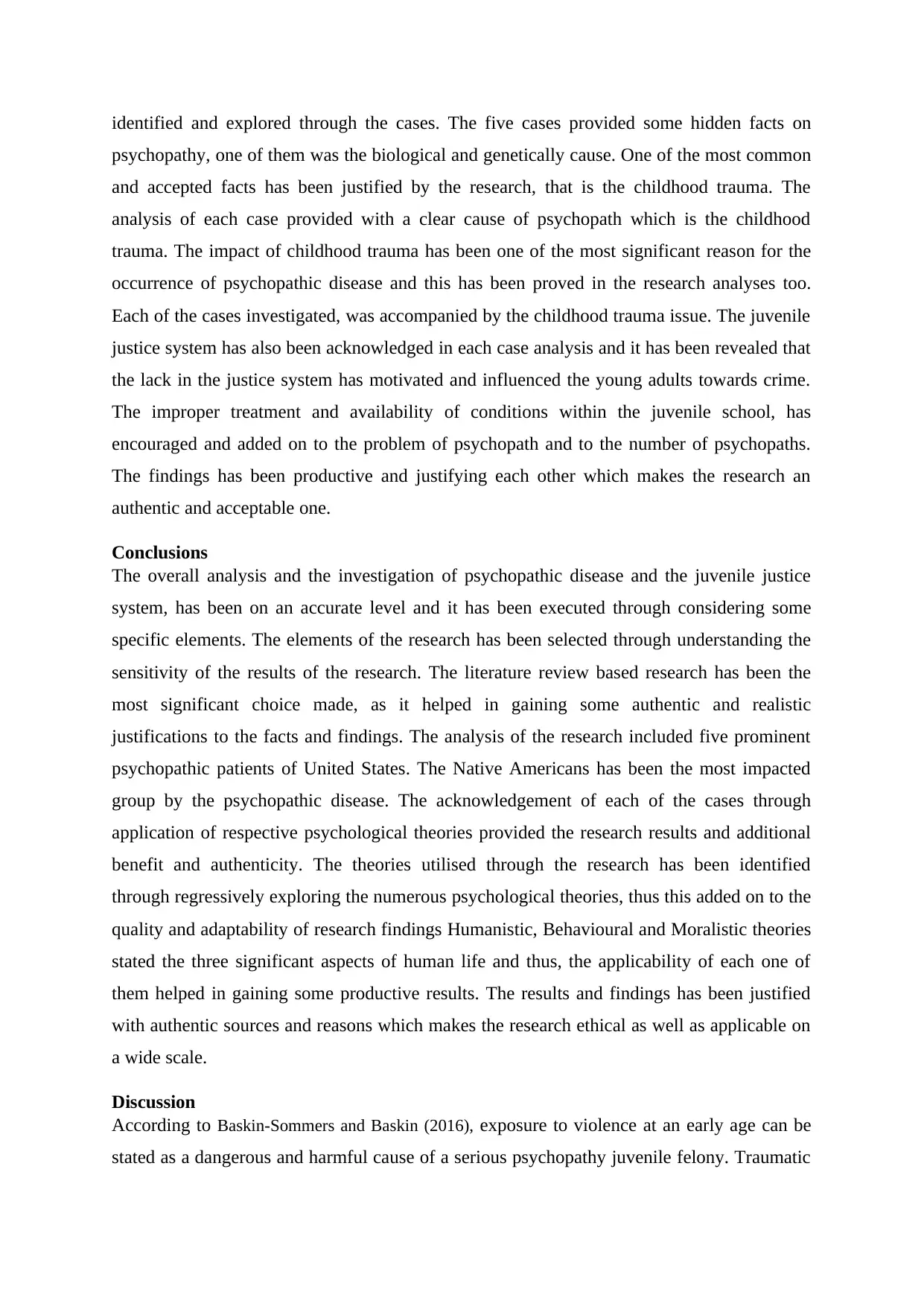
identified and explored through the cases. The five cases provided some hidden facts on
psychopathy, one of them was the biological and genetically cause. One of the most common
and accepted facts has been justified by the research, that is the childhood trauma. The
analysis of each case provided with a clear cause of psychopath which is the childhood
trauma. The impact of childhood trauma has been one of the most significant reason for the
occurrence of psychopathic disease and this has been proved in the research analyses too.
Each of the cases investigated, was accompanied by the childhood trauma issue. The juvenile
justice system has also been acknowledged in each case analysis and it has been revealed that
the lack in the justice system has motivated and influenced the young adults towards crime.
The improper treatment and availability of conditions within the juvenile school, has
encouraged and added on to the problem of psychopath and to the number of psychopaths.
The findings has been productive and justifying each other which makes the research an
authentic and acceptable one.
Conclusions
The overall analysis and the investigation of psychopathic disease and the juvenile justice
system, has been on an accurate level and it has been executed through considering some
specific elements. The elements of the research has been selected through understanding the
sensitivity of the results of the research. The literature review based research has been the
most significant choice made, as it helped in gaining some authentic and realistic
justifications to the facts and findings. The analysis of the research included five prominent
psychopathic patients of United States. The Native Americans has been the most impacted
group by the psychopathic disease. The acknowledgement of each of the cases through
application of respective psychological theories provided the research results and additional
benefit and authenticity. The theories utilised through the research has been identified
through regressively exploring the numerous psychological theories, thus this added on to the
quality and adaptability of research findings Humanistic, Behavioural and Moralistic theories
stated the three significant aspects of human life and thus, the applicability of each one of
them helped in gaining some productive results. The results and findings has been justified
with authentic sources and reasons which makes the research ethical as well as applicable on
a wide scale.
Discussion
According to Baskin-Sommers and Baskin (2016), exposure to violence at an early age can be
stated as a dangerous and harmful cause of a serious psychopathy juvenile felony. Traumatic
psychopathy, one of them was the biological and genetically cause. One of the most common
and accepted facts has been justified by the research, that is the childhood trauma. The
analysis of each case provided with a clear cause of psychopath which is the childhood
trauma. The impact of childhood trauma has been one of the most significant reason for the
occurrence of psychopathic disease and this has been proved in the research analyses too.
Each of the cases investigated, was accompanied by the childhood trauma issue. The juvenile
justice system has also been acknowledged in each case analysis and it has been revealed that
the lack in the justice system has motivated and influenced the young adults towards crime.
The improper treatment and availability of conditions within the juvenile school, has
encouraged and added on to the problem of psychopath and to the number of psychopaths.
The findings has been productive and justifying each other which makes the research an
authentic and acceptable one.
Conclusions
The overall analysis and the investigation of psychopathic disease and the juvenile justice
system, has been on an accurate level and it has been executed through considering some
specific elements. The elements of the research has been selected through understanding the
sensitivity of the results of the research. The literature review based research has been the
most significant choice made, as it helped in gaining some authentic and realistic
justifications to the facts and findings. The analysis of the research included five prominent
psychopathic patients of United States. The Native Americans has been the most impacted
group by the psychopathic disease. The acknowledgement of each of the cases through
application of respective psychological theories provided the research results and additional
benefit and authenticity. The theories utilised through the research has been identified
through regressively exploring the numerous psychological theories, thus this added on to the
quality and adaptability of research findings Humanistic, Behavioural and Moralistic theories
stated the three significant aspects of human life and thus, the applicability of each one of
them helped in gaining some productive results. The results and findings has been justified
with authentic sources and reasons which makes the research ethical as well as applicable on
a wide scale.
Discussion
According to Baskin-Sommers and Baskin (2016), exposure to violence at an early age can be
stated as a dangerous and harmful cause of a serious psychopathy juvenile felony. Traumatic
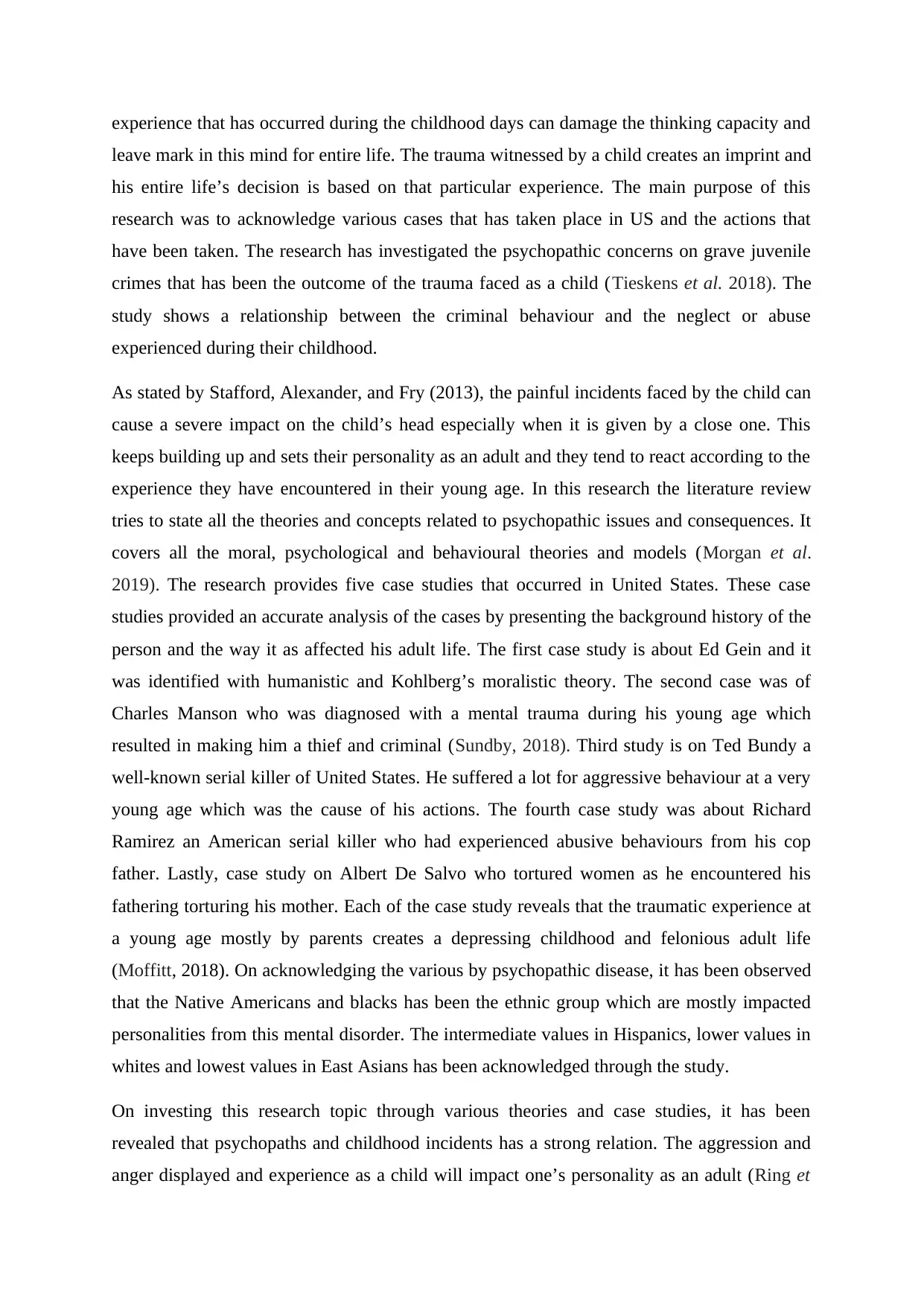
experience that has occurred during the childhood days can damage the thinking capacity and
leave mark in this mind for entire life. The trauma witnessed by a child creates an imprint and
his entire life’s decision is based on that particular experience. The main purpose of this
research was to acknowledge various cases that has taken place in US and the actions that
have been taken. The research has investigated the psychopathic concerns on grave juvenile
crimes that has been the outcome of the trauma faced as a child (Tieskens et al. 2018). The
study shows a relationship between the criminal behaviour and the neglect or abuse
experienced during their childhood.
As stated by Stafford, Alexander, and Fry (2013), the painful incidents faced by the child can
cause a severe impact on the child’s head especially when it is given by a close one. This
keeps building up and sets their personality as an adult and they tend to react according to the
experience they have encountered in their young age. In this research the literature review
tries to state all the theories and concepts related to psychopathic issues and consequences. It
covers all the moral, psychological and behavioural theories and models (Morgan et al.
2019). The research provides five case studies that occurred in United States. These case
studies provided an accurate analysis of the cases by presenting the background history of the
person and the way it as affected his adult life. The first case study is about Ed Gein and it
was identified with humanistic and Kohlberg’s moralistic theory. The second case was of
Charles Manson who was diagnosed with a mental trauma during his young age which
resulted in making him a thief and criminal (Sundby, 2018). Third study is on Ted Bundy a
well-known serial killer of United States. He suffered a lot for aggressive behaviour at a very
young age which was the cause of his actions. The fourth case study was about Richard
Ramirez an American serial killer who had experienced abusive behaviours from his cop
father. Lastly, case study on Albert De Salvo who tortured women as he encountered his
fathering torturing his mother. Each of the case study reveals that the traumatic experience at
a young age mostly by parents creates a depressing childhood and felonious adult life
(Moffitt, 2018). On acknowledging the various by psychopathic disease, it has been observed
that the Native Americans and blacks has been the ethnic group which are mostly impacted
personalities from this mental disorder. The intermediate values in Hispanics, lower values in
whites and lowest values in East Asians has been acknowledged through the study.
On investing this research topic through various theories and case studies, it has been
revealed that psychopaths and childhood incidents has a strong relation. The aggression and
anger displayed and experience as a child will impact one’s personality as an adult (Ring et
leave mark in this mind for entire life. The trauma witnessed by a child creates an imprint and
his entire life’s decision is based on that particular experience. The main purpose of this
research was to acknowledge various cases that has taken place in US and the actions that
have been taken. The research has investigated the psychopathic concerns on grave juvenile
crimes that has been the outcome of the trauma faced as a child (Tieskens et al. 2018). The
study shows a relationship between the criminal behaviour and the neglect or abuse
experienced during their childhood.
As stated by Stafford, Alexander, and Fry (2013), the painful incidents faced by the child can
cause a severe impact on the child’s head especially when it is given by a close one. This
keeps building up and sets their personality as an adult and they tend to react according to the
experience they have encountered in their young age. In this research the literature review
tries to state all the theories and concepts related to psychopathic issues and consequences. It
covers all the moral, psychological and behavioural theories and models (Morgan et al.
2019). The research provides five case studies that occurred in United States. These case
studies provided an accurate analysis of the cases by presenting the background history of the
person and the way it as affected his adult life. The first case study is about Ed Gein and it
was identified with humanistic and Kohlberg’s moralistic theory. The second case was of
Charles Manson who was diagnosed with a mental trauma during his young age which
resulted in making him a thief and criminal (Sundby, 2018). Third study is on Ted Bundy a
well-known serial killer of United States. He suffered a lot for aggressive behaviour at a very
young age which was the cause of his actions. The fourth case study was about Richard
Ramirez an American serial killer who had experienced abusive behaviours from his cop
father. Lastly, case study on Albert De Salvo who tortured women as he encountered his
fathering torturing his mother. Each of the case study reveals that the traumatic experience at
a young age mostly by parents creates a depressing childhood and felonious adult life
(Moffitt, 2018). On acknowledging the various by psychopathic disease, it has been observed
that the Native Americans and blacks has been the ethnic group which are mostly impacted
personalities from this mental disorder. The intermediate values in Hispanics, lower values in
whites and lowest values in East Asians has been acknowledged through the study.
On investing this research topic through various theories and case studies, it has been
revealed that psychopaths and childhood incidents has a strong relation. The aggression and
anger displayed and experience as a child will impact one’s personality as an adult (Ring et
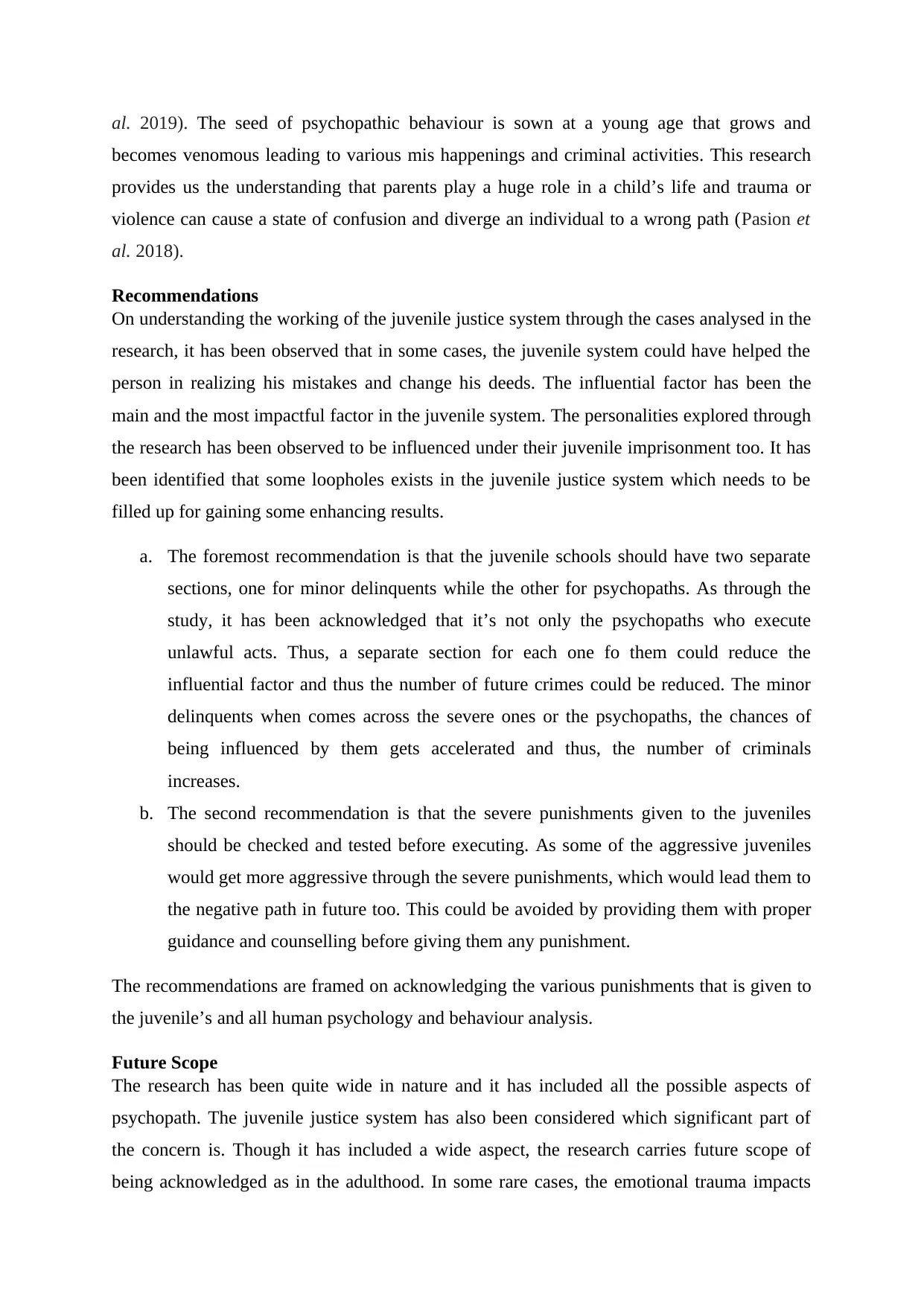
al. 2019). The seed of psychopathic behaviour is sown at a young age that grows and
becomes venomous leading to various mis happenings and criminal activities. This research
provides us the understanding that parents play a huge role in a child’s life and trauma or
violence can cause a state of confusion and diverge an individual to a wrong path (Pasion et
al. 2018).
Recommendations
On understanding the working of the juvenile justice system through the cases analysed in the
research, it has been observed that in some cases, the juvenile system could have helped the
person in realizing his mistakes and change his deeds. The influential factor has been the
main and the most impactful factor in the juvenile system. The personalities explored through
the research has been observed to be influenced under their juvenile imprisonment too. It has
been identified that some loopholes exists in the juvenile justice system which needs to be
filled up for gaining some enhancing results.
a. The foremost recommendation is that the juvenile schools should have two separate
sections, one for minor delinquents while the other for psychopaths. As through the
study, it has been acknowledged that it’s not only the psychopaths who execute
unlawful acts. Thus, a separate section for each one fo them could reduce the
influential factor and thus the number of future crimes could be reduced. The minor
delinquents when comes across the severe ones or the psychopaths, the chances of
being influenced by them gets accelerated and thus, the number of criminals
increases.
b. The second recommendation is that the severe punishments given to the juveniles
should be checked and tested before executing. As some of the aggressive juveniles
would get more aggressive through the severe punishments, which would lead them to
the negative path in future too. This could be avoided by providing them with proper
guidance and counselling before giving them any punishment.
The recommendations are framed on acknowledging the various punishments that is given to
the juvenile’s and all human psychology and behaviour analysis.
Future Scope
The research has been quite wide in nature and it has included all the possible aspects of
psychopath. The juvenile justice system has also been considered which significant part of
the concern is. Though it has included a wide aspect, the research carries future scope of
being acknowledged as in the adulthood. In some rare cases, the emotional trauma impacts
becomes venomous leading to various mis happenings and criminal activities. This research
provides us the understanding that parents play a huge role in a child’s life and trauma or
violence can cause a state of confusion and diverge an individual to a wrong path (Pasion et
al. 2018).
Recommendations
On understanding the working of the juvenile justice system through the cases analysed in the
research, it has been observed that in some cases, the juvenile system could have helped the
person in realizing his mistakes and change his deeds. The influential factor has been the
main and the most impactful factor in the juvenile system. The personalities explored through
the research has been observed to be influenced under their juvenile imprisonment too. It has
been identified that some loopholes exists in the juvenile justice system which needs to be
filled up for gaining some enhancing results.
a. The foremost recommendation is that the juvenile schools should have two separate
sections, one for minor delinquents while the other for psychopaths. As through the
study, it has been acknowledged that it’s not only the psychopaths who execute
unlawful acts. Thus, a separate section for each one fo them could reduce the
influential factor and thus the number of future crimes could be reduced. The minor
delinquents when comes across the severe ones or the psychopaths, the chances of
being influenced by them gets accelerated and thus, the number of criminals
increases.
b. The second recommendation is that the severe punishments given to the juveniles
should be checked and tested before executing. As some of the aggressive juveniles
would get more aggressive through the severe punishments, which would lead them to
the negative path in future too. This could be avoided by providing them with proper
guidance and counselling before giving them any punishment.
The recommendations are framed on acknowledging the various punishments that is given to
the juvenile’s and all human psychology and behaviour analysis.
Future Scope
The research has been quite wide in nature and it has included all the possible aspects of
psychopath. The juvenile justice system has also been considered which significant part of
the concern is. Though it has included a wide aspect, the research carries future scope of
being acknowledged as in the adulthood. In some rare cases, the emotional trauma impacts
Paraphrase This Document
Need a fresh take? Get an instant paraphrase of this document with our AI Paraphraser
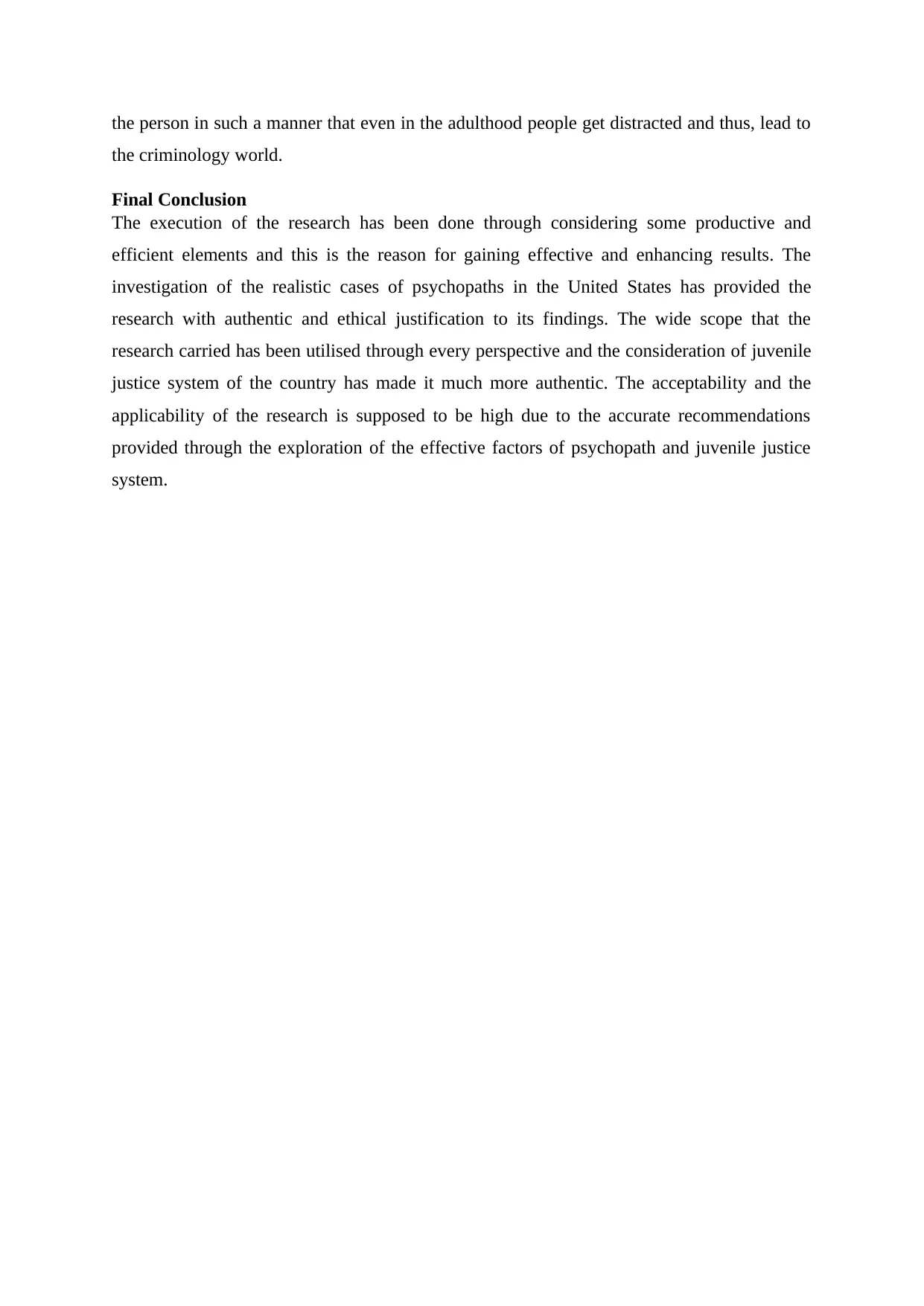
the person in such a manner that even in the adulthood people get distracted and thus, lead to
the criminology world.
Final Conclusion
The execution of the research has been done through considering some productive and
efficient elements and this is the reason for gaining effective and enhancing results. The
investigation of the realistic cases of psychopaths in the United States has provided the
research with authentic and ethical justification to its findings. The wide scope that the
research carried has been utilised through every perspective and the consideration of juvenile
justice system of the country has made it much more authentic. The acceptability and the
applicability of the research is supposed to be high due to the accurate recommendations
provided through the exploration of the effective factors of psychopath and juvenile justice
system.
the criminology world.
Final Conclusion
The execution of the research has been done through considering some productive and
efficient elements and this is the reason for gaining effective and enhancing results. The
investigation of the realistic cases of psychopaths in the United States has provided the
research with authentic and ethical justification to its findings. The wide scope that the
research carried has been utilised through every perspective and the consideration of juvenile
justice system of the country has made it much more authentic. The acceptability and the
applicability of the research is supposed to be high due to the accurate recommendations
provided through the exploration of the effective factors of psychopath and juvenile justice
system.
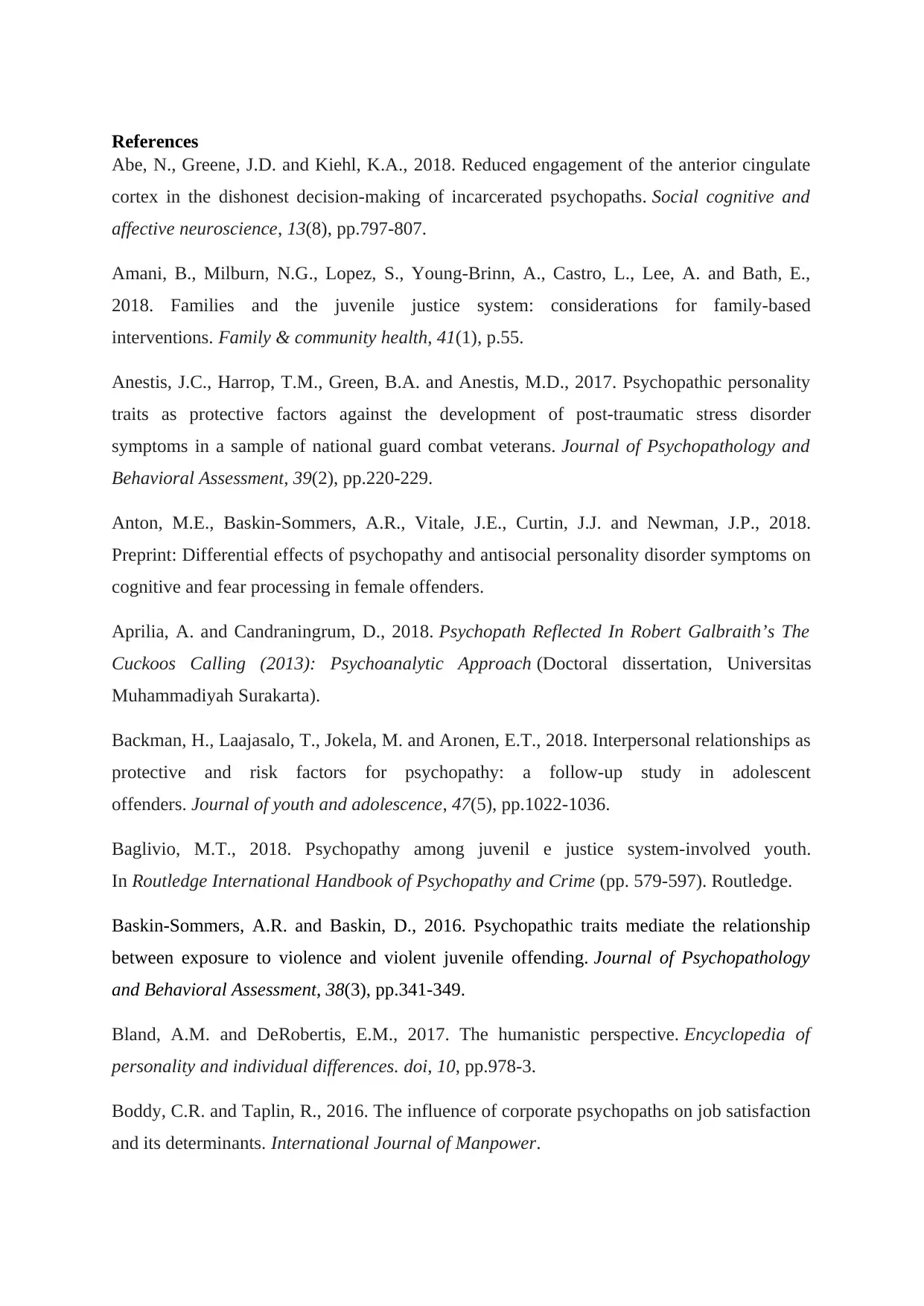
References
Abe, N., Greene, J.D. and Kiehl, K.A., 2018. Reduced engagement of the anterior cingulate
cortex in the dishonest decision-making of incarcerated psychopaths. Social cognitive and
affective neuroscience, 13(8), pp.797-807.
Amani, B., Milburn, N.G., Lopez, S., Young-Brinn, A., Castro, L., Lee, A. and Bath, E.,
2018. Families and the juvenile justice system: considerations for family-based
interventions. Family & community health, 41(1), p.55.
Anestis, J.C., Harrop, T.M., Green, B.A. and Anestis, M.D., 2017. Psychopathic personality
traits as protective factors against the development of post-traumatic stress disorder
symptoms in a sample of national guard combat veterans. Journal of Psychopathology and
Behavioral Assessment, 39(2), pp.220-229.
Anton, M.E., Baskin-Sommers, A.R., Vitale, J.E., Curtin, J.J. and Newman, J.P., 2018.
Preprint: Differential effects of psychopathy and antisocial personality disorder symptoms on
cognitive and fear processing in female offenders.
Aprilia, A. and Candraningrum, D., 2018. Psychopath Reflected In Robert Galbraith’s The
Cuckoos Calling (2013): Psychoanalytic Approach (Doctoral dissertation, Universitas
Muhammadiyah Surakarta).
Backman, H., Laajasalo, T., Jokela, M. and Aronen, E.T., 2018. Interpersonal relationships as
protective and risk factors for psychopathy: a follow-up study in adolescent
offenders. Journal of youth and adolescence, 47(5), pp.1022-1036.
Baglivio, M.T., 2018. Psychopathy among juvenil e justice system-involved youth.
In Routledge International Handbook of Psychopathy and Crime (pp. 579-597). Routledge.
Baskin-Sommers, A.R. and Baskin, D., 2016. Psychopathic traits mediate the relationship
between exposure to violence and violent juvenile offending. Journal of Psychopathology
and Behavioral Assessment, 38(3), pp.341-349.
Bland, A.M. and DeRobertis, E.M., 2017. The humanistic perspective. Encyclopedia of
personality and individual differences. doi, 10, pp.978-3.
Boddy, C.R. and Taplin, R., 2016. The influence of corporate psychopaths on job satisfaction
and its determinants. International Journal of Manpower.
Abe, N., Greene, J.D. and Kiehl, K.A., 2018. Reduced engagement of the anterior cingulate
cortex in the dishonest decision-making of incarcerated psychopaths. Social cognitive and
affective neuroscience, 13(8), pp.797-807.
Amani, B., Milburn, N.G., Lopez, S., Young-Brinn, A., Castro, L., Lee, A. and Bath, E.,
2018. Families and the juvenile justice system: considerations for family-based
interventions. Family & community health, 41(1), p.55.
Anestis, J.C., Harrop, T.M., Green, B.A. and Anestis, M.D., 2017. Psychopathic personality
traits as protective factors against the development of post-traumatic stress disorder
symptoms in a sample of national guard combat veterans. Journal of Psychopathology and
Behavioral Assessment, 39(2), pp.220-229.
Anton, M.E., Baskin-Sommers, A.R., Vitale, J.E., Curtin, J.J. and Newman, J.P., 2018.
Preprint: Differential effects of psychopathy and antisocial personality disorder symptoms on
cognitive and fear processing in female offenders.
Aprilia, A. and Candraningrum, D., 2018. Psychopath Reflected In Robert Galbraith’s The
Cuckoos Calling (2013): Psychoanalytic Approach (Doctoral dissertation, Universitas
Muhammadiyah Surakarta).
Backman, H., Laajasalo, T., Jokela, M. and Aronen, E.T., 2018. Interpersonal relationships as
protective and risk factors for psychopathy: a follow-up study in adolescent
offenders. Journal of youth and adolescence, 47(5), pp.1022-1036.
Baglivio, M.T., 2018. Psychopathy among juvenil e justice system-involved youth.
In Routledge International Handbook of Psychopathy and Crime (pp. 579-597). Routledge.
Baskin-Sommers, A.R. and Baskin, D., 2016. Psychopathic traits mediate the relationship
between exposure to violence and violent juvenile offending. Journal of Psychopathology
and Behavioral Assessment, 38(3), pp.341-349.
Bland, A.M. and DeRobertis, E.M., 2017. The humanistic perspective. Encyclopedia of
personality and individual differences. doi, 10, pp.978-3.
Boddy, C.R. and Taplin, R., 2016. The influence of corporate psychopaths on job satisfaction
and its determinants. International Journal of Manpower.
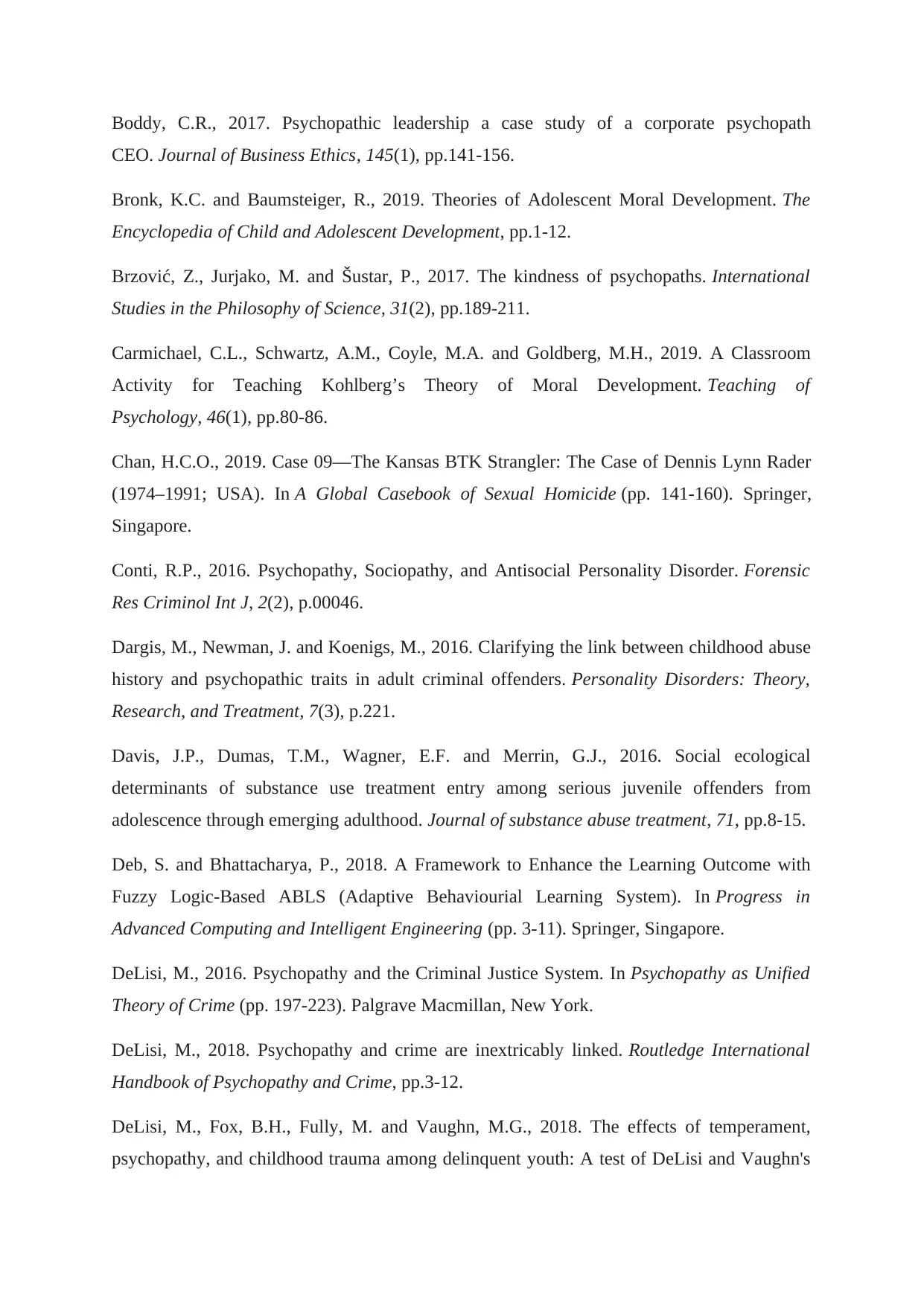
Boddy, C.R., 2017. Psychopathic leadership a case study of a corporate psychopath
CEO. Journal of Business Ethics, 145(1), pp.141-156.
Bronk, K.C. and Baumsteiger, R., 2019. Theories of Adolescent Moral Development. The
Encyclopedia of Child and Adolescent Development, pp.1-12.
Brzović, Z., Jurjako, M. and Šustar, P., 2017. The kindness of psychopaths. International
Studies in the Philosophy of Science, 31(2), pp.189-211.
Carmichael, C.L., Schwartz, A.M., Coyle, M.A. and Goldberg, M.H., 2019. A Classroom
Activity for Teaching Kohlberg’s Theory of Moral Development. Teaching of
Psychology, 46(1), pp.80-86.
Chan, H.C.O., 2019. Case 09—The Kansas BTK Strangler: The Case of Dennis Lynn Rader
(1974–1991; USA). In A Global Casebook of Sexual Homicide (pp. 141-160). Springer,
Singapore.
Conti, R.P., 2016. Psychopathy, Sociopathy, and Antisocial Personality Disorder. Forensic
Res Criminol Int J, 2(2), p.00046.
Dargis, M., Newman, J. and Koenigs, M., 2016. Clarifying the link between childhood abuse
history and psychopathic traits in adult criminal offenders. Personality Disorders: Theory,
Research, and Treatment, 7(3), p.221.
Davis, J.P., Dumas, T.M., Wagner, E.F. and Merrin, G.J., 2016. Social ecological
determinants of substance use treatment entry among serious juvenile offenders from
adolescence through emerging adulthood. Journal of substance abuse treatment, 71, pp.8-15.
Deb, S. and Bhattacharya, P., 2018. A Framework to Enhance the Learning Outcome with
Fuzzy Logic-Based ABLS (Adaptive Behaviourial Learning System). In Progress in
Advanced Computing and Intelligent Engineering (pp. 3-11). Springer, Singapore.
DeLisi, M., 2016. Psychopathy and the Criminal Justice System. In Psychopathy as Unified
Theory of Crime (pp. 197-223). Palgrave Macmillan, New York.
DeLisi, M., 2018. Psychopathy and crime are inextricably linked. Routledge International
Handbook of Psychopathy and Crime, pp.3-12.
DeLisi, M., Fox, B.H., Fully, M. and Vaughn, M.G., 2018. The effects of temperament,
psychopathy, and childhood trauma among delinquent youth: A test of DeLisi and Vaughn's
CEO. Journal of Business Ethics, 145(1), pp.141-156.
Bronk, K.C. and Baumsteiger, R., 2019. Theories of Adolescent Moral Development. The
Encyclopedia of Child and Adolescent Development, pp.1-12.
Brzović, Z., Jurjako, M. and Šustar, P., 2017. The kindness of psychopaths. International
Studies in the Philosophy of Science, 31(2), pp.189-211.
Carmichael, C.L., Schwartz, A.M., Coyle, M.A. and Goldberg, M.H., 2019. A Classroom
Activity for Teaching Kohlberg’s Theory of Moral Development. Teaching of
Psychology, 46(1), pp.80-86.
Chan, H.C.O., 2019. Case 09—The Kansas BTK Strangler: The Case of Dennis Lynn Rader
(1974–1991; USA). In A Global Casebook of Sexual Homicide (pp. 141-160). Springer,
Singapore.
Conti, R.P., 2016. Psychopathy, Sociopathy, and Antisocial Personality Disorder. Forensic
Res Criminol Int J, 2(2), p.00046.
Dargis, M., Newman, J. and Koenigs, M., 2016. Clarifying the link between childhood abuse
history and psychopathic traits in adult criminal offenders. Personality Disorders: Theory,
Research, and Treatment, 7(3), p.221.
Davis, J.P., Dumas, T.M., Wagner, E.F. and Merrin, G.J., 2016. Social ecological
determinants of substance use treatment entry among serious juvenile offenders from
adolescence through emerging adulthood. Journal of substance abuse treatment, 71, pp.8-15.
Deb, S. and Bhattacharya, P., 2018. A Framework to Enhance the Learning Outcome with
Fuzzy Logic-Based ABLS (Adaptive Behaviourial Learning System). In Progress in
Advanced Computing and Intelligent Engineering (pp. 3-11). Springer, Singapore.
DeLisi, M., 2016. Psychopathy and the Criminal Justice System. In Psychopathy as Unified
Theory of Crime (pp. 197-223). Palgrave Macmillan, New York.
DeLisi, M., 2018. Psychopathy and crime are inextricably linked. Routledge International
Handbook of Psychopathy and Crime, pp.3-12.
DeLisi, M., Fox, B.H., Fully, M. and Vaughn, M.G., 2018. The effects of temperament,
psychopathy, and childhood trauma among delinquent youth: A test of DeLisi and Vaughn's
Secure Best Marks with AI Grader
Need help grading? Try our AI Grader for instant feedback on your assignments.
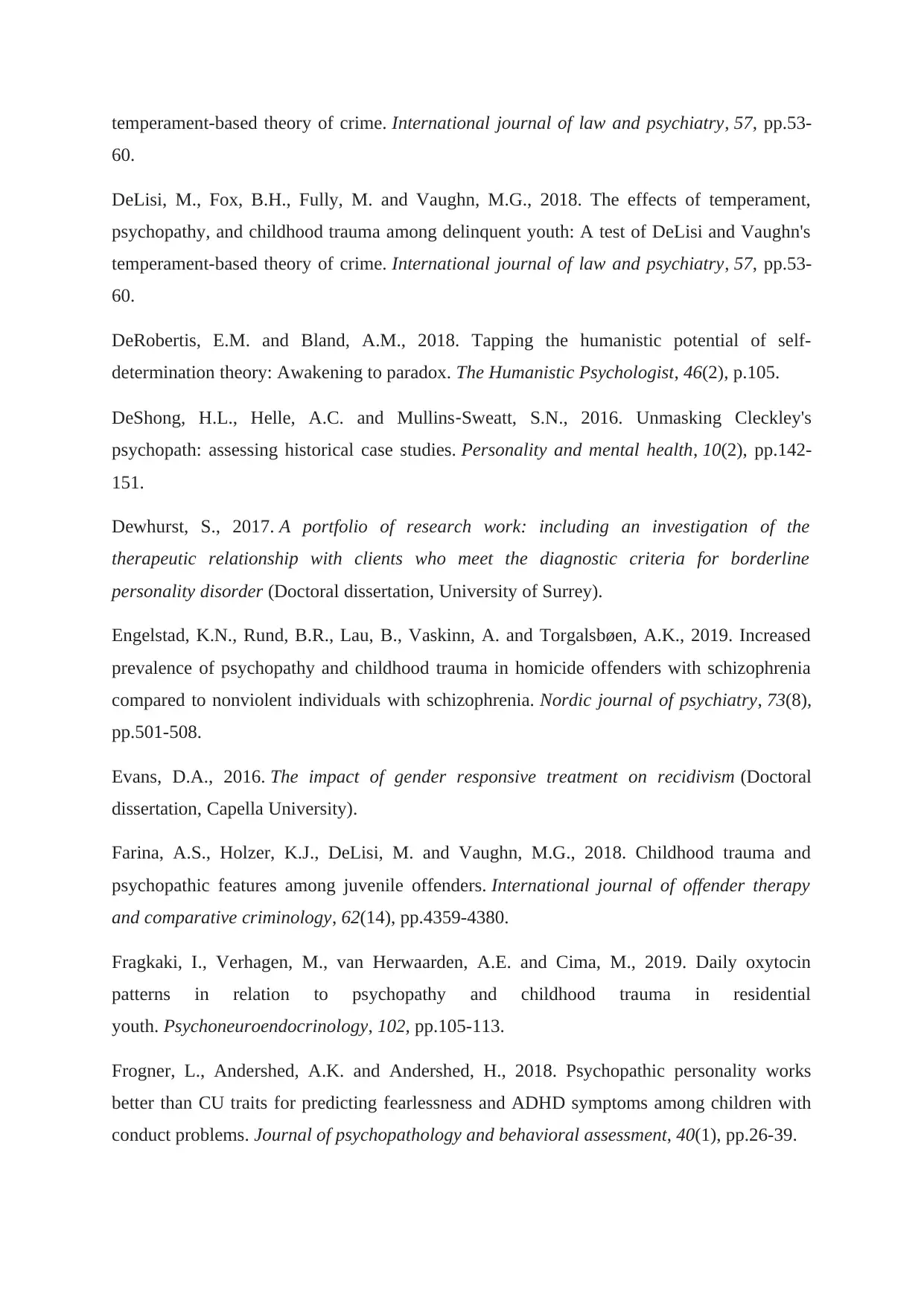
temperament-based theory of crime. International journal of law and psychiatry, 57, pp.53-
60.
DeLisi, M., Fox, B.H., Fully, M. and Vaughn, M.G., 2018. The effects of temperament,
psychopathy, and childhood trauma among delinquent youth: A test of DeLisi and Vaughn's
temperament-based theory of crime. International journal of law and psychiatry, 57, pp.53-
60.
DeRobertis, E.M. and Bland, A.M., 2018. Tapping the humanistic potential of self-
determination theory: Awakening to paradox. The Humanistic Psychologist, 46(2), p.105.
DeShong, H.L., Helle, A.C. and Mullins‐Sweatt, S.N., 2016. Unmasking Cleckley's
psychopath: assessing historical case studies. Personality and mental health, 10(2), pp.142-
151.
Dewhurst, S., 2017. A portfolio of research work: including an investigation of the
therapeutic relationship with clients who meet the diagnostic criteria for borderline
personality disorder (Doctoral dissertation, University of Surrey).
Engelstad, K.N., Rund, B.R., Lau, B., Vaskinn, A. and Torgalsbøen, A.K., 2019. Increased
prevalence of psychopathy and childhood trauma in homicide offenders with schizophrenia
compared to nonviolent individuals with schizophrenia. Nordic journal of psychiatry, 73(8),
pp.501-508.
Evans, D.A., 2016. The impact of gender responsive treatment on recidivism (Doctoral
dissertation, Capella University).
Farina, A.S., Holzer, K.J., DeLisi, M. and Vaughn, M.G., 2018. Childhood trauma and
psychopathic features among juvenile offenders. International journal of offender therapy
and comparative criminology, 62(14), pp.4359-4380.
Fragkaki, I., Verhagen, M., van Herwaarden, A.E. and Cima, M., 2019. Daily oxytocin
patterns in relation to psychopathy and childhood trauma in residential
youth. Psychoneuroendocrinology, 102, pp.105-113.
Frogner, L., Andershed, A.K. and Andershed, H., 2018. Psychopathic personality works
better than CU traits for predicting fearlessness and ADHD symptoms among children with
conduct problems. Journal of psychopathology and behavioral assessment, 40(1), pp.26-39.
60.
DeLisi, M., Fox, B.H., Fully, M. and Vaughn, M.G., 2018. The effects of temperament,
psychopathy, and childhood trauma among delinquent youth: A test of DeLisi and Vaughn's
temperament-based theory of crime. International journal of law and psychiatry, 57, pp.53-
60.
DeRobertis, E.M. and Bland, A.M., 2018. Tapping the humanistic potential of self-
determination theory: Awakening to paradox. The Humanistic Psychologist, 46(2), p.105.
DeShong, H.L., Helle, A.C. and Mullins‐Sweatt, S.N., 2016. Unmasking Cleckley's
psychopath: assessing historical case studies. Personality and mental health, 10(2), pp.142-
151.
Dewhurst, S., 2017. A portfolio of research work: including an investigation of the
therapeutic relationship with clients who meet the diagnostic criteria for borderline
personality disorder (Doctoral dissertation, University of Surrey).
Engelstad, K.N., Rund, B.R., Lau, B., Vaskinn, A. and Torgalsbøen, A.K., 2019. Increased
prevalence of psychopathy and childhood trauma in homicide offenders with schizophrenia
compared to nonviolent individuals with schizophrenia. Nordic journal of psychiatry, 73(8),
pp.501-508.
Evans, D.A., 2016. The impact of gender responsive treatment on recidivism (Doctoral
dissertation, Capella University).
Farina, A.S., Holzer, K.J., DeLisi, M. and Vaughn, M.G., 2018. Childhood trauma and
psychopathic features among juvenile offenders. International journal of offender therapy
and comparative criminology, 62(14), pp.4359-4380.
Fragkaki, I., Verhagen, M., van Herwaarden, A.E. and Cima, M., 2019. Daily oxytocin
patterns in relation to psychopathy and childhood trauma in residential
youth. Psychoneuroendocrinology, 102, pp.105-113.
Frogner, L., Andershed, A.K. and Andershed, H., 2018. Psychopathic personality works
better than CU traits for predicting fearlessness and ADHD symptoms among children with
conduct problems. Journal of psychopathology and behavioral assessment, 40(1), pp.26-39.
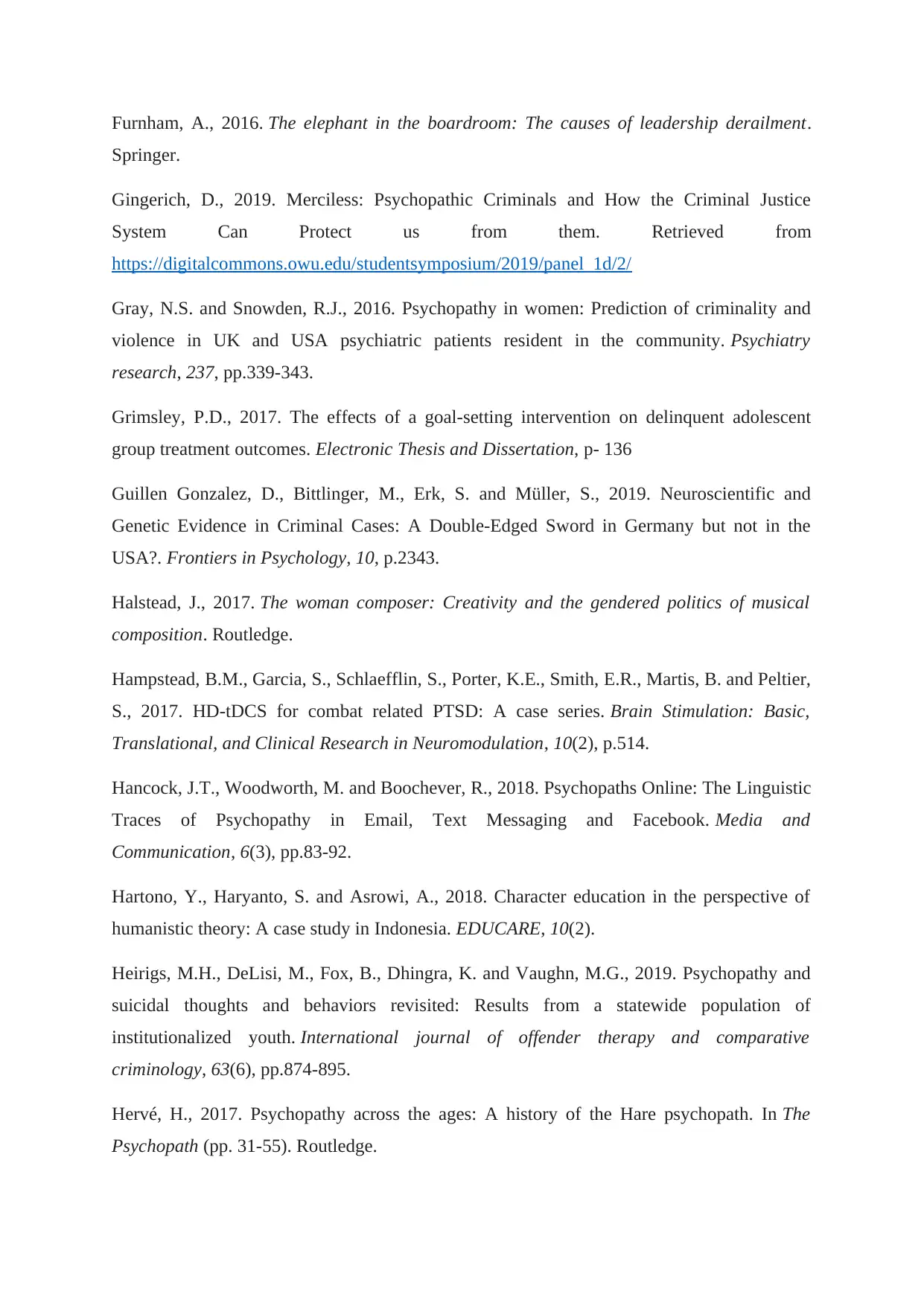
Furnham, A., 2016. The elephant in the boardroom: The causes of leadership derailment.
Springer.
Gingerich, D., 2019. Merciless: Psychopathic Criminals and How the Criminal Justice
System Can Protect us from them. Retrieved from
https://digitalcommons.owu.edu/studentsymposium/2019/panel_1d/2/
Gray, N.S. and Snowden, R.J., 2016. Psychopathy in women: Prediction of criminality and
violence in UK and USA psychiatric patients resident in the community. Psychiatry
research, 237, pp.339-343.
Grimsley, P.D., 2017. The effects of a goal-setting intervention on delinquent adolescent
group treatment outcomes. Electronic Thesis and Dissertation, p- 136
Guillen Gonzalez, D., Bittlinger, M., Erk, S. and Müller, S., 2019. Neuroscientific and
Genetic Evidence in Criminal Cases: A Double-Edged Sword in Germany but not in the
USA?. Frontiers in Psychology, 10, p.2343.
Halstead, J., 2017. The woman composer: Creativity and the gendered politics of musical
composition. Routledge.
Hampstead, B.M., Garcia, S., Schlaefflin, S., Porter, K.E., Smith, E.R., Martis, B. and Peltier,
S., 2017. HD-tDCS for combat related PTSD: A case series. Brain Stimulation: Basic,
Translational, and Clinical Research in Neuromodulation, 10(2), p.514.
Hancock, J.T., Woodworth, M. and Boochever, R., 2018. Psychopaths Online: The Linguistic
Traces of Psychopathy in Email, Text Messaging and Facebook. Media and
Communication, 6(3), pp.83-92.
Hartono, Y., Haryanto, S. and Asrowi, A., 2018. Character education in the perspective of
humanistic theory: A case study in Indonesia. EDUCARE, 10(2).
Heirigs, M.H., DeLisi, M., Fox, B., Dhingra, K. and Vaughn, M.G., 2019. Psychopathy and
suicidal thoughts and behaviors revisited: Results from a statewide population of
institutionalized youth. International journal of offender therapy and comparative
criminology, 63(6), pp.874-895.
Hervé, H., 2017. Psychopathy across the ages: A history of the Hare psychopath. In The
Psychopath (pp. 31-55). Routledge.
Springer.
Gingerich, D., 2019. Merciless: Psychopathic Criminals and How the Criminal Justice
System Can Protect us from them. Retrieved from
https://digitalcommons.owu.edu/studentsymposium/2019/panel_1d/2/
Gray, N.S. and Snowden, R.J., 2016. Psychopathy in women: Prediction of criminality and
violence in UK and USA psychiatric patients resident in the community. Psychiatry
research, 237, pp.339-343.
Grimsley, P.D., 2017. The effects of a goal-setting intervention on delinquent adolescent
group treatment outcomes. Electronic Thesis and Dissertation, p- 136
Guillen Gonzalez, D., Bittlinger, M., Erk, S. and Müller, S., 2019. Neuroscientific and
Genetic Evidence in Criminal Cases: A Double-Edged Sword in Germany but not in the
USA?. Frontiers in Psychology, 10, p.2343.
Halstead, J., 2017. The woman composer: Creativity and the gendered politics of musical
composition. Routledge.
Hampstead, B.M., Garcia, S., Schlaefflin, S., Porter, K.E., Smith, E.R., Martis, B. and Peltier,
S., 2017. HD-tDCS for combat related PTSD: A case series. Brain Stimulation: Basic,
Translational, and Clinical Research in Neuromodulation, 10(2), p.514.
Hancock, J.T., Woodworth, M. and Boochever, R., 2018. Psychopaths Online: The Linguistic
Traces of Psychopathy in Email, Text Messaging and Facebook. Media and
Communication, 6(3), pp.83-92.
Hartono, Y., Haryanto, S. and Asrowi, A., 2018. Character education in the perspective of
humanistic theory: A case study in Indonesia. EDUCARE, 10(2).
Heirigs, M.H., DeLisi, M., Fox, B., Dhingra, K. and Vaughn, M.G., 2019. Psychopathy and
suicidal thoughts and behaviors revisited: Results from a statewide population of
institutionalized youth. International journal of offender therapy and comparative
criminology, 63(6), pp.874-895.
Hervé, H., 2017. Psychopathy across the ages: A history of the Hare psychopath. In The
Psychopath (pp. 31-55). Routledge.
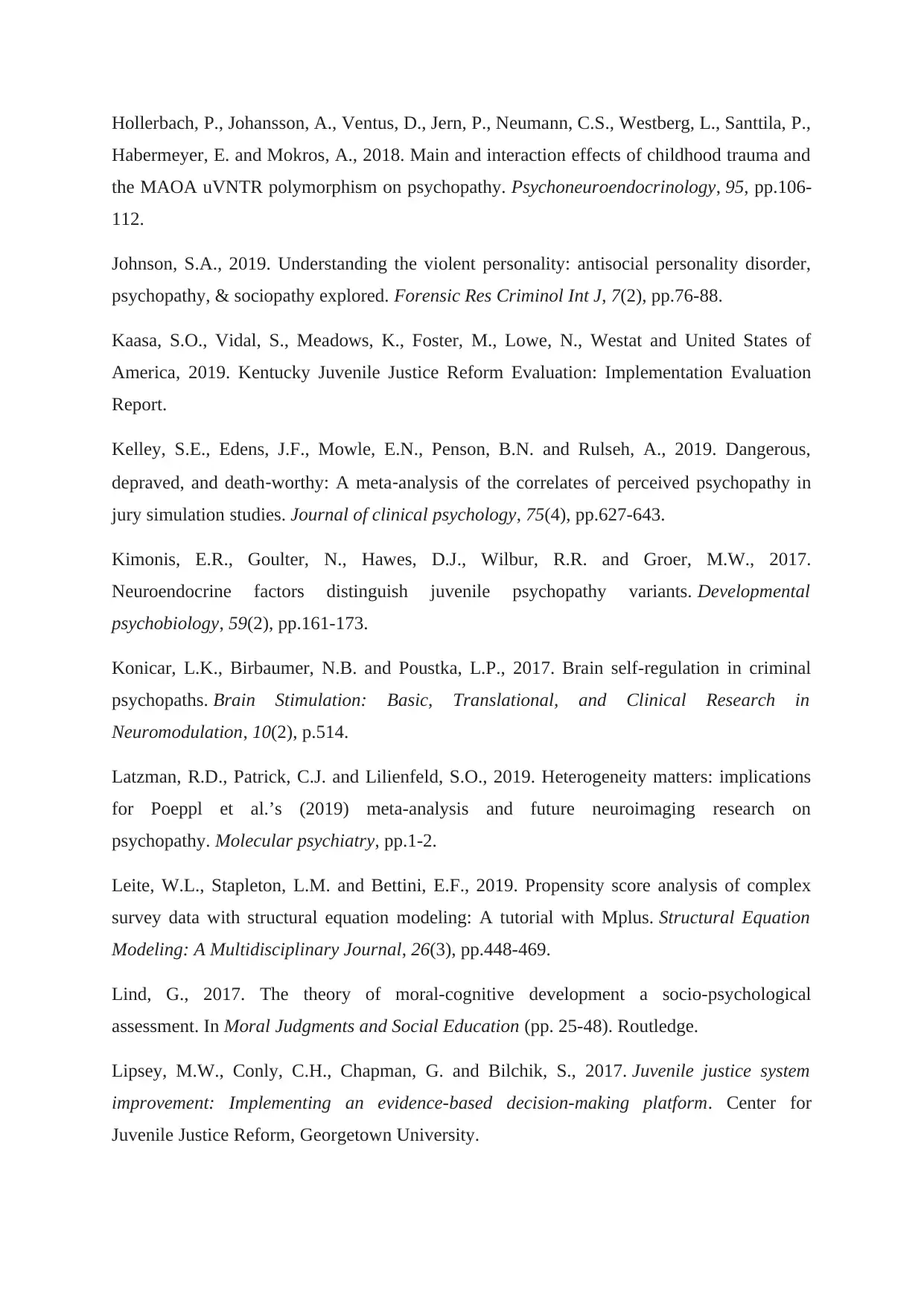
Hollerbach, P., Johansson, A., Ventus, D., Jern, P., Neumann, C.S., Westberg, L., Santtila, P.,
Habermeyer, E. and Mokros, A., 2018. Main and interaction effects of childhood trauma and
the MAOA uVNTR polymorphism on psychopathy. Psychoneuroendocrinology, 95, pp.106-
112.
Johnson, S.A., 2019. Understanding the violent personality: antisocial personality disorder,
psychopathy, & sociopathy explored. Forensic Res Criminol Int J, 7(2), pp.76-88.
Kaasa, S.O., Vidal, S., Meadows, K., Foster, M., Lowe, N., Westat and United States of
America, 2019. Kentucky Juvenile Justice Reform Evaluation: Implementation Evaluation
Report.
Kelley, S.E., Edens, J.F., Mowle, E.N., Penson, B.N. and Rulseh, A., 2019. Dangerous,
depraved, and death‐worthy: A meta‐analysis of the correlates of perceived psychopathy in
jury simulation studies. Journal of clinical psychology, 75(4), pp.627-643.
Kimonis, E.R., Goulter, N., Hawes, D.J., Wilbur, R.R. and Groer, M.W., 2017.
Neuroendocrine factors distinguish juvenile psychopathy variants. Developmental
psychobiology, 59(2), pp.161-173.
Konicar, L.K., Birbaumer, N.B. and Poustka, L.P., 2017. Brain self-regulation in criminal
psychopaths. Brain Stimulation: Basic, Translational, and Clinical Research in
Neuromodulation, 10(2), p.514.
Latzman, R.D., Patrick, C.J. and Lilienfeld, S.O., 2019. Heterogeneity matters: implications
for Poeppl et al.’s (2019) meta-analysis and future neuroimaging research on
psychopathy. Molecular psychiatry, pp.1-2.
Leite, W.L., Stapleton, L.M. and Bettini, E.F., 2019. Propensity score analysis of complex
survey data with structural equation modeling: A tutorial with Mplus. Structural Equation
Modeling: A Multidisciplinary Journal, 26(3), pp.448-469.
Lind, G., 2017. The theory of moral-cognitive development a socio-psychological
assessment. In Moral Judgments and Social Education (pp. 25-48). Routledge.
Lipsey, M.W., Conly, C.H., Chapman, G. and Bilchik, S., 2017. Juvenile justice system
improvement: Implementing an evidence-based decision-making platform. Center for
Juvenile Justice Reform, Georgetown University.
Habermeyer, E. and Mokros, A., 2018. Main and interaction effects of childhood trauma and
the MAOA uVNTR polymorphism on psychopathy. Psychoneuroendocrinology, 95, pp.106-
112.
Johnson, S.A., 2019. Understanding the violent personality: antisocial personality disorder,
psychopathy, & sociopathy explored. Forensic Res Criminol Int J, 7(2), pp.76-88.
Kaasa, S.O., Vidal, S., Meadows, K., Foster, M., Lowe, N., Westat and United States of
America, 2019. Kentucky Juvenile Justice Reform Evaluation: Implementation Evaluation
Report.
Kelley, S.E., Edens, J.F., Mowle, E.N., Penson, B.N. and Rulseh, A., 2019. Dangerous,
depraved, and death‐worthy: A meta‐analysis of the correlates of perceived psychopathy in
jury simulation studies. Journal of clinical psychology, 75(4), pp.627-643.
Kimonis, E.R., Goulter, N., Hawes, D.J., Wilbur, R.R. and Groer, M.W., 2017.
Neuroendocrine factors distinguish juvenile psychopathy variants. Developmental
psychobiology, 59(2), pp.161-173.
Konicar, L.K., Birbaumer, N.B. and Poustka, L.P., 2017. Brain self-regulation in criminal
psychopaths. Brain Stimulation: Basic, Translational, and Clinical Research in
Neuromodulation, 10(2), p.514.
Latzman, R.D., Patrick, C.J. and Lilienfeld, S.O., 2019. Heterogeneity matters: implications
for Poeppl et al.’s (2019) meta-analysis and future neuroimaging research on
psychopathy. Molecular psychiatry, pp.1-2.
Leite, W.L., Stapleton, L.M. and Bettini, E.F., 2019. Propensity score analysis of complex
survey data with structural equation modeling: A tutorial with Mplus. Structural Equation
Modeling: A Multidisciplinary Journal, 26(3), pp.448-469.
Lind, G., 2017. The theory of moral-cognitive development a socio-psychological
assessment. In Moral Judgments and Social Education (pp. 25-48). Routledge.
Lipsey, M.W., Conly, C.H., Chapman, G. and Bilchik, S., 2017. Juvenile justice system
improvement: Implementing an evidence-based decision-making platform. Center for
Juvenile Justice Reform, Georgetown University.
Paraphrase This Document
Need a fresh take? Get an instant paraphrase of this document with our AI Paraphraser
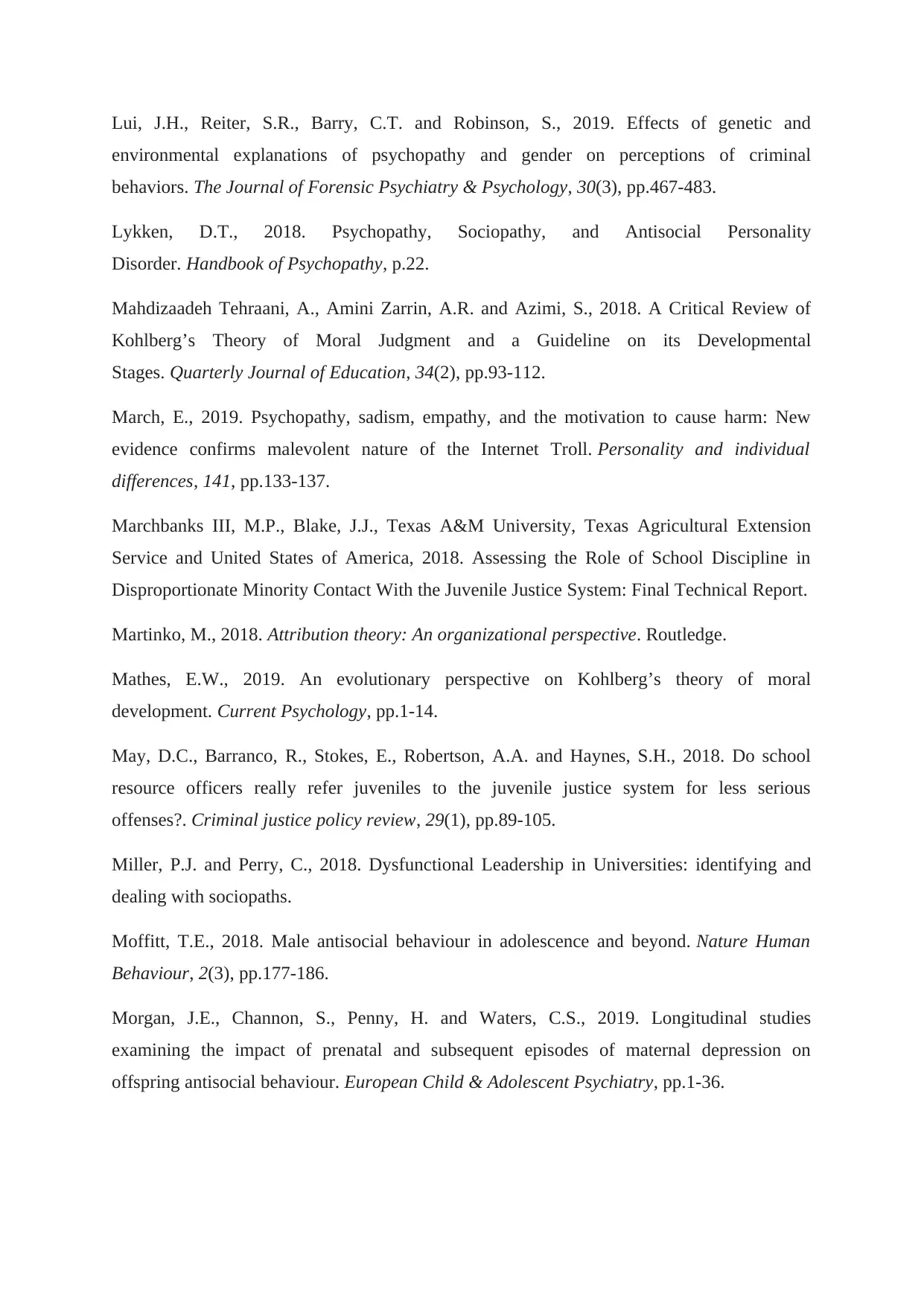
Lui, J.H., Reiter, S.R., Barry, C.T. and Robinson, S., 2019. Effects of genetic and
environmental explanations of psychopathy and gender on perceptions of criminal
behaviors. The Journal of Forensic Psychiatry & Psychology, 30(3), pp.467-483.
Lykken, D.T., 2018. Psychopathy, Sociopathy, and Antisocial Personality
Disorder. Handbook of Psychopathy, p.22.
Mahdizaadeh Tehraani, A., Amini Zarrin, A.R. and Azimi, S., 2018. A Critical Review of
Kohlberg’s Theory of Moral Judgment and a Guideline on its Developmental
Stages. Quarterly Journal of Education, 34(2), pp.93-112.
March, E., 2019. Psychopathy, sadism, empathy, and the motivation to cause harm: New
evidence confirms malevolent nature of the Internet Troll. Personality and individual
differences, 141, pp.133-137.
Marchbanks III, M.P., Blake, J.J., Texas A&M University, Texas Agricultural Extension
Service and United States of America, 2018. Assessing the Role of School Discipline in
Disproportionate Minority Contact With the Juvenile Justice System: Final Technical Report.
Martinko, M., 2018. Attribution theory: An organizational perspective. Routledge.
Mathes, E.W., 2019. An evolutionary perspective on Kohlberg’s theory of moral
development. Current Psychology, pp.1-14.
May, D.C., Barranco, R., Stokes, E., Robertson, A.A. and Haynes, S.H., 2018. Do school
resource officers really refer juveniles to the juvenile justice system for less serious
offenses?. Criminal justice policy review, 29(1), pp.89-105.
Miller, P.J. and Perry, C., 2018. Dysfunctional Leadership in Universities: identifying and
dealing with sociopaths.
Moffitt, T.E., 2018. Male antisocial behaviour in adolescence and beyond. Nature Human
Behaviour, 2(3), pp.177-186.
Morgan, J.E., Channon, S., Penny, H. and Waters, C.S., 2019. Longitudinal studies
examining the impact of prenatal and subsequent episodes of maternal depression on
offspring antisocial behaviour. European Child & Adolescent Psychiatry, pp.1-36.
environmental explanations of psychopathy and gender on perceptions of criminal
behaviors. The Journal of Forensic Psychiatry & Psychology, 30(3), pp.467-483.
Lykken, D.T., 2018. Psychopathy, Sociopathy, and Antisocial Personality
Disorder. Handbook of Psychopathy, p.22.
Mahdizaadeh Tehraani, A., Amini Zarrin, A.R. and Azimi, S., 2018. A Critical Review of
Kohlberg’s Theory of Moral Judgment and a Guideline on its Developmental
Stages. Quarterly Journal of Education, 34(2), pp.93-112.
March, E., 2019. Psychopathy, sadism, empathy, and the motivation to cause harm: New
evidence confirms malevolent nature of the Internet Troll. Personality and individual
differences, 141, pp.133-137.
Marchbanks III, M.P., Blake, J.J., Texas A&M University, Texas Agricultural Extension
Service and United States of America, 2018. Assessing the Role of School Discipline in
Disproportionate Minority Contact With the Juvenile Justice System: Final Technical Report.
Martinko, M., 2018. Attribution theory: An organizational perspective. Routledge.
Mathes, E.W., 2019. An evolutionary perspective on Kohlberg’s theory of moral
development. Current Psychology, pp.1-14.
May, D.C., Barranco, R., Stokes, E., Robertson, A.A. and Haynes, S.H., 2018. Do school
resource officers really refer juveniles to the juvenile justice system for less serious
offenses?. Criminal justice policy review, 29(1), pp.89-105.
Miller, P.J. and Perry, C., 2018. Dysfunctional Leadership in Universities: identifying and
dealing with sociopaths.
Moffitt, T.E., 2018. Male antisocial behaviour in adolescence and beyond. Nature Human
Behaviour, 2(3), pp.177-186.
Morgan, J.E., Channon, S., Penny, H. and Waters, C.S., 2019. Longitudinal studies
examining the impact of prenatal and subsequent episodes of maternal depression on
offspring antisocial behaviour. European Child & Adolescent Psychiatry, pp.1-36.
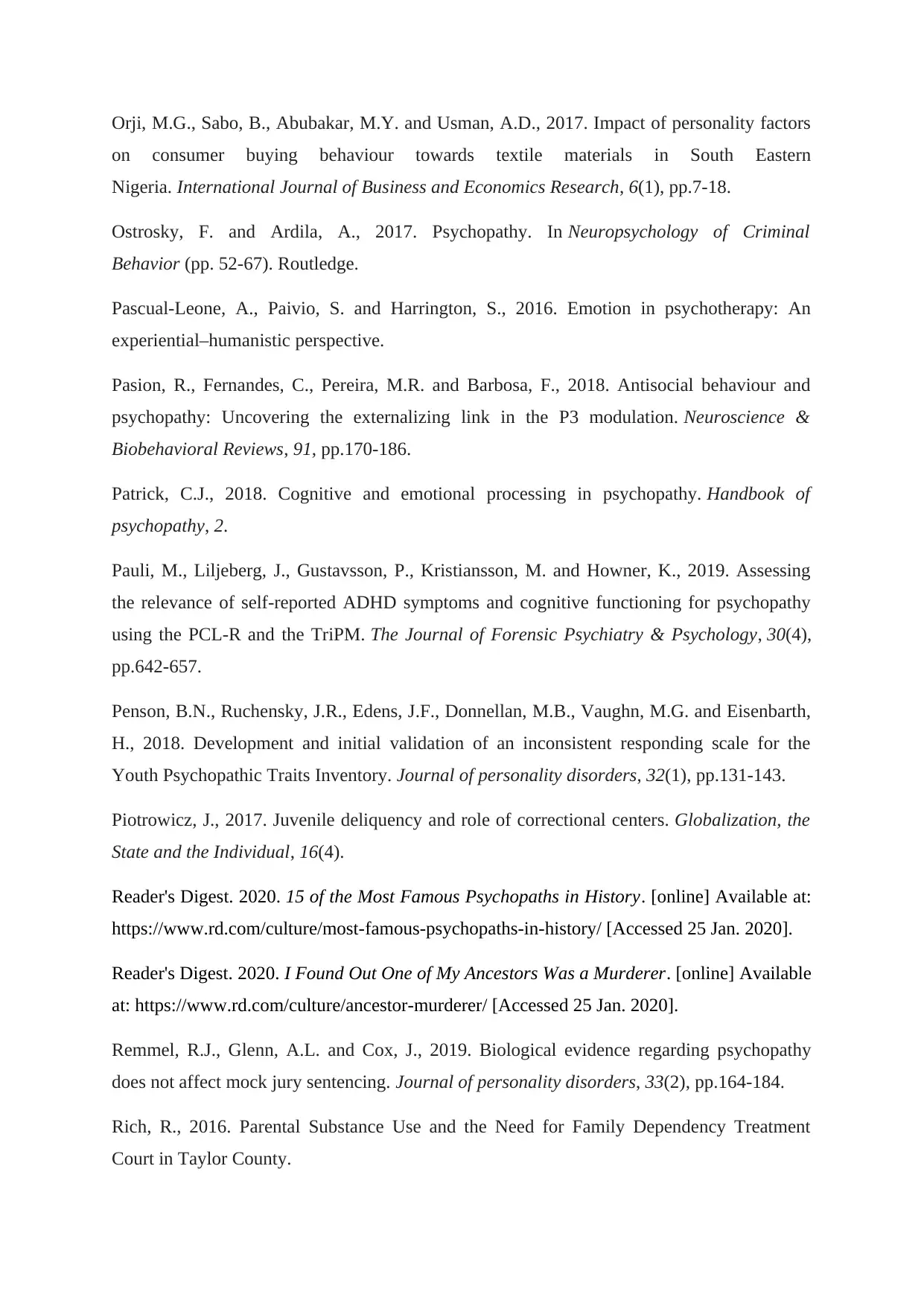
Orji, M.G., Sabo, B., Abubakar, M.Y. and Usman, A.D., 2017. Impact of personality factors
on consumer buying behaviour towards textile materials in South Eastern
Nigeria. International Journal of Business and Economics Research, 6(1), pp.7-18.
Ostrosky, F. and Ardila, A., 2017. Psychopathy. In Neuropsychology of Criminal
Behavior (pp. 52-67). Routledge.
Pascual-Leone, A., Paivio, S. and Harrington, S., 2016. Emotion in psychotherapy: An
experiential–humanistic perspective.
Pasion, R., Fernandes, C., Pereira, M.R. and Barbosa, F., 2018. Antisocial behaviour and
psychopathy: Uncovering the externalizing link in the P3 modulation. Neuroscience &
Biobehavioral Reviews, 91, pp.170-186.
Patrick, C.J., 2018. Cognitive and emotional processing in psychopathy. Handbook of
psychopathy, 2.
Pauli, M., Liljeberg, J., Gustavsson, P., Kristiansson, M. and Howner, K., 2019. Assessing
the relevance of self-reported ADHD symptoms and cognitive functioning for psychopathy
using the PCL-R and the TriPM. The Journal of Forensic Psychiatry & Psychology, 30(4),
pp.642-657.
Penson, B.N., Ruchensky, J.R., Edens, J.F., Donnellan, M.B., Vaughn, M.G. and Eisenbarth,
H., 2018. Development and initial validation of an inconsistent responding scale for the
Youth Psychopathic Traits Inventory. Journal of personality disorders, 32(1), pp.131-143.
Piotrowicz, J., 2017. Juvenile deliquency and role of correctional centers. Globalization, the
State and the Individual, 16(4).
Reader's Digest. 2020. 15 of the Most Famous Psychopaths in History. [online] Available at:
https://www.rd.com/culture/most-famous-psychopaths-in-history/ [Accessed 25 Jan. 2020].
Reader's Digest. 2020. I Found Out One of My Ancestors Was a Murderer. [online] Available
at: https://www.rd.com/culture/ancestor-murderer/ [Accessed 25 Jan. 2020].
Remmel, R.J., Glenn, A.L. and Cox, J., 2019. Biological evidence regarding psychopathy
does not affect mock jury sentencing. Journal of personality disorders, 33(2), pp.164-184.
Rich, R., 2016. Parental Substance Use and the Need for Family Dependency Treatment
Court in Taylor County.
on consumer buying behaviour towards textile materials in South Eastern
Nigeria. International Journal of Business and Economics Research, 6(1), pp.7-18.
Ostrosky, F. and Ardila, A., 2017. Psychopathy. In Neuropsychology of Criminal
Behavior (pp. 52-67). Routledge.
Pascual-Leone, A., Paivio, S. and Harrington, S., 2016. Emotion in psychotherapy: An
experiential–humanistic perspective.
Pasion, R., Fernandes, C., Pereira, M.R. and Barbosa, F., 2018. Antisocial behaviour and
psychopathy: Uncovering the externalizing link in the P3 modulation. Neuroscience &
Biobehavioral Reviews, 91, pp.170-186.
Patrick, C.J., 2018. Cognitive and emotional processing in psychopathy. Handbook of
psychopathy, 2.
Pauli, M., Liljeberg, J., Gustavsson, P., Kristiansson, M. and Howner, K., 2019. Assessing
the relevance of self-reported ADHD symptoms and cognitive functioning for psychopathy
using the PCL-R and the TriPM. The Journal of Forensic Psychiatry & Psychology, 30(4),
pp.642-657.
Penson, B.N., Ruchensky, J.R., Edens, J.F., Donnellan, M.B., Vaughn, M.G. and Eisenbarth,
H., 2018. Development and initial validation of an inconsistent responding scale for the
Youth Psychopathic Traits Inventory. Journal of personality disorders, 32(1), pp.131-143.
Piotrowicz, J., 2017. Juvenile deliquency and role of correctional centers. Globalization, the
State and the Individual, 16(4).
Reader's Digest. 2020. 15 of the Most Famous Psychopaths in History. [online] Available at:
https://www.rd.com/culture/most-famous-psychopaths-in-history/ [Accessed 25 Jan. 2020].
Reader's Digest. 2020. I Found Out One of My Ancestors Was a Murderer. [online] Available
at: https://www.rd.com/culture/ancestor-murderer/ [Accessed 25 Jan. 2020].
Remmel, R.J., Glenn, A.L. and Cox, J., 2019. Biological evidence regarding psychopathy
does not affect mock jury sentencing. Journal of personality disorders, 33(2), pp.164-184.
Rich, R., 2016. Parental Substance Use and the Need for Family Dependency Treatment
Court in Taylor County.
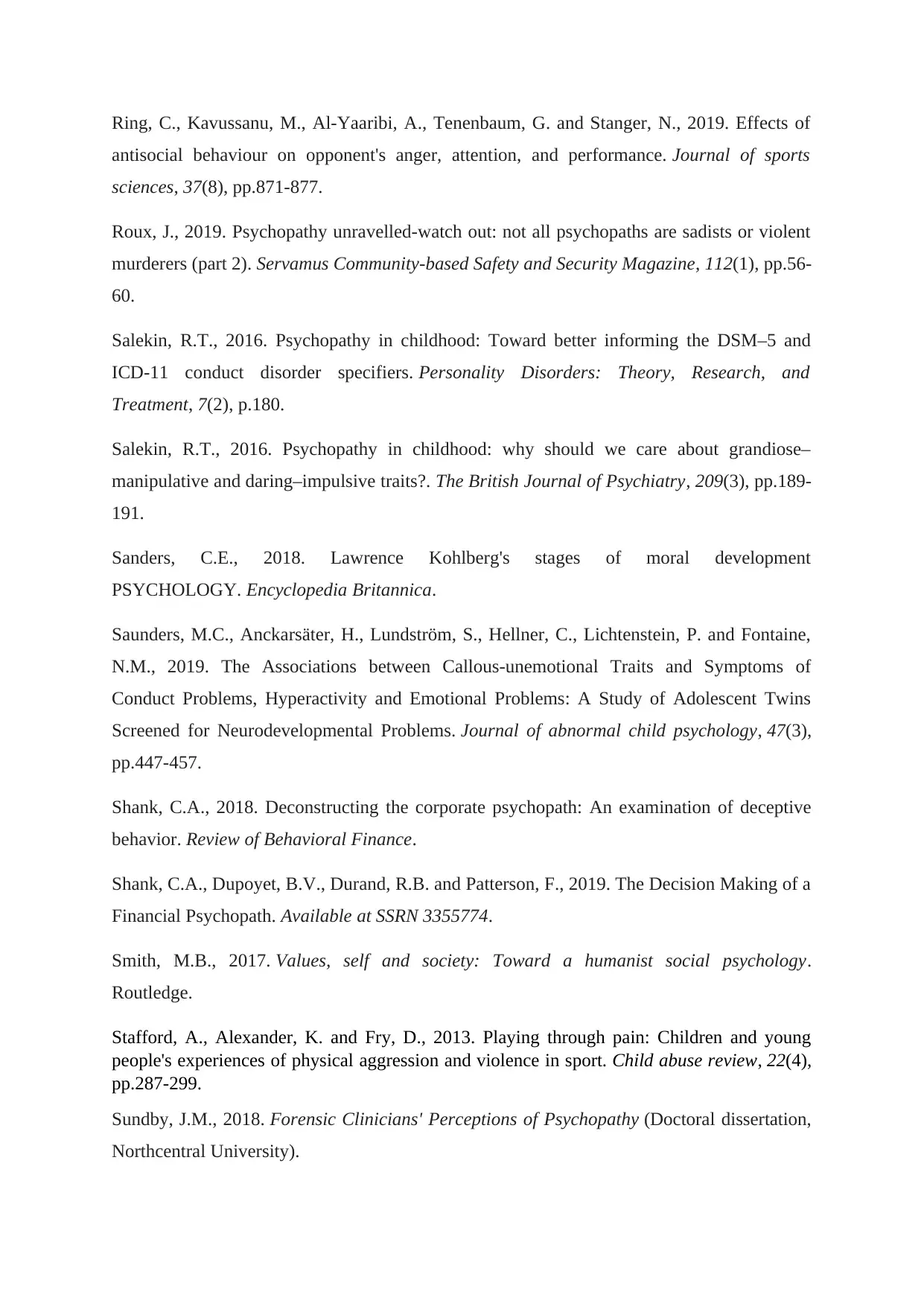
Ring, C., Kavussanu, M., Al-Yaaribi, A., Tenenbaum, G. and Stanger, N., 2019. Effects of
antisocial behaviour on opponent's anger, attention, and performance. Journal of sports
sciences, 37(8), pp.871-877.
Roux, J., 2019. Psychopathy unravelled-watch out: not all psychopaths are sadists or violent
murderers (part 2). Servamus Community-based Safety and Security Magazine, 112(1), pp.56-
60.
Salekin, R.T., 2016. Psychopathy in childhood: Toward better informing the DSM–5 and
ICD-11 conduct disorder specifiers. Personality Disorders: Theory, Research, and
Treatment, 7(2), p.180.
Salekin, R.T., 2016. Psychopathy in childhood: why should we care about grandiose–
manipulative and daring–impulsive traits?. The British Journal of Psychiatry, 209(3), pp.189-
191.
Sanders, C.E., 2018. Lawrence Kohlberg's stages of moral development
PSYCHOLOGY. Encyclopedia Britannica.
Saunders, M.C., Anckarsäter, H., Lundström, S., Hellner, C., Lichtenstein, P. and Fontaine,
N.M., 2019. The Associations between Callous-unemotional Traits and Symptoms of
Conduct Problems, Hyperactivity and Emotional Problems: A Study of Adolescent Twins
Screened for Neurodevelopmental Problems. Journal of abnormal child psychology, 47(3),
pp.447-457.
Shank, C.A., 2018. Deconstructing the corporate psychopath: An examination of deceptive
behavior. Review of Behavioral Finance.
Shank, C.A., Dupoyet, B.V., Durand, R.B. and Patterson, F., 2019. The Decision Making of a
Financial Psychopath. Available at SSRN 3355774.
Smith, M.B., 2017. Values, self and society: Toward a humanist social psychology.
Routledge.
Stafford, A., Alexander, K. and Fry, D., 2013. Playing through pain: Children and young
people's experiences of physical aggression and violence in sport. Child abuse review, 22(4),
pp.287-299.
Sundby, J.M., 2018. Forensic Clinicians' Perceptions of Psychopathy (Doctoral dissertation,
Northcentral University).
antisocial behaviour on opponent's anger, attention, and performance. Journal of sports
sciences, 37(8), pp.871-877.
Roux, J., 2019. Psychopathy unravelled-watch out: not all psychopaths are sadists or violent
murderers (part 2). Servamus Community-based Safety and Security Magazine, 112(1), pp.56-
60.
Salekin, R.T., 2016. Psychopathy in childhood: Toward better informing the DSM–5 and
ICD-11 conduct disorder specifiers. Personality Disorders: Theory, Research, and
Treatment, 7(2), p.180.
Salekin, R.T., 2016. Psychopathy in childhood: why should we care about grandiose–
manipulative and daring–impulsive traits?. The British Journal of Psychiatry, 209(3), pp.189-
191.
Sanders, C.E., 2018. Lawrence Kohlberg's stages of moral development
PSYCHOLOGY. Encyclopedia Britannica.
Saunders, M.C., Anckarsäter, H., Lundström, S., Hellner, C., Lichtenstein, P. and Fontaine,
N.M., 2019. The Associations between Callous-unemotional Traits and Symptoms of
Conduct Problems, Hyperactivity and Emotional Problems: A Study of Adolescent Twins
Screened for Neurodevelopmental Problems. Journal of abnormal child psychology, 47(3),
pp.447-457.
Shank, C.A., 2018. Deconstructing the corporate psychopath: An examination of deceptive
behavior. Review of Behavioral Finance.
Shank, C.A., Dupoyet, B.V., Durand, R.B. and Patterson, F., 2019. The Decision Making of a
Financial Psychopath. Available at SSRN 3355774.
Smith, M.B., 2017. Values, self and society: Toward a humanist social psychology.
Routledge.
Stafford, A., Alexander, K. and Fry, D., 2013. Playing through pain: Children and young
people's experiences of physical aggression and violence in sport. Child abuse review, 22(4),
pp.287-299.
Sundby, J.M., 2018. Forensic Clinicians' Perceptions of Psychopathy (Doctoral dissertation,
Northcentral University).
Secure Best Marks with AI Grader
Need help grading? Try our AI Grader for instant feedback on your assignments.
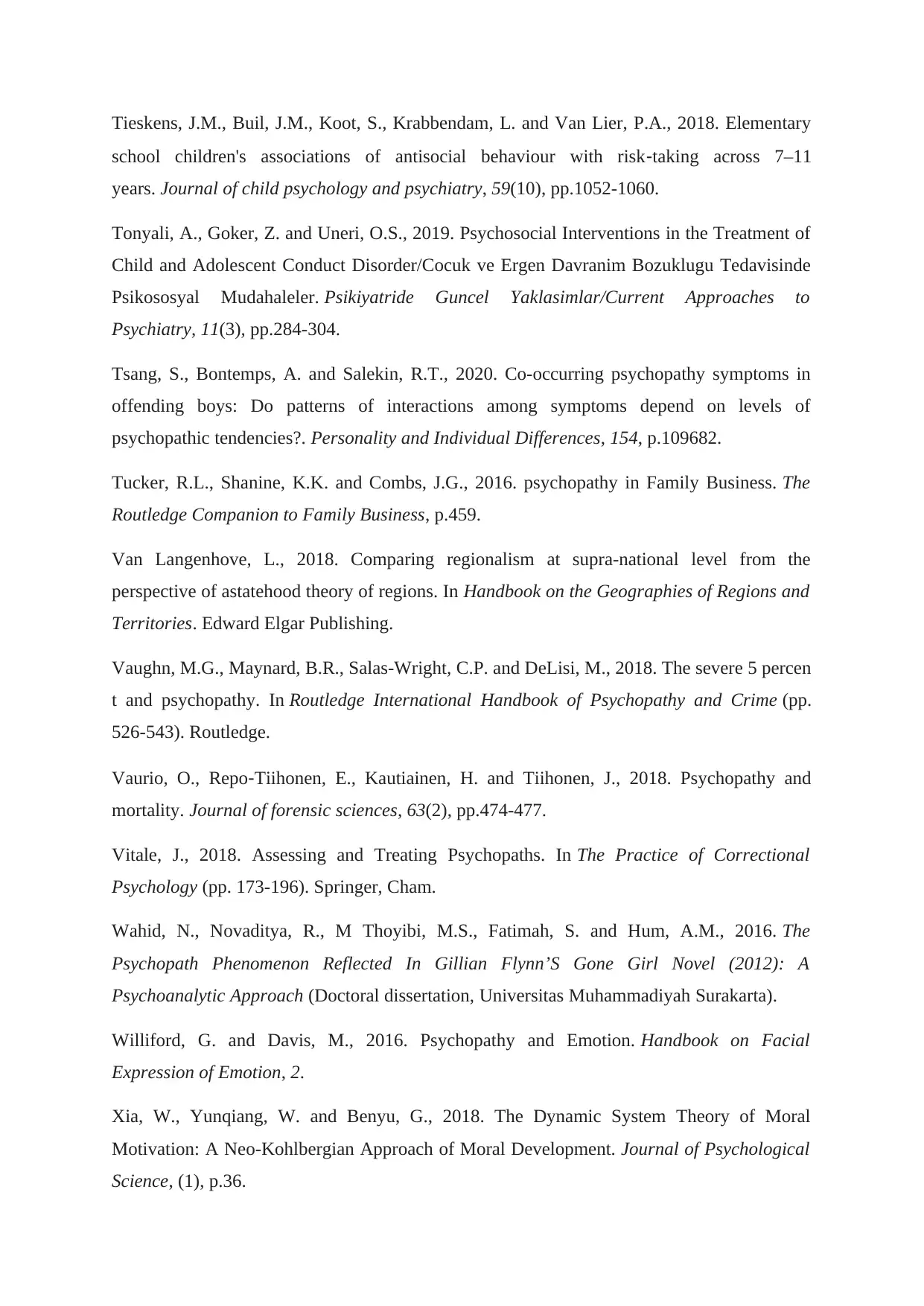
Tieskens, J.M., Buil, J.M., Koot, S., Krabbendam, L. and Van Lier, P.A., 2018. Elementary
school children's associations of antisocial behaviour with risk‐taking across 7–11
years. Journal of child psychology and psychiatry, 59(10), pp.1052-1060.
Tonyali, A., Goker, Z. and Uneri, O.S., 2019. Psychosocial Interventions in the Treatment of
Child and Adolescent Conduct Disorder/Cocuk ve Ergen Davranim Bozuklugu Tedavisinde
Psikososyal Mudahaleler. Psikiyatride Guncel Yaklasimlar/Current Approaches to
Psychiatry, 11(3), pp.284-304.
Tsang, S., Bontemps, A. and Salekin, R.T., 2020. Co-occurring psychopathy symptoms in
offending boys: Do patterns of interactions among symptoms depend on levels of
psychopathic tendencies?. Personality and Individual Differences, 154, p.109682.
Tucker, R.L., Shanine, K.K. and Combs, J.G., 2016. psychopathy in Family Business. The
Routledge Companion to Family Business, p.459.
Van Langenhove, L., 2018. Comparing regionalism at supra-national level from the
perspective of astatehood theory of regions. In Handbook on the Geographies of Regions and
Territories. Edward Elgar Publishing.
Vaughn, M.G., Maynard, B.R., Salas-Wright, C.P. and DeLisi, M., 2018. The severe 5 percen
t and psychopathy. In Routledge International Handbook of Psychopathy and Crime (pp.
526-543). Routledge.
Vaurio, O., Repo‐Tiihonen, E., Kautiainen, H. and Tiihonen, J., 2018. Psychopathy and
mortality. Journal of forensic sciences, 63(2), pp.474-477.
Vitale, J., 2018. Assessing and Treating Psychopaths. In The Practice of Correctional
Psychology (pp. 173-196). Springer, Cham.
Wahid, N., Novaditya, R., M Thoyibi, M.S., Fatimah, S. and Hum, A.M., 2016. The
Psychopath Phenomenon Reflected In Gillian Flynn’S Gone Girl Novel (2012): A
Psychoanalytic Approach (Doctoral dissertation, Universitas Muhammadiyah Surakarta).
Williford, G. and Davis, M., 2016. Psychopathy and Emotion. Handbook on Facial
Expression of Emotion, 2.
Xia, W., Yunqiang, W. and Benyu, G., 2018. The Dynamic System Theory of Moral
Motivation: A Neo-Kohlbergian Approach of Moral Development. Journal of Psychological
Science, (1), p.36.
school children's associations of antisocial behaviour with risk‐taking across 7–11
years. Journal of child psychology and psychiatry, 59(10), pp.1052-1060.
Tonyali, A., Goker, Z. and Uneri, O.S., 2019. Psychosocial Interventions in the Treatment of
Child and Adolescent Conduct Disorder/Cocuk ve Ergen Davranim Bozuklugu Tedavisinde
Psikososyal Mudahaleler. Psikiyatride Guncel Yaklasimlar/Current Approaches to
Psychiatry, 11(3), pp.284-304.
Tsang, S., Bontemps, A. and Salekin, R.T., 2020. Co-occurring psychopathy symptoms in
offending boys: Do patterns of interactions among symptoms depend on levels of
psychopathic tendencies?. Personality and Individual Differences, 154, p.109682.
Tucker, R.L., Shanine, K.K. and Combs, J.G., 2016. psychopathy in Family Business. The
Routledge Companion to Family Business, p.459.
Van Langenhove, L., 2018. Comparing regionalism at supra-national level from the
perspective of astatehood theory of regions. In Handbook on the Geographies of Regions and
Territories. Edward Elgar Publishing.
Vaughn, M.G., Maynard, B.R., Salas-Wright, C.P. and DeLisi, M., 2018. The severe 5 percen
t and psychopathy. In Routledge International Handbook of Psychopathy and Crime (pp.
526-543). Routledge.
Vaurio, O., Repo‐Tiihonen, E., Kautiainen, H. and Tiihonen, J., 2018. Psychopathy and
mortality. Journal of forensic sciences, 63(2), pp.474-477.
Vitale, J., 2018. Assessing and Treating Psychopaths. In The Practice of Correctional
Psychology (pp. 173-196). Springer, Cham.
Wahid, N., Novaditya, R., M Thoyibi, M.S., Fatimah, S. and Hum, A.M., 2016. The
Psychopath Phenomenon Reflected In Gillian Flynn’S Gone Girl Novel (2012): A
Psychoanalytic Approach (Doctoral dissertation, Universitas Muhammadiyah Surakarta).
Williford, G. and Davis, M., 2016. Psychopathy and Emotion. Handbook on Facial
Expression of Emotion, 2.
Xia, W., Yunqiang, W. and Benyu, G., 2018. The Dynamic System Theory of Moral
Motivation: A Neo-Kohlbergian Approach of Moral Development. Journal of Psychological
Science, (1), p.36.
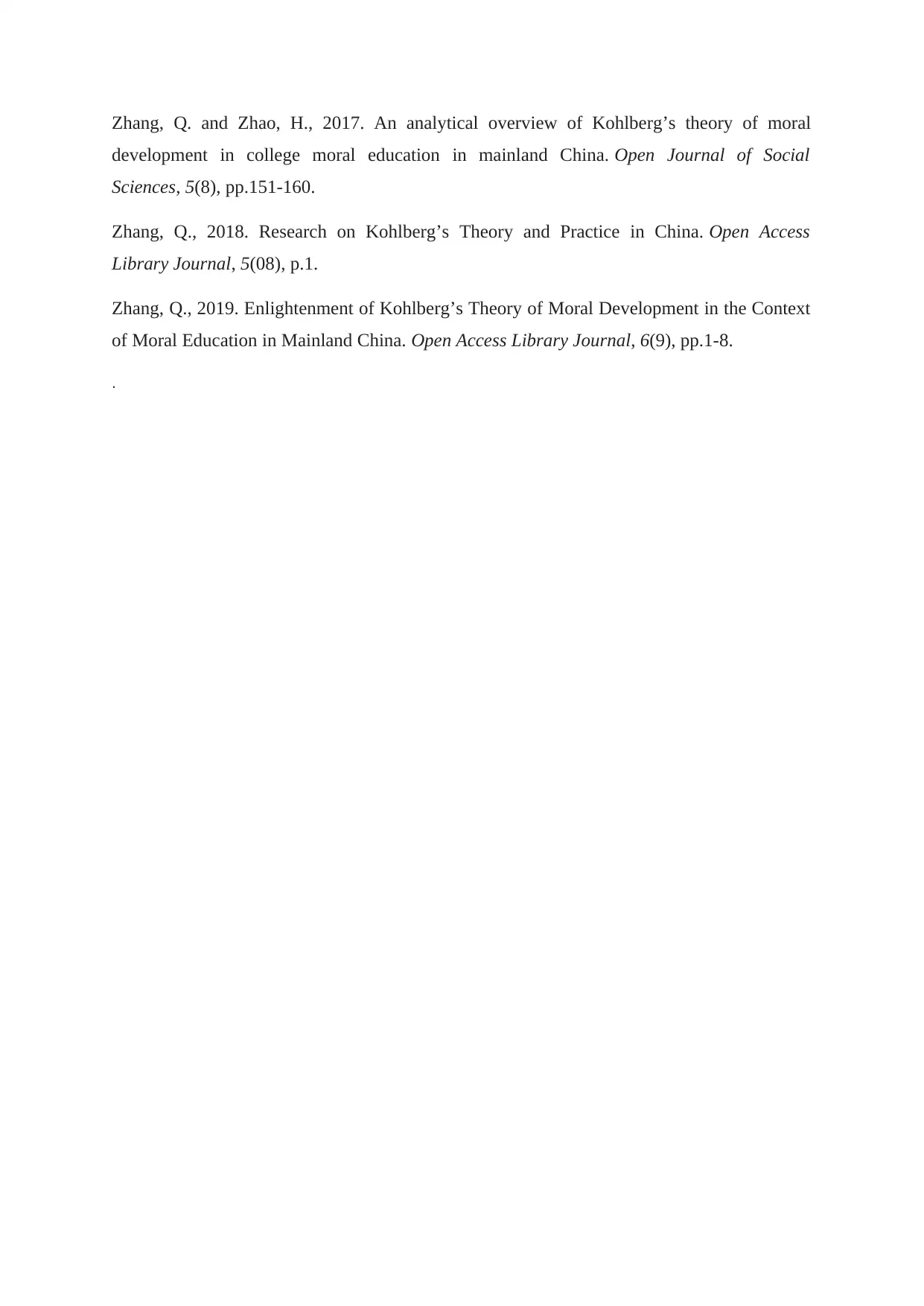
Zhang, Q. and Zhao, H., 2017. An analytical overview of Kohlberg’s theory of moral
development in college moral education in mainland China. Open Journal of Social
Sciences, 5(8), pp.151-160.
Zhang, Q., 2018. Research on Kohlberg’s Theory and Practice in China. Open Access
Library Journal, 5(08), p.1.
Zhang, Q., 2019. Enlightenment of Kohlberg’s Theory of Moral Development in the Context
of Moral Education in Mainland China. Open Access Library Journal, 6(9), pp.1-8.
.
development in college moral education in mainland China. Open Journal of Social
Sciences, 5(8), pp.151-160.
Zhang, Q., 2018. Research on Kohlberg’s Theory and Practice in China. Open Access
Library Journal, 5(08), p.1.
Zhang, Q., 2019. Enlightenment of Kohlberg’s Theory of Moral Development in the Context
of Moral Education in Mainland China. Open Access Library Journal, 6(9), pp.1-8.
.
1 out of 48
Related Documents
Your All-in-One AI-Powered Toolkit for Academic Success.
+13062052269
info@desklib.com
Available 24*7 on WhatsApp / Email
![[object Object]](/_next/static/media/star-bottom.7253800d.svg)
Unlock your academic potential
© 2024 | Zucol Services PVT LTD | All rights reserved.





